Learning Program Review and Improvement
VerifiedAdded on 2020/04/21
|50
|11660
|98
AI Summary
This document presents a review of a learning program designed for the TAEASS401B unit of competency. Two reviewers assessed various aspects of the program, including its structure, delivery mode, evidence gathering techniques, support services, risk control plan, and learning resources. The review highlights areas of strength, such as learner satisfaction with training and successful assessments. However, it also identifies areas for improvement, particularly regarding the comprehensiveness of the risk control plan and potential adjustments to minimum LLN performance ratings. Recommendations are made to address these weaknesses, including providing additional training to struggling learners and further analyzing potential risks.
Contribute Materials
Your contribution can guide someone’s learning journey. Share your
documents today.
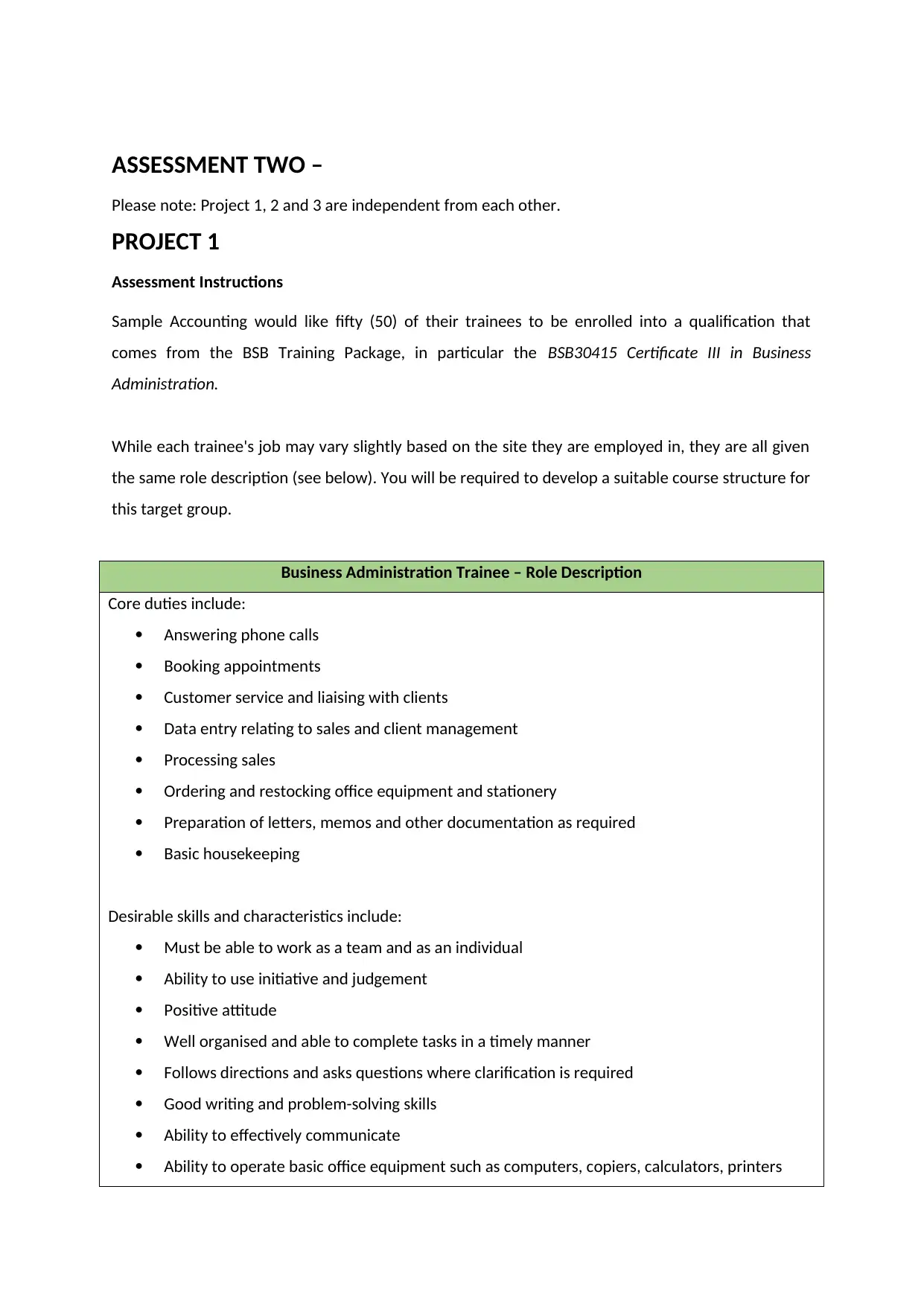
ASSESSMENT TWO –
Please note: Project 1, 2 and 3 are independent from each other.
PROJECT 1
Assessment Instructions
Sample Accounting would like fifty (50) of their trainees to be enrolled into a qualification that
comes from the BSB Training Package, in particular the BSB30415 Certificate III in Business
Administration.
While each trainee's job may vary slightly based on the site they are employed in, they are all given
the same role description (see below). You will be required to develop a suitable course structure for
this target group.
Business Administration Trainee – Role Description
Core duties include:
Answering phone calls
Booking appointments
Customer service and liaising with clients
Data entry relating to sales and client management
Processing sales
Ordering and restocking office equipment and stationery
Preparation of letters, memos and other documentation as required
Basic housekeeping
Desirable skills and characteristics include:
Must be able to work as a team and as an individual
Ability to use initiative and judgement
Positive attitude
Well organised and able to complete tasks in a timely manner
Follows directions and asks questions where clarification is required
Good writing and problem-solving skills
Ability to effectively communicate
Ability to operate basic office equipment such as computers, copiers, calculators, printers
Please note: Project 1, 2 and 3 are independent from each other.
PROJECT 1
Assessment Instructions
Sample Accounting would like fifty (50) of their trainees to be enrolled into a qualification that
comes from the BSB Training Package, in particular the BSB30415 Certificate III in Business
Administration.
While each trainee's job may vary slightly based on the site they are employed in, they are all given
the same role description (see below). You will be required to develop a suitable course structure for
this target group.
Business Administration Trainee – Role Description
Core duties include:
Answering phone calls
Booking appointments
Customer service and liaising with clients
Data entry relating to sales and client management
Processing sales
Ordering and restocking office equipment and stationery
Preparation of letters, memos and other documentation as required
Basic housekeeping
Desirable skills and characteristics include:
Must be able to work as a team and as an individual
Ability to use initiative and judgement
Positive attitude
Well organised and able to complete tasks in a timely manner
Follows directions and asks questions where clarification is required
Good writing and problem-solving skills
Ability to effectively communicate
Ability to operate basic office equipment such as computers, copiers, calculators, printers
Secure Best Marks with AI Grader
Need help grading? Try our AI Grader for instant feedback on your assignments.
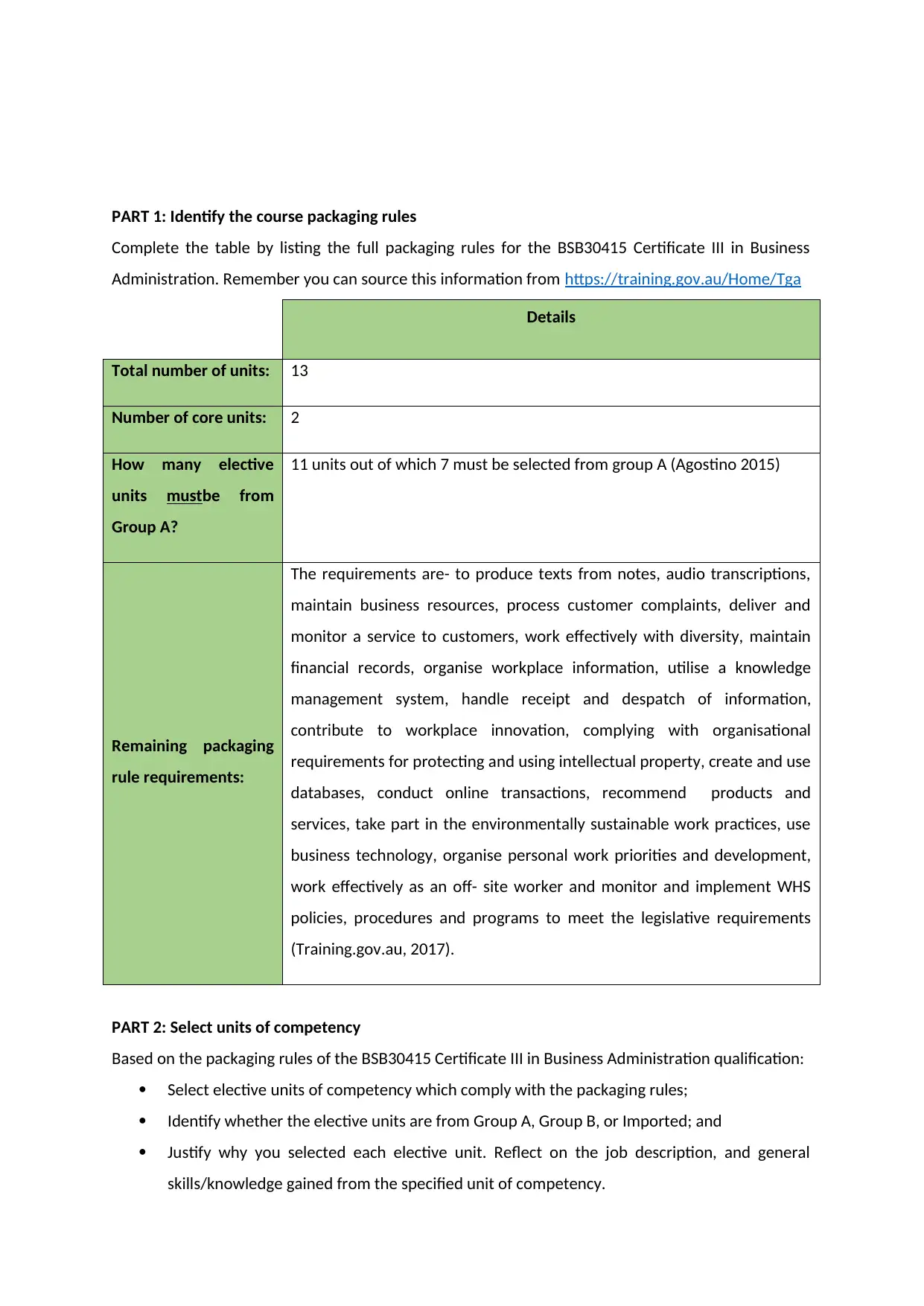
PART 1: Identify the course packaging rules
Complete the table by listing the full packaging rules for the BSB30415 Certificate III in Business
Administration. Remember you can source this information from https://training.gov.au/Home/Tga
Details
Total number of units: 13
Number of core units: 2
How many elective
units mustbe from
Group A?
11 units out of which 7 must be selected from group A (Agostino 2015)
Remaining packaging
rule requirements:
The requirements are- to produce texts from notes, audio transcriptions,
maintain business resources, process customer complaints, deliver and
monitor a service to customers, work effectively with diversity, maintain
financial records, organise workplace information, utilise a knowledge
management system, handle receipt and despatch of information,
contribute to workplace innovation, complying with organisational
requirements for protecting and using intellectual property, create and use
databases, conduct online transactions, recommend products and
services, take part in the environmentally sustainable work practices, use
business technology, organise personal work priorities and development,
work effectively as an off- site worker and monitor and implement WHS
policies, procedures and programs to meet the legislative requirements
(Training.gov.au, 2017).
PART 2: Select units of competency
Based on the packaging rules of the BSB30415 Certificate III in Business Administration qualification:
Select elective units of competency which comply with the packaging rules;
Identify whether the elective units are from Group A, Group B, or Imported; and
Justify why you selected each elective unit. Reflect on the job description, and general
skills/knowledge gained from the specified unit of competency.
Complete the table by listing the full packaging rules for the BSB30415 Certificate III in Business
Administration. Remember you can source this information from https://training.gov.au/Home/Tga
Details
Total number of units: 13
Number of core units: 2
How many elective
units mustbe from
Group A?
11 units out of which 7 must be selected from group A (Agostino 2015)
Remaining packaging
rule requirements:
The requirements are- to produce texts from notes, audio transcriptions,
maintain business resources, process customer complaints, deliver and
monitor a service to customers, work effectively with diversity, maintain
financial records, organise workplace information, utilise a knowledge
management system, handle receipt and despatch of information,
contribute to workplace innovation, complying with organisational
requirements for protecting and using intellectual property, create and use
databases, conduct online transactions, recommend products and
services, take part in the environmentally sustainable work practices, use
business technology, organise personal work priorities and development,
work effectively as an off- site worker and monitor and implement WHS
policies, procedures and programs to meet the legislative requirements
(Training.gov.au, 2017).
PART 2: Select units of competency
Based on the packaging rules of the BSB30415 Certificate III in Business Administration qualification:
Select elective units of competency which comply with the packaging rules;
Identify whether the elective units are from Group A, Group B, or Imported; and
Justify why you selected each elective unit. Reflect on the job description, and general
skills/knowledge gained from the specified unit of competency.
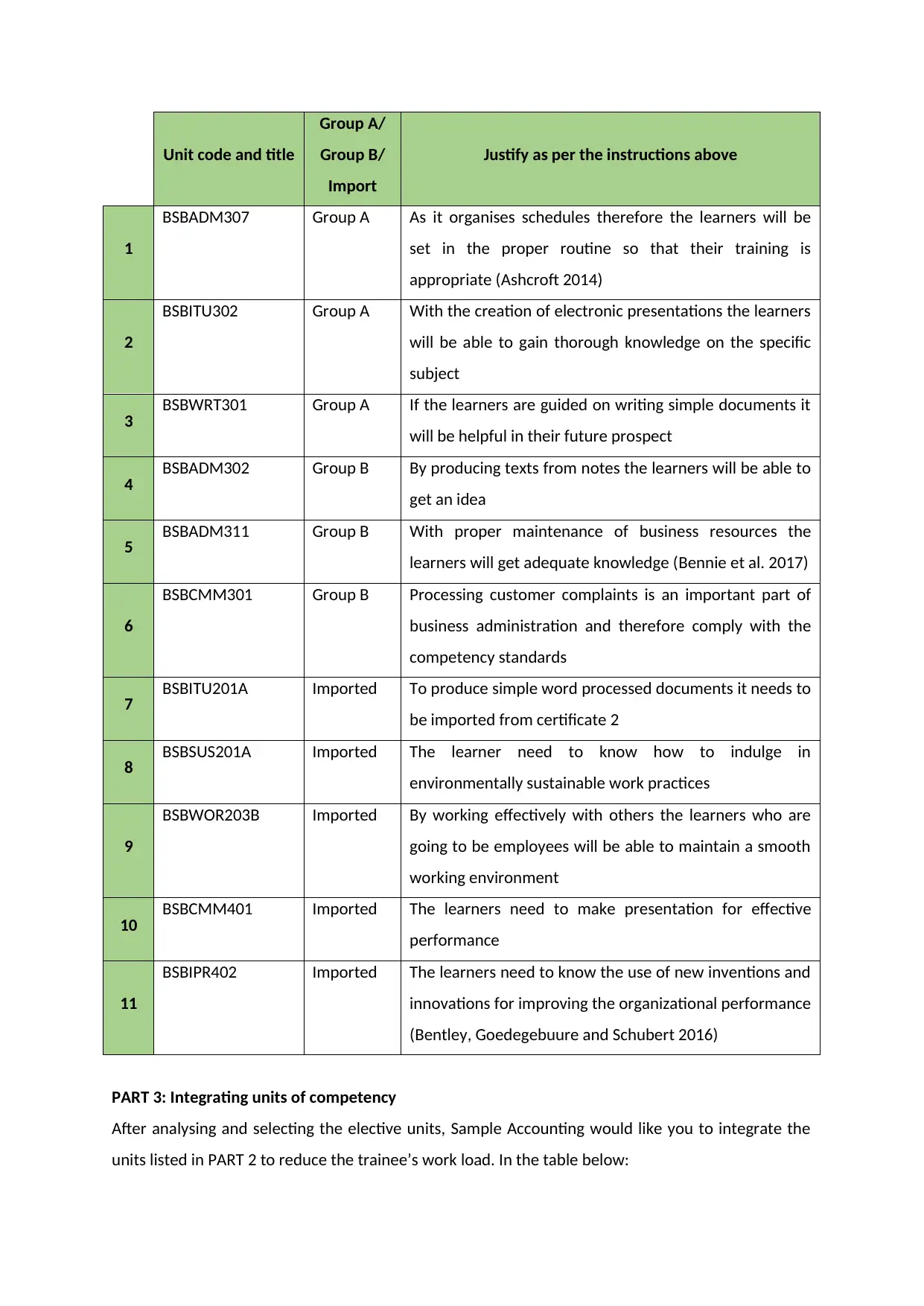
Unit code and title
Group A/
Group B/
Import
Justify as per the instructions above
1
BSBADM307 Group A As it organises schedules therefore the learners will be
set in the proper routine so that their training is
appropriate (Ashcroft 2014)
2
BSBITU302 Group A With the creation of electronic presentations the learners
will be able to gain thorough knowledge on the specific
subject
3 BSBWRT301 Group A If the learners are guided on writing simple documents it
will be helpful in their future prospect
4 BSBADM302 Group B By producing texts from notes the learners will be able to
get an idea
5 BSBADM311 Group B With proper maintenance of business resources the
learners will get adequate knowledge (Bennie et al. 2017)
6
BSBCMM301 Group B Processing customer complaints is an important part of
business administration and therefore comply with the
competency standards
7 BSBITU201A Imported To produce simple word processed documents it needs to
be imported from certificate 2
8 BSBSUS201A Imported The learner need to know how to indulge in
environmentally sustainable work practices
9
BSBWOR203B Imported By working effectively with others the learners who are
going to be employees will be able to maintain a smooth
working environment
10 BSBCMM401 Imported The learners need to make presentation for effective
performance
11
BSBIPR402 Imported The learners need to know the use of new inventions and
innovations for improving the organizational performance
(Bentley, Goedegebuure and Schubert 2016)
PART 3: Integrating units of competency
After analysing and selecting the elective units, Sample Accounting would like you to integrate the
units listed in PART 2 to reduce the trainee’s work load. In the table below:
Group A/
Group B/
Import
Justify as per the instructions above
1
BSBADM307 Group A As it organises schedules therefore the learners will be
set in the proper routine so that their training is
appropriate (Ashcroft 2014)
2
BSBITU302 Group A With the creation of electronic presentations the learners
will be able to gain thorough knowledge on the specific
subject
3 BSBWRT301 Group A If the learners are guided on writing simple documents it
will be helpful in their future prospect
4 BSBADM302 Group B By producing texts from notes the learners will be able to
get an idea
5 BSBADM311 Group B With proper maintenance of business resources the
learners will get adequate knowledge (Bennie et al. 2017)
6
BSBCMM301 Group B Processing customer complaints is an important part of
business administration and therefore comply with the
competency standards
7 BSBITU201A Imported To produce simple word processed documents it needs to
be imported from certificate 2
8 BSBSUS201A Imported The learner need to know how to indulge in
environmentally sustainable work practices
9
BSBWOR203B Imported By working effectively with others the learners who are
going to be employees will be able to maintain a smooth
working environment
10 BSBCMM401 Imported The learners need to make presentation for effective
performance
11
BSBIPR402 Imported The learners need to know the use of new inventions and
innovations for improving the organizational performance
(Bentley, Goedegebuure and Schubert 2016)
PART 3: Integrating units of competency
After analysing and selecting the elective units, Sample Accounting would like you to integrate the
units listed in PART 2 to reduce the trainee’s work load. In the table below:
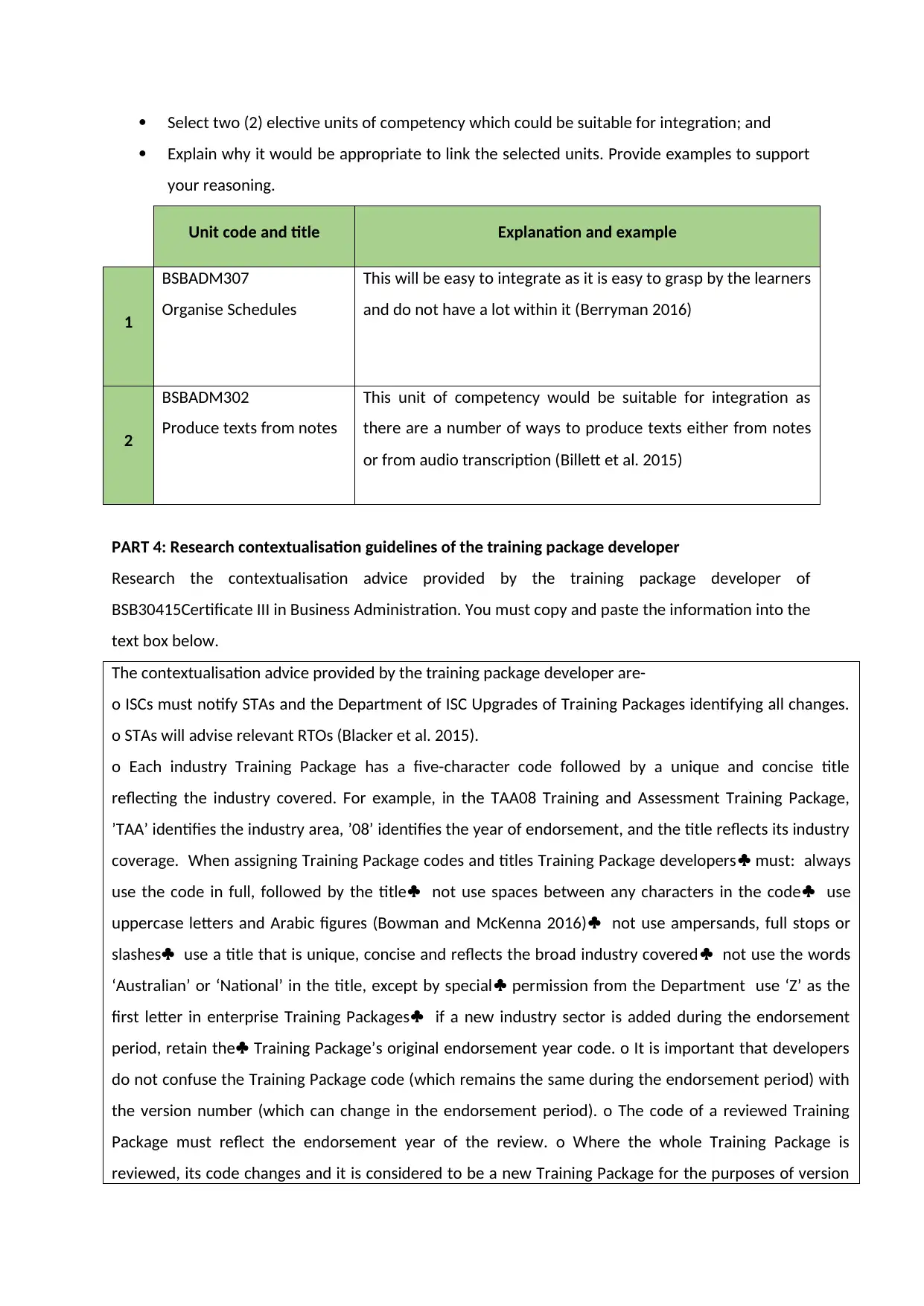
Select two (2) elective units of competency which could be suitable for integration; and
Explain why it would be appropriate to link the selected units. Provide examples to support
your reasoning.
Unit code and title Explanation and example
1
BSBADM307
Organise Schedules
This will be easy to integrate as it is easy to grasp by the learners
and do not have a lot within it (Berryman 2016)
2
BSBADM302
Produce texts from notes
This unit of competency would be suitable for integration as
there are a number of ways to produce texts either from notes
or from audio transcription (Billett et al. 2015)
PART 4: Research contextualisation guidelines of the training package developer
Research the contextualisation advice provided by the training package developer of
BSB30415Certificate III in Business Administration. You must copy and paste the information into the
text box below.
The contextualisation advice provided by the training package developer are-
o ISCs must notify STAs and the Department of ISC Upgrades of Training Packages identifying all changes.
o STAs will advise relevant RTOs (Blacker et al. 2015).
o Each industry Training Package has a five-character code followed by a unique and concise title
reflecting the industry covered. For example, in the TAA08 Training and Assessment Training Package,
’TAA’ identifies the industry area, ’08’ identifies the year of endorsement, and the title reflects its industry
coverage. When assigning Training Package codes and titles Training Package developers must: always
use the code in full, followed by the title not use spaces between any characters in the code use
uppercase letters and Arabic figures (Bowman and McKenna 2016) not use ampersands, full stops or
slashes use a title that is unique, concise and reflects the broad industry covered not use the words
‘Australian’ or ‘National’ in the title, except by special permission from the Department use ‘Z’ as the
first letter in enterprise Training Packages if a new industry sector is added during the endorsement
period, retain the Training Package’s original endorsement year code. o It is important that developers
do not confuse the Training Package code (which remains the same during the endorsement period) with
the version number (which can change in the endorsement period). o The code of a reviewed Training
Package must reflect the endorsement year of the review. o Where the whole Training Package is
reviewed, its code changes and it is considered to be a new Training Package for the purposes of version
Explain why it would be appropriate to link the selected units. Provide examples to support
your reasoning.
Unit code and title Explanation and example
1
BSBADM307
Organise Schedules
This will be easy to integrate as it is easy to grasp by the learners
and do not have a lot within it (Berryman 2016)
2
BSBADM302
Produce texts from notes
This unit of competency would be suitable for integration as
there are a number of ways to produce texts either from notes
or from audio transcription (Billett et al. 2015)
PART 4: Research contextualisation guidelines of the training package developer
Research the contextualisation advice provided by the training package developer of
BSB30415Certificate III in Business Administration. You must copy and paste the information into the
text box below.
The contextualisation advice provided by the training package developer are-
o ISCs must notify STAs and the Department of ISC Upgrades of Training Packages identifying all changes.
o STAs will advise relevant RTOs (Blacker et al. 2015).
o Each industry Training Package has a five-character code followed by a unique and concise title
reflecting the industry covered. For example, in the TAA08 Training and Assessment Training Package,
’TAA’ identifies the industry area, ’08’ identifies the year of endorsement, and the title reflects its industry
coverage. When assigning Training Package codes and titles Training Package developers must: always
use the code in full, followed by the title not use spaces between any characters in the code use
uppercase letters and Arabic figures (Bowman and McKenna 2016) not use ampersands, full stops or
slashes use a title that is unique, concise and reflects the broad industry covered not use the words
‘Australian’ or ‘National’ in the title, except by special permission from the Department use ‘Z’ as the
first letter in enterprise Training Packages if a new industry sector is added during the endorsement
period, retain the Training Package’s original endorsement year code. o It is important that developers
do not confuse the Training Package code (which remains the same during the endorsement period) with
the version number (which can change in the endorsement period). o The code of a reviewed Training
Package must reflect the endorsement year of the review. o Where the whole Training Package is
reviewed, its code changes and it is considered to be a new Training Package for the purposes of version
Secure Best Marks with AI Grader
Need help grading? Try our AI Grader for instant feedback on your assignments.
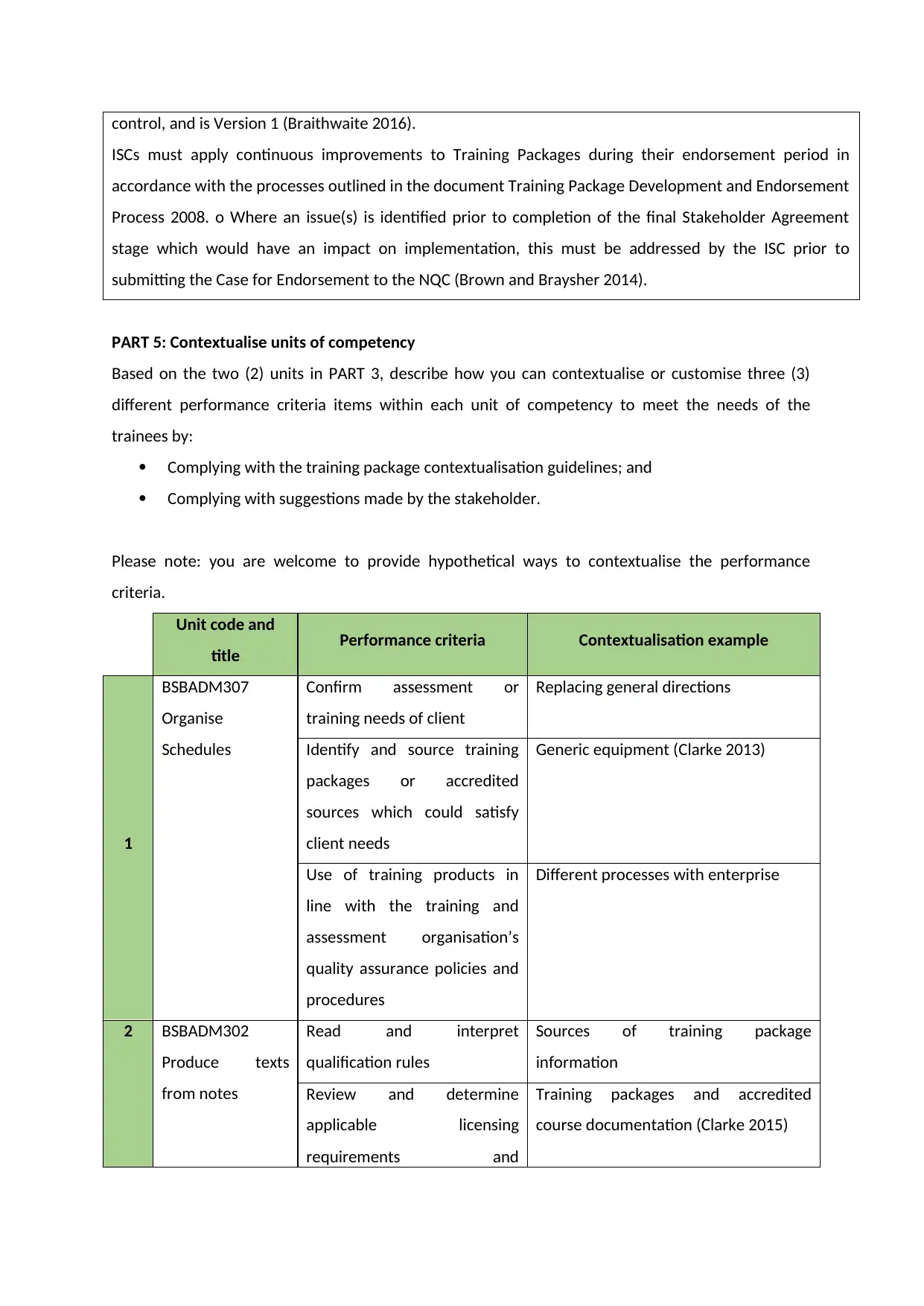
control, and is Version 1 (Braithwaite 2016).
ISCs must apply continuous improvements to Training Packages during their endorsement period in
accordance with the processes outlined in the document Training Package Development and Endorsement
Process 2008. o Where an issue(s) is identified prior to completion of the final Stakeholder Agreement
stage which would have an impact on implementation, this must be addressed by the ISC prior to
submitting the Case for Endorsement to the NQC (Brown and Braysher 2014).
PART 5: Contextualise units of competency
Based on the two (2) units in PART 3, describe how you can contextualise or customise three (3)
different performance criteria items within each unit of competency to meet the needs of the
trainees by:
Complying with the training package contextualisation guidelines; and
Complying with suggestions made by the stakeholder.
Please note: you are welcome to provide hypothetical ways to contextualise the performance
criteria.
Unit code and
title Performance criteria Contextualisation example
1
BSBADM307
Organise
Schedules
Confirm assessment or
training needs of client
Replacing general directions
Identify and source training
packages or accredited
sources which could satisfy
client needs
Generic equipment (Clarke 2013)
Use of training products in
line with the training and
assessment organisation’s
quality assurance policies and
procedures
Different processes with enterprise
2 BSBADM302
Produce texts
from notes
Read and interpret
qualification rules
Sources of training package
information
Review and determine
applicable licensing
requirements and
Training packages and accredited
course documentation (Clarke 2015)
ISCs must apply continuous improvements to Training Packages during their endorsement period in
accordance with the processes outlined in the document Training Package Development and Endorsement
Process 2008. o Where an issue(s) is identified prior to completion of the final Stakeholder Agreement
stage which would have an impact on implementation, this must be addressed by the ISC prior to
submitting the Case for Endorsement to the NQC (Brown and Braysher 2014).
PART 5: Contextualise units of competency
Based on the two (2) units in PART 3, describe how you can contextualise or customise three (3)
different performance criteria items within each unit of competency to meet the needs of the
trainees by:
Complying with the training package contextualisation guidelines; and
Complying with suggestions made by the stakeholder.
Please note: you are welcome to provide hypothetical ways to contextualise the performance
criteria.
Unit code and
title Performance criteria Contextualisation example
1
BSBADM307
Organise
Schedules
Confirm assessment or
training needs of client
Replacing general directions
Identify and source training
packages or accredited
sources which could satisfy
client needs
Generic equipment (Clarke 2013)
Use of training products in
line with the training and
assessment organisation’s
quality assurance policies and
procedures
Different processes with enterprise
2 BSBADM302
Produce texts
from notes
Read and interpret
qualification rules
Sources of training package
information
Review and determine
applicable licensing
requirements and
Training packages and accredited
course documentation (Clarke 2015)
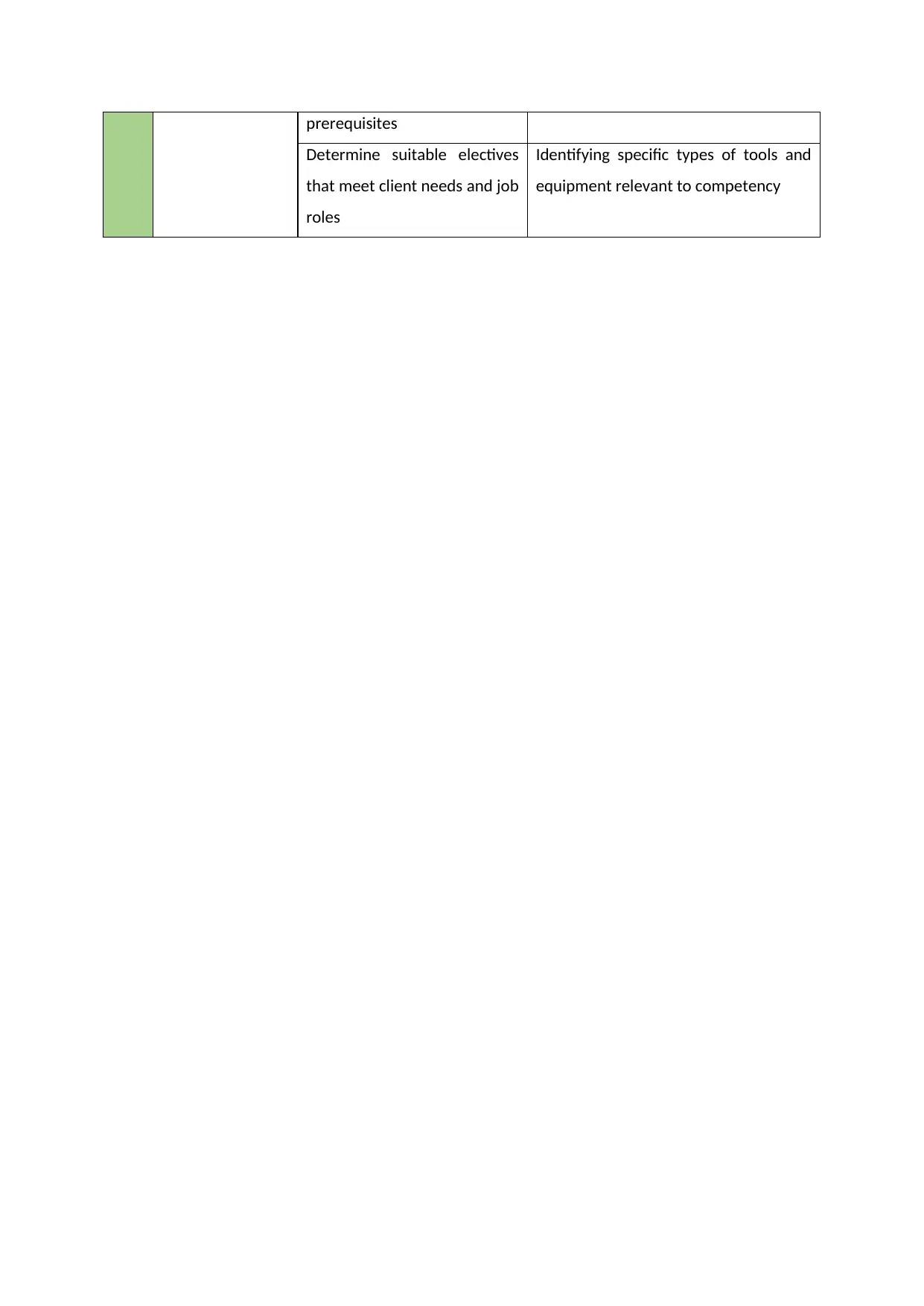
prerequisites
Determine suitable electives
that meet client needs and job
roles
Identifying specific types of tools and
equipment relevant to competency
Determine suitable electives
that meet client needs and job
roles
Identifying specific types of tools and
equipment relevant to competency
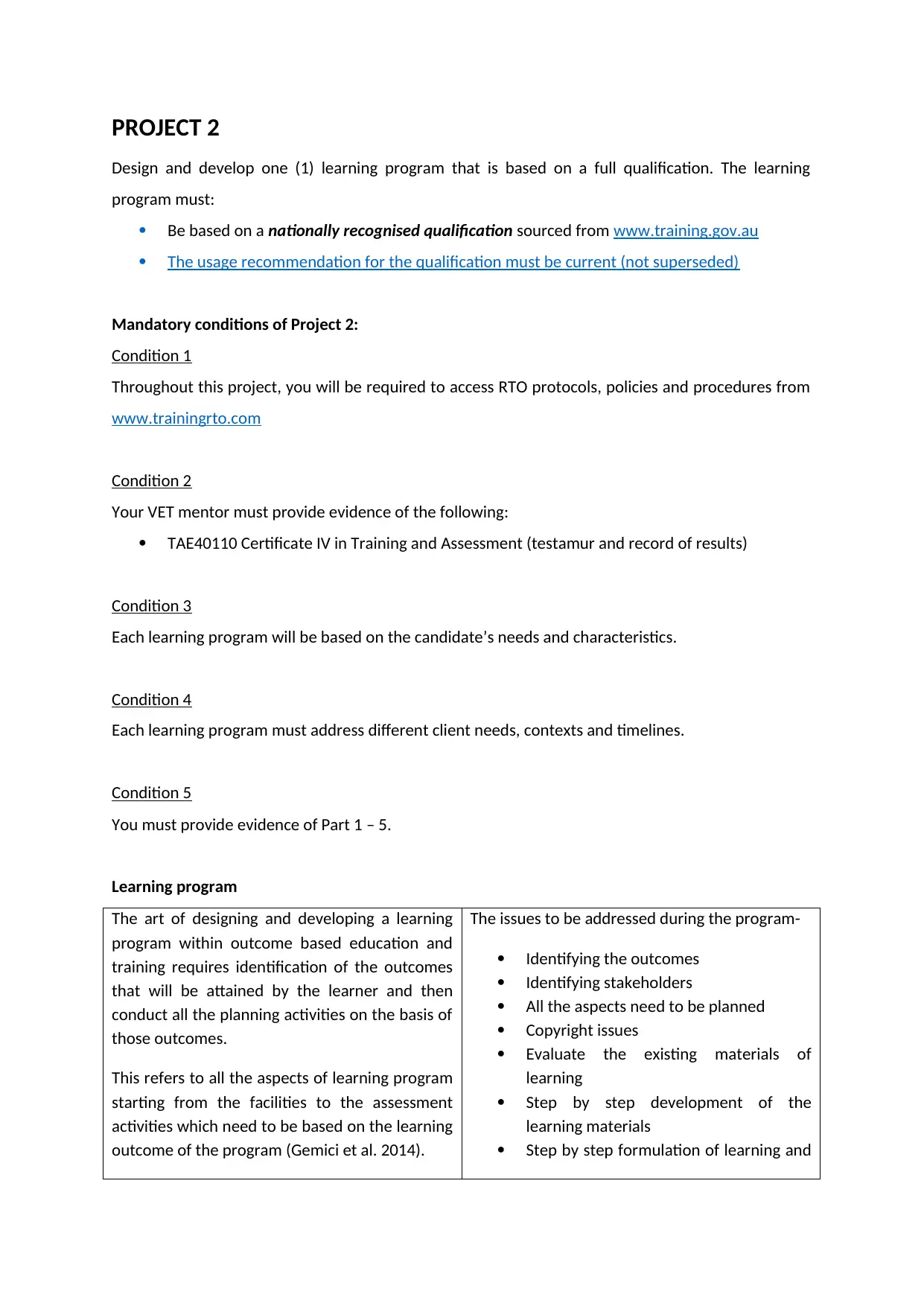
PROJECT 2
Design and develop one (1) learning program that is based on a full qualification. The learning
program must:
Be based on a nationally recognised qualification sourced from www.training.gov.au
The usage recommendation for the qualification must be current (not superseded)
Mandatory conditions of Project 2:
Condition 1
Throughout this project, you will be required to access RTO protocols, policies and procedures from
www.trainingrto.com
Condition 2
Your VET mentor must provide evidence of the following:
TAE40110 Certificate IV in Training and Assessment (testamur and record of results)
Condition 3
Each learning program will be based on the candidate’s needs and characteristics.
Condition 4
Each learning program must address different client needs, contexts and timelines.
Condition 5
You must provide evidence of Part 1 – 5.
Learning program
The art of designing and developing a learning
program within outcome based education and
training requires identification of the outcomes
that will be attained by the learner and then
conduct all the planning activities on the basis of
those outcomes.
This refers to all the aspects of learning program
starting from the facilities to the assessment
activities which need to be based on the learning
outcome of the program (Gemici et al. 2014).
The issues to be addressed during the program-
Identifying the outcomes
Identifying stakeholders
All the aspects need to be planned
Copyright issues
Evaluate the existing materials of
learning
Step by step development of the
learning materials
Step by step formulation of learning and
Design and develop one (1) learning program that is based on a full qualification. The learning
program must:
Be based on a nationally recognised qualification sourced from www.training.gov.au
The usage recommendation for the qualification must be current (not superseded)
Mandatory conditions of Project 2:
Condition 1
Throughout this project, you will be required to access RTO protocols, policies and procedures from
www.trainingrto.com
Condition 2
Your VET mentor must provide evidence of the following:
TAE40110 Certificate IV in Training and Assessment (testamur and record of results)
Condition 3
Each learning program will be based on the candidate’s needs and characteristics.
Condition 4
Each learning program must address different client needs, contexts and timelines.
Condition 5
You must provide evidence of Part 1 – 5.
Learning program
The art of designing and developing a learning
program within outcome based education and
training requires identification of the outcomes
that will be attained by the learner and then
conduct all the planning activities on the basis of
those outcomes.
This refers to all the aspects of learning program
starting from the facilities to the assessment
activities which need to be based on the learning
outcome of the program (Gemici et al. 2014).
The issues to be addressed during the program-
Identifying the outcomes
Identifying stakeholders
All the aspects need to be planned
Copyright issues
Evaluate the existing materials of
learning
Step by step development of the
learning materials
Step by step formulation of learning and
Paraphrase This Document
Need a fresh take? Get an instant paraphrase of this document with our AI Paraphraser
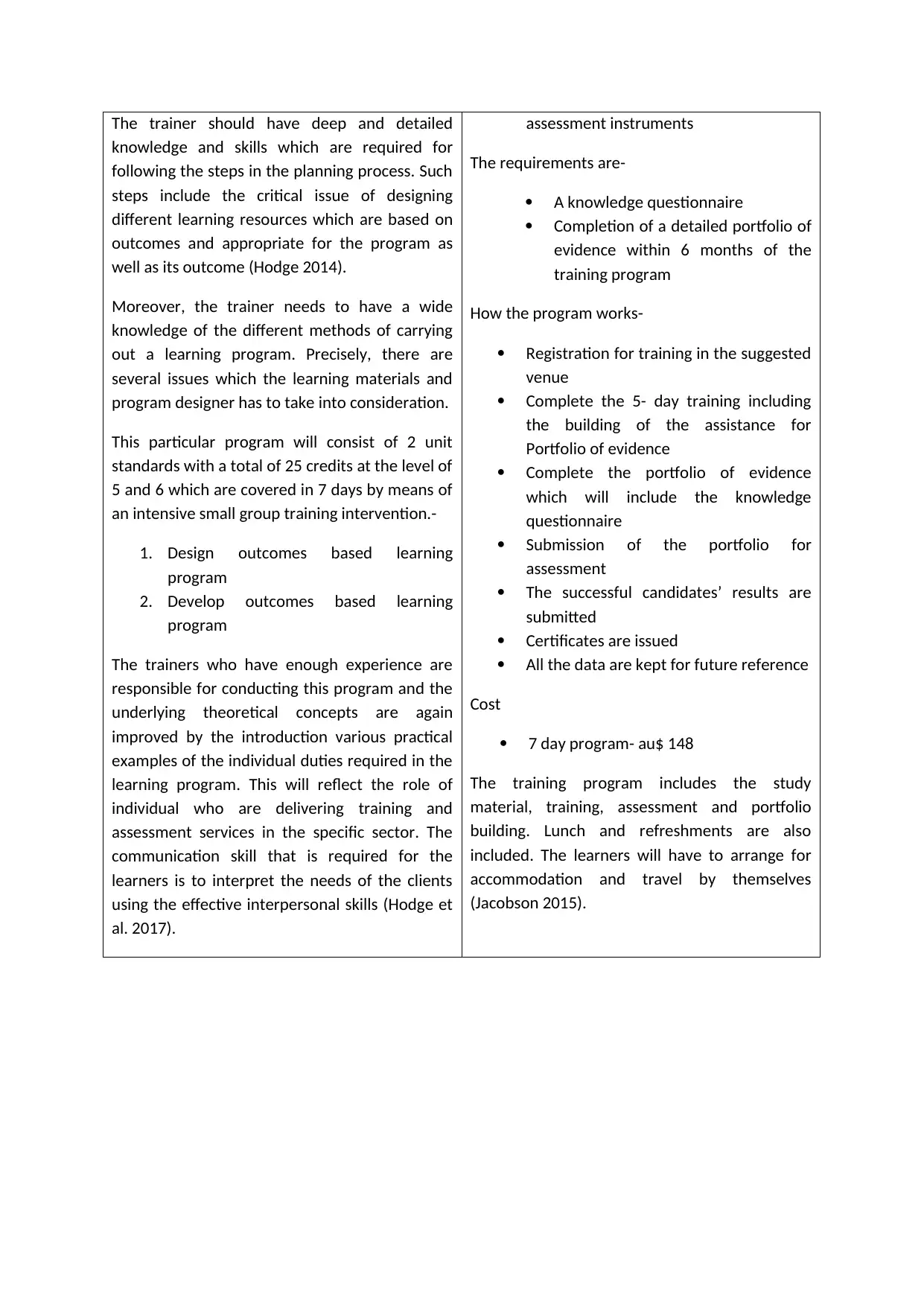
The trainer should have deep and detailed
knowledge and skills which are required for
following the steps in the planning process. Such
steps include the critical issue of designing
different learning resources which are based on
outcomes and appropriate for the program as
well as its outcome (Hodge 2014).
Moreover, the trainer needs to have a wide
knowledge of the different methods of carrying
out a learning program. Precisely, there are
several issues which the learning materials and
program designer has to take into consideration.
This particular program will consist of 2 unit
standards with a total of 25 credits at the level of
5 and 6 which are covered in 7 days by means of
an intensive small group training intervention.-
1. Design outcomes based learning
program
2. Develop outcomes based learning
program
The trainers who have enough experience are
responsible for conducting this program and the
underlying theoretical concepts are again
improved by the introduction various practical
examples of the individual duties required in the
learning program. This will reflect the role of
individual who are delivering training and
assessment services in the specific sector. The
communication skill that is required for the
learners is to interpret the needs of the clients
using the effective interpersonal skills (Hodge et
al. 2017).
assessment instruments
The requirements are-
A knowledge questionnaire
Completion of a detailed portfolio of
evidence within 6 months of the
training program
How the program works-
Registration for training in the suggested
venue
Complete the 5- day training including
the building of the assistance for
Portfolio of evidence
Complete the portfolio of evidence
which will include the knowledge
questionnaire
Submission of the portfolio for
assessment
The successful candidates’ results are
submitted
Certificates are issued
All the data are kept for future reference
Cost
7 day program- au$ 148
The training program includes the study
material, training, assessment and portfolio
building. Lunch and refreshments are also
included. The learners will have to arrange for
accommodation and travel by themselves
(Jacobson 2015).
knowledge and skills which are required for
following the steps in the planning process. Such
steps include the critical issue of designing
different learning resources which are based on
outcomes and appropriate for the program as
well as its outcome (Hodge 2014).
Moreover, the trainer needs to have a wide
knowledge of the different methods of carrying
out a learning program. Precisely, there are
several issues which the learning materials and
program designer has to take into consideration.
This particular program will consist of 2 unit
standards with a total of 25 credits at the level of
5 and 6 which are covered in 7 days by means of
an intensive small group training intervention.-
1. Design outcomes based learning
program
2. Develop outcomes based learning
program
The trainers who have enough experience are
responsible for conducting this program and the
underlying theoretical concepts are again
improved by the introduction various practical
examples of the individual duties required in the
learning program. This will reflect the role of
individual who are delivering training and
assessment services in the specific sector. The
communication skill that is required for the
learners is to interpret the needs of the clients
using the effective interpersonal skills (Hodge et
al. 2017).
assessment instruments
The requirements are-
A knowledge questionnaire
Completion of a detailed portfolio of
evidence within 6 months of the
training program
How the program works-
Registration for training in the suggested
venue
Complete the 5- day training including
the building of the assistance for
Portfolio of evidence
Complete the portfolio of evidence
which will include the knowledge
questionnaire
Submission of the portfolio for
assessment
The successful candidates’ results are
submitted
Certificates are issued
All the data are kept for future reference
Cost
7 day program- au$ 148
The training program includes the study
material, training, assessment and portfolio
building. Lunch and refreshments are also
included. The learners will have to arrange for
accommodation and travel by themselves
(Jacobson 2015).
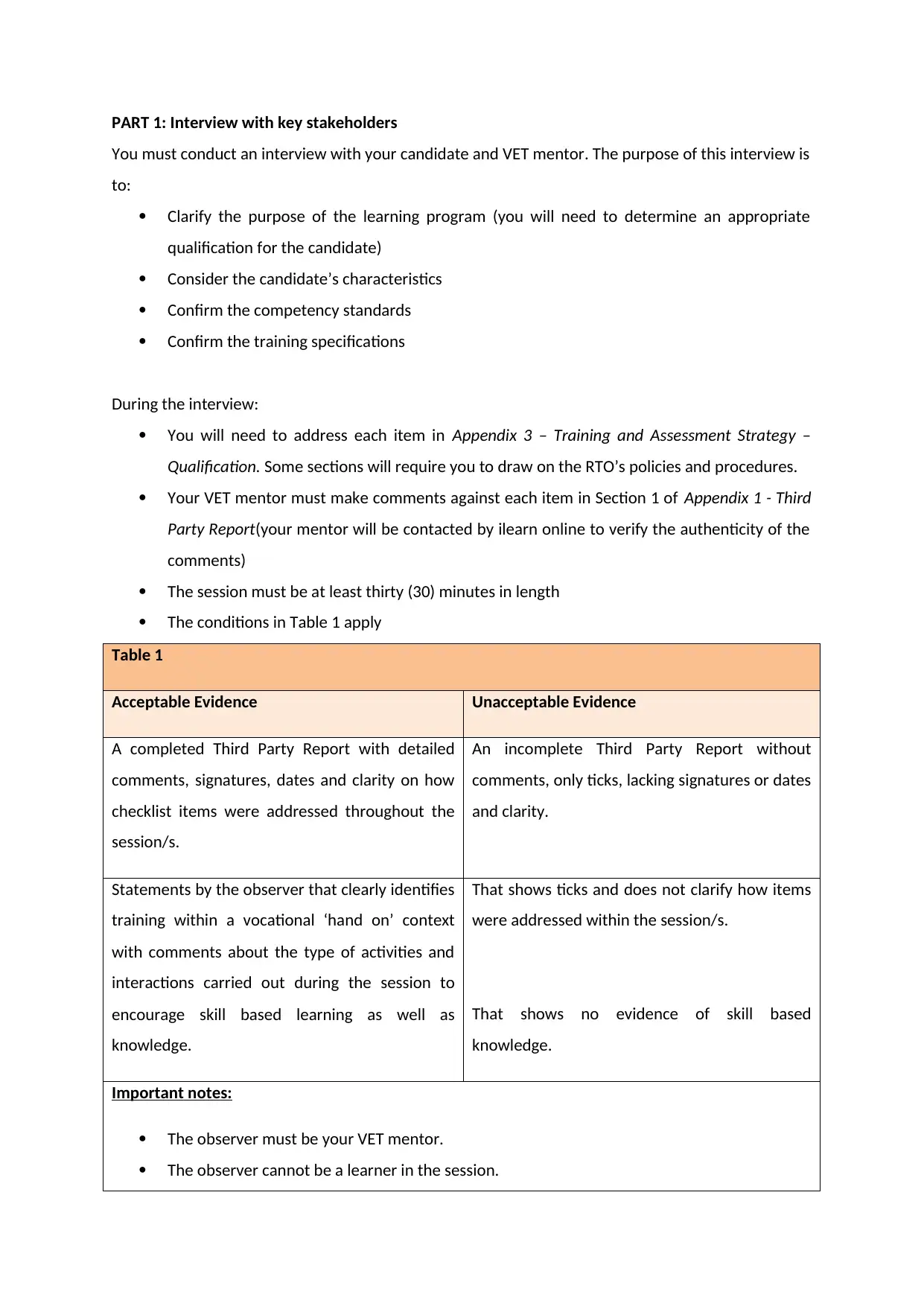
PART 1: Interview with key stakeholders
You must conduct an interview with your candidate and VET mentor. The purpose of this interview is
to:
Clarify the purpose of the learning program (you will need to determine an appropriate
qualification for the candidate)
Consider the candidate’s characteristics
Confirm the competency standards
Confirm the training specifications
During the interview:
You will need to address each item in Appendix 3 – Training and Assessment Strategy –
Qualification. Some sections will require you to draw on the RTO’s policies and procedures.
Your VET mentor must make comments against each item in Section 1 of Appendix 1 - Third
Party Report(your mentor will be contacted by ilearn online to verify the authenticity of the
comments)
The session must be at least thirty (30) minutes in length
The conditions in Table 1 apply
Table 1
Acceptable Evidence Unacceptable Evidence
A completed Third Party Report with detailed
comments, signatures, dates and clarity on how
checklist items were addressed throughout the
session/s.
An incomplete Third Party Report without
comments, only ticks, lacking signatures or dates
and clarity.
Statements by the observer that clearly identifies
training within a vocational ‘hand on’ context
with comments about the type of activities and
interactions carried out during the session to
encourage skill based learning as well as
knowledge.
That shows ticks and does not clarify how items
were addressed within the session/s.
That shows no evidence of skill based
knowledge.
Important notes:
The observer must be your VET mentor.
The observer cannot be a learner in the session.
You must conduct an interview with your candidate and VET mentor. The purpose of this interview is
to:
Clarify the purpose of the learning program (you will need to determine an appropriate
qualification for the candidate)
Consider the candidate’s characteristics
Confirm the competency standards
Confirm the training specifications
During the interview:
You will need to address each item in Appendix 3 – Training and Assessment Strategy –
Qualification. Some sections will require you to draw on the RTO’s policies and procedures.
Your VET mentor must make comments against each item in Section 1 of Appendix 1 - Third
Party Report(your mentor will be contacted by ilearn online to verify the authenticity of the
comments)
The session must be at least thirty (30) minutes in length
The conditions in Table 1 apply
Table 1
Acceptable Evidence Unacceptable Evidence
A completed Third Party Report with detailed
comments, signatures, dates and clarity on how
checklist items were addressed throughout the
session/s.
An incomplete Third Party Report without
comments, only ticks, lacking signatures or dates
and clarity.
Statements by the observer that clearly identifies
training within a vocational ‘hand on’ context
with comments about the type of activities and
interactions carried out during the session to
encourage skill based learning as well as
knowledge.
That shows ticks and does not clarify how items
were addressed within the session/s.
That shows no evidence of skill based
knowledge.
Important notes:
The observer must be your VET mentor.
The observer cannot be a learner in the session.
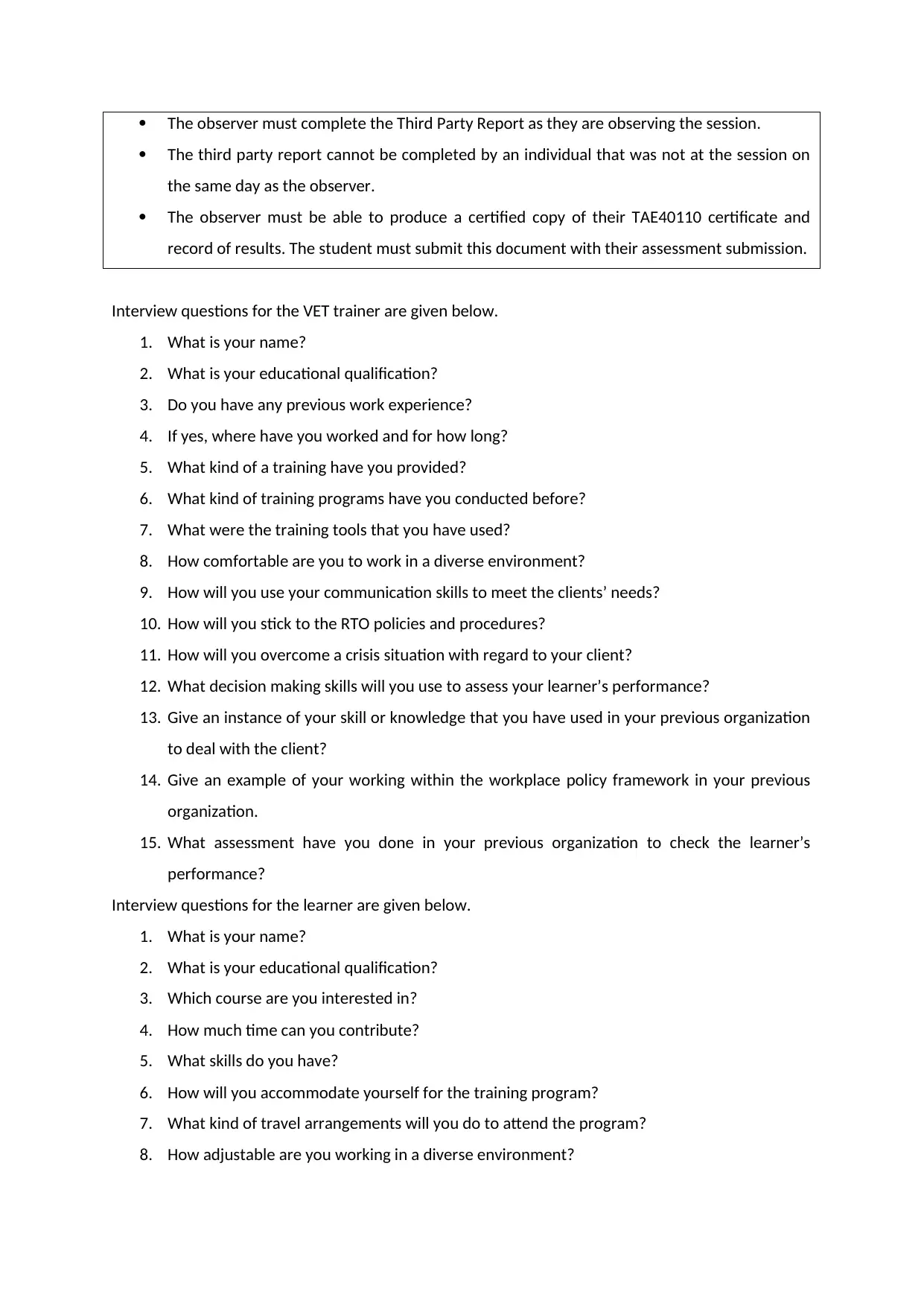
The observer must complete the Third Party Report as they are observing the session.
The third party report cannot be completed by an individual that was not at the session on
the same day as the observer.
The observer must be able to produce a certified copy of their TAE40110 certificate and
record of results. The student must submit this document with their assessment submission.
Interview questions for the VET trainer are given below.
1. What is your name?
2. What is your educational qualification?
3. Do you have any previous work experience?
4. If yes, where have you worked and for how long?
5. What kind of a training have you provided?
6. What kind of training programs have you conducted before?
7. What were the training tools that you have used?
8. How comfortable are you to work in a diverse environment?
9. How will you use your communication skills to meet the clients’ needs?
10. How will you stick to the RTO policies and procedures?
11. How will you overcome a crisis situation with regard to your client?
12. What decision making skills will you use to assess your learner’s performance?
13. Give an instance of your skill or knowledge that you have used in your previous organization
to deal with the client?
14. Give an example of your working within the workplace policy framework in your previous
organization.
15. What assessment have you done in your previous organization to check the learner’s
performance?
Interview questions for the learner are given below.
1. What is your name?
2. What is your educational qualification?
3. Which course are you interested in?
4. How much time can you contribute?
5. What skills do you have?
6. How will you accommodate yourself for the training program?
7. What kind of travel arrangements will you do to attend the program?
8. How adjustable are you working in a diverse environment?
The third party report cannot be completed by an individual that was not at the session on
the same day as the observer.
The observer must be able to produce a certified copy of their TAE40110 certificate and
record of results. The student must submit this document with their assessment submission.
Interview questions for the VET trainer are given below.
1. What is your name?
2. What is your educational qualification?
3. Do you have any previous work experience?
4. If yes, where have you worked and for how long?
5. What kind of a training have you provided?
6. What kind of training programs have you conducted before?
7. What were the training tools that you have used?
8. How comfortable are you to work in a diverse environment?
9. How will you use your communication skills to meet the clients’ needs?
10. How will you stick to the RTO policies and procedures?
11. How will you overcome a crisis situation with regard to your client?
12. What decision making skills will you use to assess your learner’s performance?
13. Give an instance of your skill or knowledge that you have used in your previous organization
to deal with the client?
14. Give an example of your working within the workplace policy framework in your previous
organization.
15. What assessment have you done in your previous organization to check the learner’s
performance?
Interview questions for the learner are given below.
1. What is your name?
2. What is your educational qualification?
3. Which course are you interested in?
4. How much time can you contribute?
5. What skills do you have?
6. How will you accommodate yourself for the training program?
7. What kind of travel arrangements will you do to attend the program?
8. How adjustable are you working in a diverse environment?
Secure Best Marks with AI Grader
Need help grading? Try our AI Grader for instant feedback on your assignments.
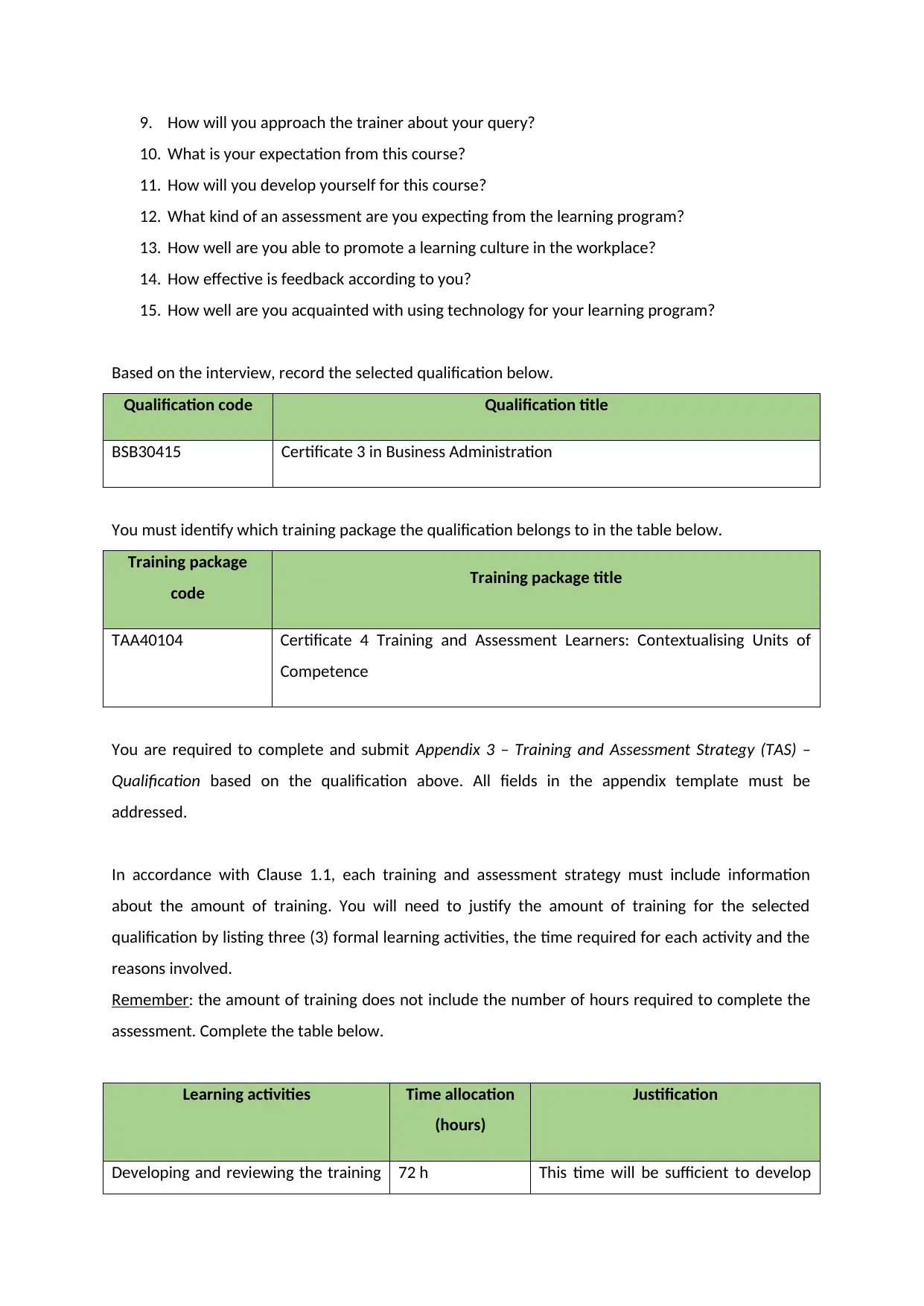
9. How will you approach the trainer about your query?
10. What is your expectation from this course?
11. How will you develop yourself for this course?
12. What kind of an assessment are you expecting from the learning program?
13. How well are you able to promote a learning culture in the workplace?
14. How effective is feedback according to you?
15. How well are you acquainted with using technology for your learning program?
Based on the interview, record the selected qualification below.
Qualification code Qualification title
BSB30415 Certificate 3 in Business Administration
You must identify which training package the qualification belongs to in the table below.
Training package
code Training package title
TAA40104 Certificate 4 Training and Assessment Learners: Contextualising Units of
Competence
You are required to complete and submit Appendix 3 – Training and Assessment Strategy (TAS) –
Qualification based on the qualification above. All fields in the appendix template must be
addressed.
In accordance with Clause 1.1, each training and assessment strategy must include information
about the amount of training. You will need to justify the amount of training for the selected
qualification by listing three (3) formal learning activities, the time required for each activity and the
reasons involved.
Remember: the amount of training does not include the number of hours required to complete the
assessment. Complete the table below.
Learning activities Time allocation
(hours)
Justification
Developing and reviewing the training 72 h This time will be sufficient to develop
10. What is your expectation from this course?
11. How will you develop yourself for this course?
12. What kind of an assessment are you expecting from the learning program?
13. How well are you able to promote a learning culture in the workplace?
14. How effective is feedback according to you?
15. How well are you acquainted with using technology for your learning program?
Based on the interview, record the selected qualification below.
Qualification code Qualification title
BSB30415 Certificate 3 in Business Administration
You must identify which training package the qualification belongs to in the table below.
Training package
code Training package title
TAA40104 Certificate 4 Training and Assessment Learners: Contextualising Units of
Competence
You are required to complete and submit Appendix 3 – Training and Assessment Strategy (TAS) –
Qualification based on the qualification above. All fields in the appendix template must be
addressed.
In accordance with Clause 1.1, each training and assessment strategy must include information
about the amount of training. You will need to justify the amount of training for the selected
qualification by listing three (3) formal learning activities, the time required for each activity and the
reasons involved.
Remember: the amount of training does not include the number of hours required to complete the
assessment. Complete the table below.
Learning activities Time allocation
(hours)
Justification
Developing and reviewing the training 72 h This time will be sufficient to develop
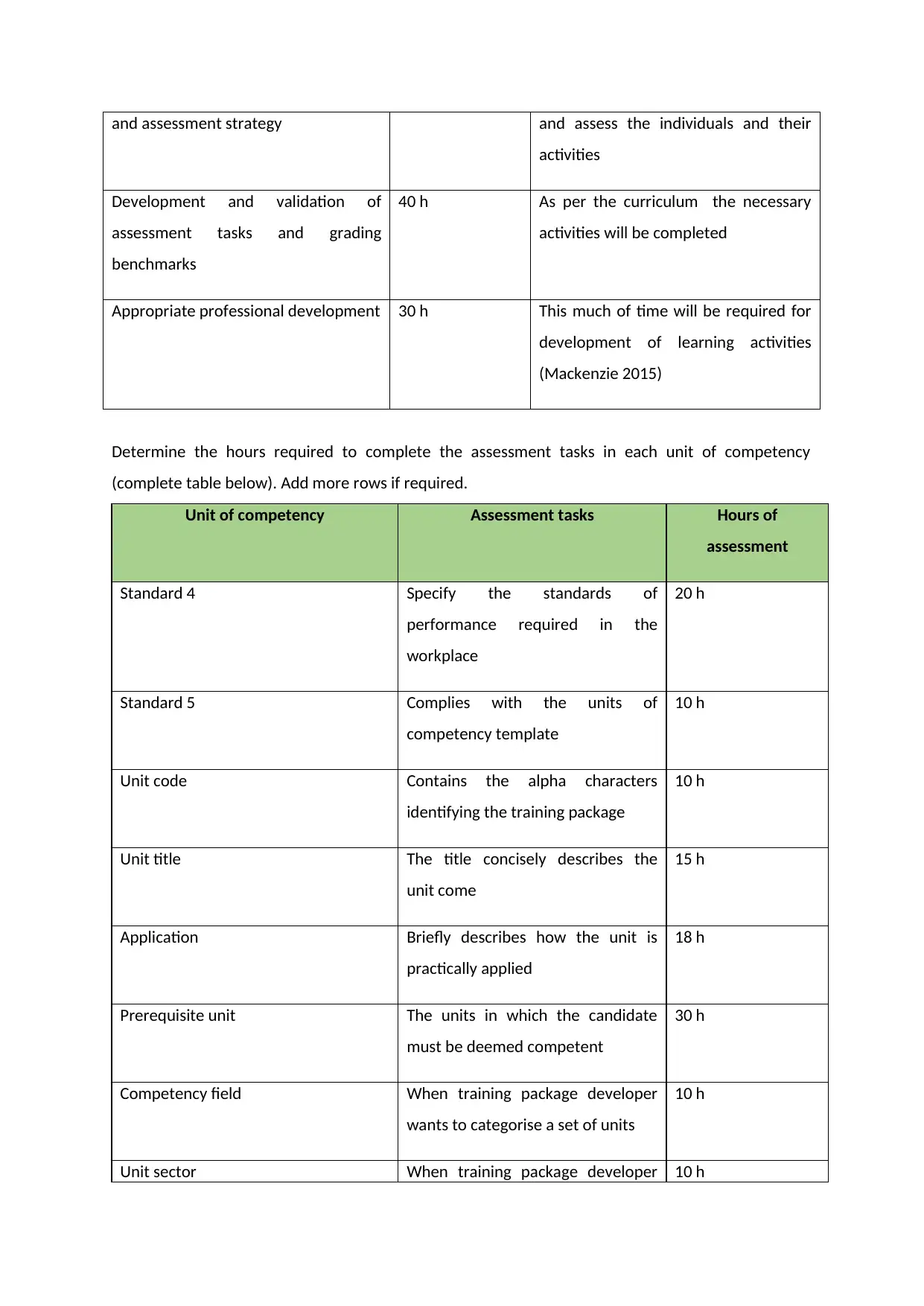
and assessment strategy and assess the individuals and their
activities
Development and validation of
assessment tasks and grading
benchmarks
40 h As per the curriculum the necessary
activities will be completed
Appropriate professional development 30 h This much of time will be required for
development of learning activities
(Mackenzie 2015)
Determine the hours required to complete the assessment tasks in each unit of competency
(complete table below). Add more rows if required.
Unit of competency Assessment tasks Hours of
assessment
Standard 4 Specify the standards of
performance required in the
workplace
20 h
Standard 5 Complies with the units of
competency template
10 h
Unit code Contains the alpha characters
identifying the training package
10 h
Unit title The title concisely describes the
unit come
15 h
Application Briefly describes how the unit is
practically applied
18 h
Prerequisite unit The units in which the candidate
must be deemed competent
30 h
Competency field When training package developer
wants to categorise a set of units
10 h
Unit sector When training package developer 10 h
activities
Development and validation of
assessment tasks and grading
benchmarks
40 h As per the curriculum the necessary
activities will be completed
Appropriate professional development 30 h This much of time will be required for
development of learning activities
(Mackenzie 2015)
Determine the hours required to complete the assessment tasks in each unit of competency
(complete table below). Add more rows if required.
Unit of competency Assessment tasks Hours of
assessment
Standard 4 Specify the standards of
performance required in the
workplace
20 h
Standard 5 Complies with the units of
competency template
10 h
Unit code Contains the alpha characters
identifying the training package
10 h
Unit title The title concisely describes the
unit come
15 h
Application Briefly describes how the unit is
practically applied
18 h
Prerequisite unit The units in which the candidate
must be deemed competent
30 h
Competency field When training package developer
wants to categorise a set of units
10 h
Unit sector When training package developer 10 h
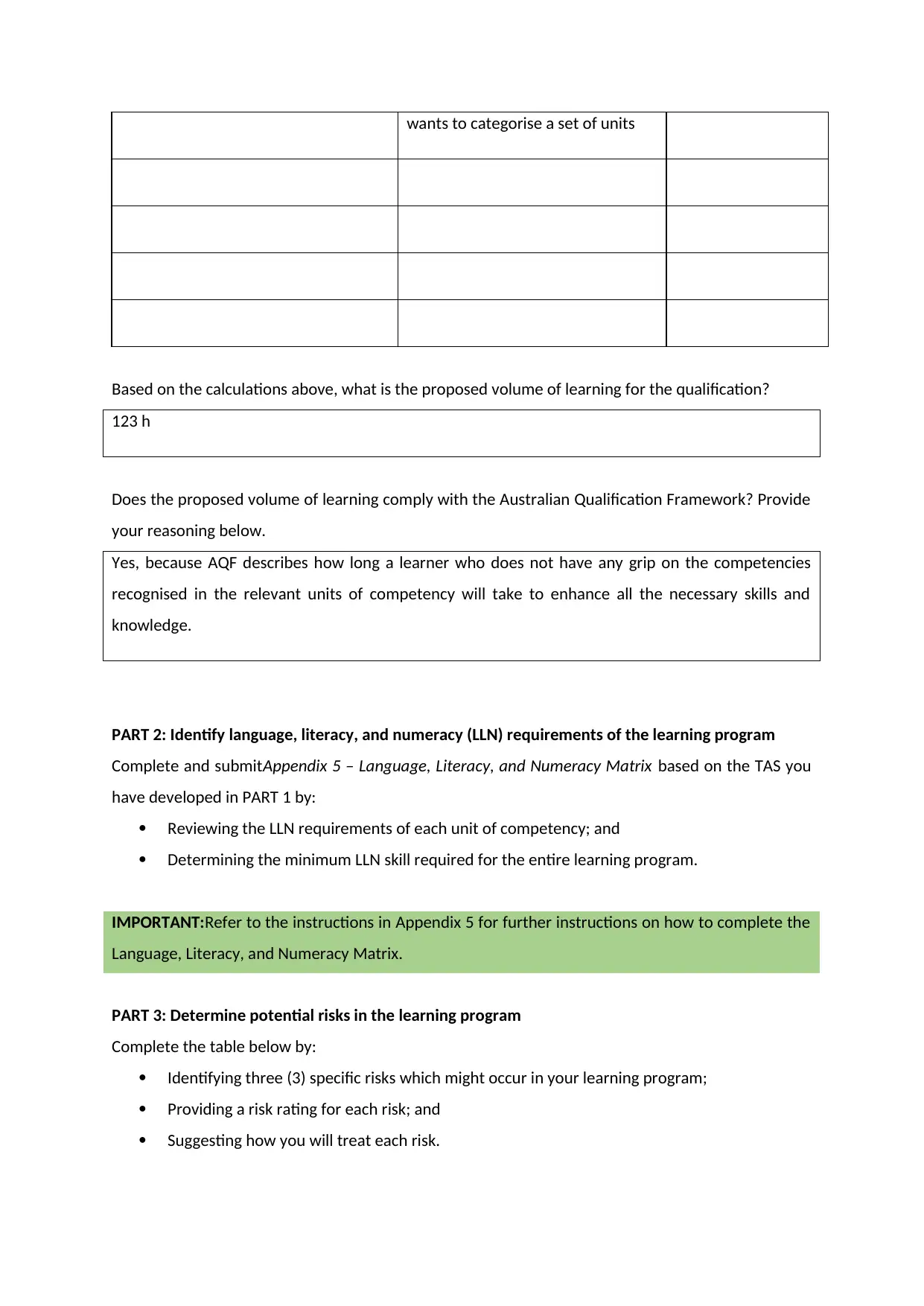
wants to categorise a set of units
Based on the calculations above, what is the proposed volume of learning for the qualification?
123 h
Does the proposed volume of learning comply with the Australian Qualification Framework? Provide
your reasoning below.
Yes, because AQF describes how long a learner who does not have any grip on the competencies
recognised in the relevant units of competency will take to enhance all the necessary skills and
knowledge.
PART 2: Identify language, literacy, and numeracy (LLN) requirements of the learning program
Complete and submitAppendix 5 – Language, Literacy, and Numeracy Matrix based on the TAS you
have developed in PART 1 by:
Reviewing the LLN requirements of each unit of competency; and
Determining the minimum LLN skill required for the entire learning program.
IMPORTANT:Refer to the instructions in Appendix 5 for further instructions on how to complete the
Language, Literacy, and Numeracy Matrix.
PART 3: Determine potential risks in the learning program
Complete the table below by:
Identifying three (3) specific risks which might occur in your learning program;
Providing a risk rating for each risk; and
Suggesting how you will treat each risk.
Based on the calculations above, what is the proposed volume of learning for the qualification?
123 h
Does the proposed volume of learning comply with the Australian Qualification Framework? Provide
your reasoning below.
Yes, because AQF describes how long a learner who does not have any grip on the competencies
recognised in the relevant units of competency will take to enhance all the necessary skills and
knowledge.
PART 2: Identify language, literacy, and numeracy (LLN) requirements of the learning program
Complete and submitAppendix 5 – Language, Literacy, and Numeracy Matrix based on the TAS you
have developed in PART 1 by:
Reviewing the LLN requirements of each unit of competency; and
Determining the minimum LLN skill required for the entire learning program.
IMPORTANT:Refer to the instructions in Appendix 5 for further instructions on how to complete the
Language, Literacy, and Numeracy Matrix.
PART 3: Determine potential risks in the learning program
Complete the table below by:
Identifying three (3) specific risks which might occur in your learning program;
Providing a risk rating for each risk; and
Suggesting how you will treat each risk.
Paraphrase This Document
Need a fresh take? Get an instant paraphrase of this document with our AI Paraphraser
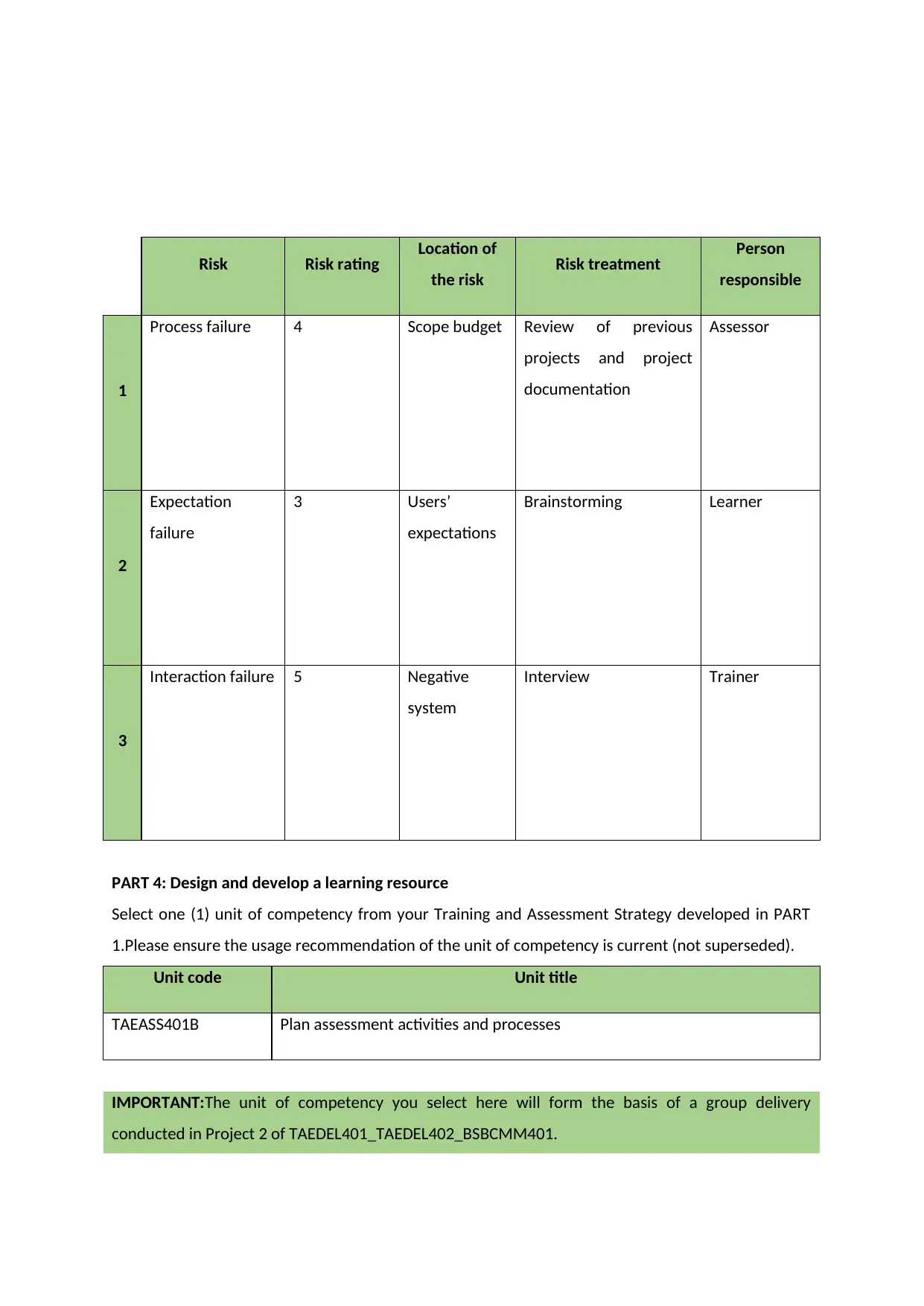
Risk Risk rating Location of
the risk Risk treatment Person
responsible
1
Process failure 4 Scope budget Review of previous
projects and project
documentation
Assessor
2
Expectation
failure
3 Users’
expectations
Brainstorming Learner
3
Interaction failure 5 Negative
system
Interview Trainer
PART 4: Design and develop a learning resource
Select one (1) unit of competency from your Training and Assessment Strategy developed in PART
1.Please ensure the usage recommendation of the unit of competency is current (not superseded).
Unit code Unit title
TAEASS401B Plan assessment activities and processes
IMPORTANT:The unit of competency you select here will form the basis of a group delivery
conducted in Project 2 of TAEDEL401_TAEDEL402_BSBCMM401.
the risk Risk treatment Person
responsible
1
Process failure 4 Scope budget Review of previous
projects and project
documentation
Assessor
2
Expectation
failure
3 Users’
expectations
Brainstorming Learner
3
Interaction failure 5 Negative
system
Interview Trainer
PART 4: Design and develop a learning resource
Select one (1) unit of competency from your Training and Assessment Strategy developed in PART
1.Please ensure the usage recommendation of the unit of competency is current (not superseded).
Unit code Unit title
TAEASS401B Plan assessment activities and processes
IMPORTANT:The unit of competency you select here will form the basis of a group delivery
conducted in Project 2 of TAEDEL401_TAEDEL402_BSBCMM401.
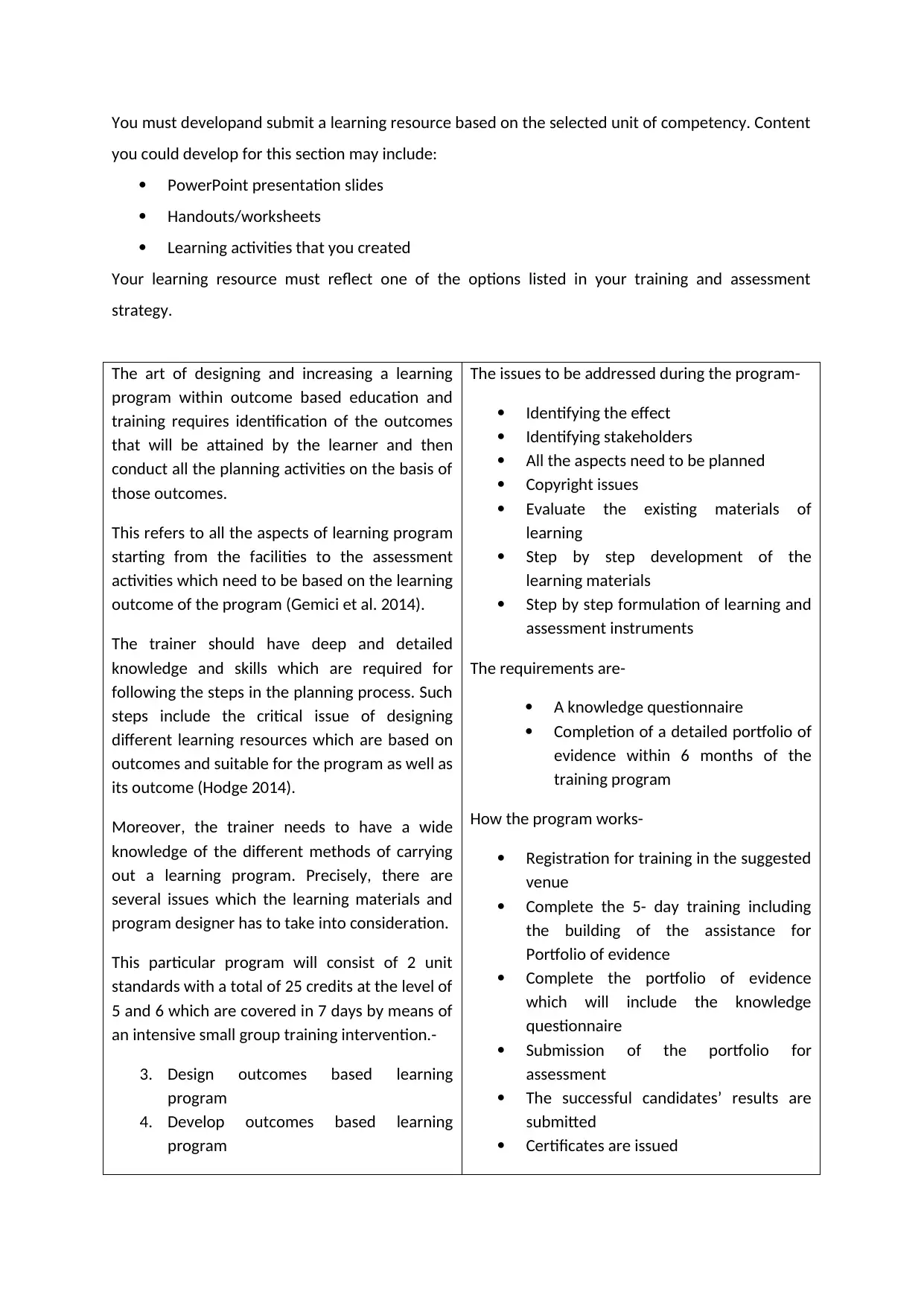
You must developand submit a learning resource based on the selected unit of competency. Content
you could develop for this section may include:
PowerPoint presentation slides
Handouts/worksheets
Learning activities that you created
Your learning resource must reflect one of the options listed in your training and assessment
strategy.
The art of designing and increasing a learning
program within outcome based education and
training requires identification of the outcomes
that will be attained by the learner and then
conduct all the planning activities on the basis of
those outcomes.
This refers to all the aspects of learning program
starting from the facilities to the assessment
activities which need to be based on the learning
outcome of the program (Gemici et al. 2014).
The trainer should have deep and detailed
knowledge and skills which are required for
following the steps in the planning process. Such
steps include the critical issue of designing
different learning resources which are based on
outcomes and suitable for the program as well as
its outcome (Hodge 2014).
Moreover, the trainer needs to have a wide
knowledge of the different methods of carrying
out a learning program. Precisely, there are
several issues which the learning materials and
program designer has to take into consideration.
This particular program will consist of 2 unit
standards with a total of 25 credits at the level of
5 and 6 which are covered in 7 days by means of
an intensive small group training intervention.-
3. Design outcomes based learning
program
4. Develop outcomes based learning
program
The issues to be addressed during the program-
Identifying the effect
Identifying stakeholders
All the aspects need to be planned
Copyright issues
Evaluate the existing materials of
learning
Step by step development of the
learning materials
Step by step formulation of learning and
assessment instruments
The requirements are-
A knowledge questionnaire
Completion of a detailed portfolio of
evidence within 6 months of the
training program
How the program works-
Registration for training in the suggested
venue
Complete the 5- day training including
the building of the assistance for
Portfolio of evidence
Complete the portfolio of evidence
which will include the knowledge
questionnaire
Submission of the portfolio for
assessment
The successful candidates’ results are
submitted
Certificates are issued
you could develop for this section may include:
PowerPoint presentation slides
Handouts/worksheets
Learning activities that you created
Your learning resource must reflect one of the options listed in your training and assessment
strategy.
The art of designing and increasing a learning
program within outcome based education and
training requires identification of the outcomes
that will be attained by the learner and then
conduct all the planning activities on the basis of
those outcomes.
This refers to all the aspects of learning program
starting from the facilities to the assessment
activities which need to be based on the learning
outcome of the program (Gemici et al. 2014).
The trainer should have deep and detailed
knowledge and skills which are required for
following the steps in the planning process. Such
steps include the critical issue of designing
different learning resources which are based on
outcomes and suitable for the program as well as
its outcome (Hodge 2014).
Moreover, the trainer needs to have a wide
knowledge of the different methods of carrying
out a learning program. Precisely, there are
several issues which the learning materials and
program designer has to take into consideration.
This particular program will consist of 2 unit
standards with a total of 25 credits at the level of
5 and 6 which are covered in 7 days by means of
an intensive small group training intervention.-
3. Design outcomes based learning
program
4. Develop outcomes based learning
program
The issues to be addressed during the program-
Identifying the effect
Identifying stakeholders
All the aspects need to be planned
Copyright issues
Evaluate the existing materials of
learning
Step by step development of the
learning materials
Step by step formulation of learning and
assessment instruments
The requirements are-
A knowledge questionnaire
Completion of a detailed portfolio of
evidence within 6 months of the
training program
How the program works-
Registration for training in the suggested
venue
Complete the 5- day training including
the building of the assistance for
Portfolio of evidence
Complete the portfolio of evidence
which will include the knowledge
questionnaire
Submission of the portfolio for
assessment
The successful candidates’ results are
submitted
Certificates are issued
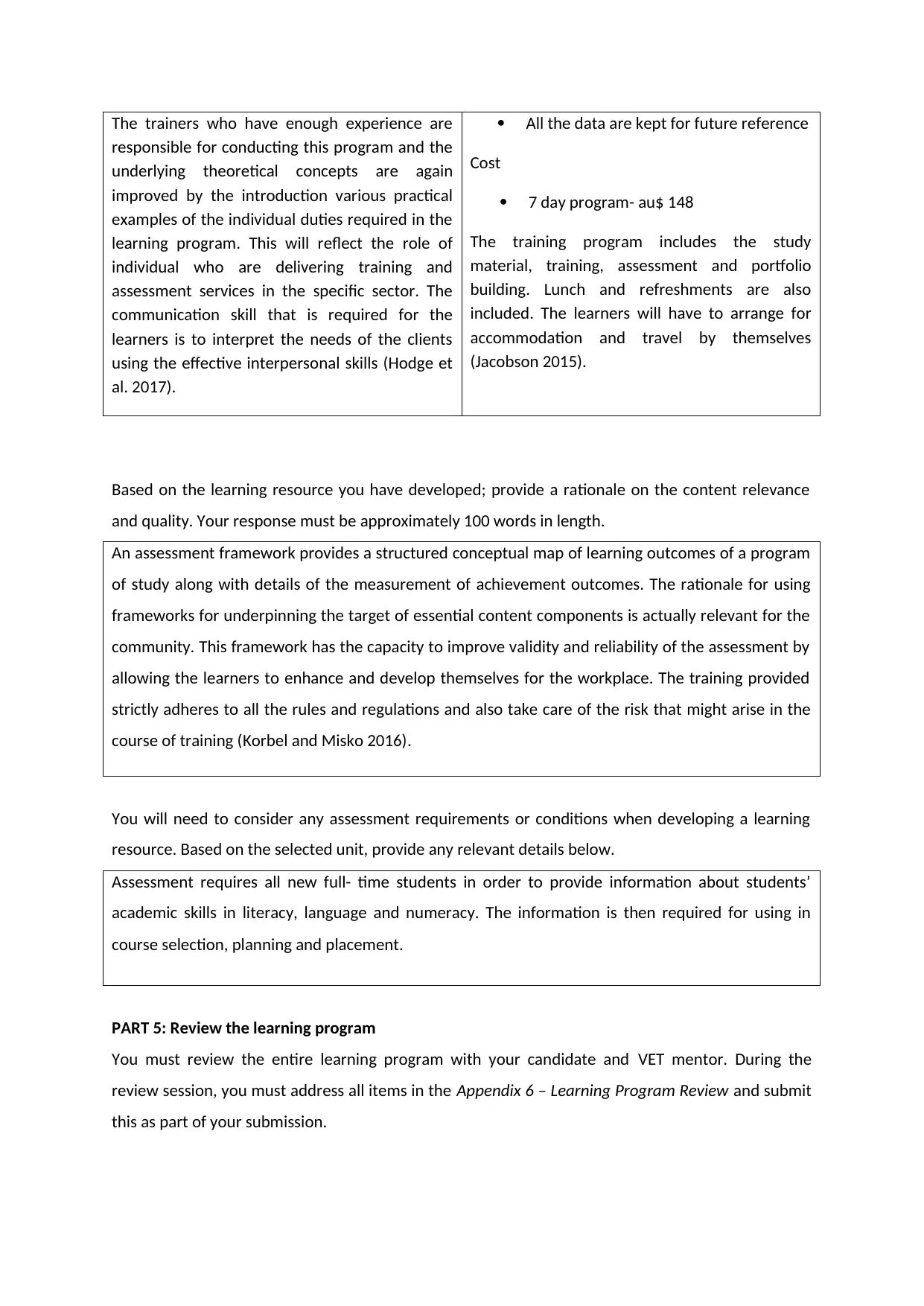
The trainers who have enough experience are
responsible for conducting this program and the
underlying theoretical concepts are again
improved by the introduction various practical
examples of the individual duties required in the
learning program. This will reflect the role of
individual who are delivering training and
assessment services in the specific sector. The
communication skill that is required for the
learners is to interpret the needs of the clients
using the effective interpersonal skills (Hodge et
al. 2017).
All the data are kept for future reference
Cost
7 day program- au$ 148
The training program includes the study
material, training, assessment and portfolio
building. Lunch and refreshments are also
included. The learners will have to arrange for
accommodation and travel by themselves
(Jacobson 2015).
Based on the learning resource you have developed; provide a rationale on the content relevance
and quality. Your response must be approximately 100 words in length.
An assessment framework provides a structured conceptual map of learning outcomes of a program
of study along with details of the measurement of achievement outcomes. The rationale for using
frameworks for underpinning the target of essential content components is actually relevant for the
community. This framework has the capacity to improve validity and reliability of the assessment by
allowing the learners to enhance and develop themselves for the workplace. The training provided
strictly adheres to all the rules and regulations and also take care of the risk that might arise in the
course of training (Korbel and Misko 2016).
You will need to consider any assessment requirements or conditions when developing a learning
resource. Based on the selected unit, provide any relevant details below.
Assessment requires all new full- time students in order to provide information about students’
academic skills in literacy, language and numeracy. The information is then required for using in
course selection, planning and placement.
PART 5: Review the learning program
You must review the entire learning program with your candidate and VET mentor. During the
review session, you must address all items in the Appendix 6 – Learning Program Review and submit
this as part of your submission.
responsible for conducting this program and the
underlying theoretical concepts are again
improved by the introduction various practical
examples of the individual duties required in the
learning program. This will reflect the role of
individual who are delivering training and
assessment services in the specific sector. The
communication skill that is required for the
learners is to interpret the needs of the clients
using the effective interpersonal skills (Hodge et
al. 2017).
All the data are kept for future reference
Cost
7 day program- au$ 148
The training program includes the study
material, training, assessment and portfolio
building. Lunch and refreshments are also
included. The learners will have to arrange for
accommodation and travel by themselves
(Jacobson 2015).
Based on the learning resource you have developed; provide a rationale on the content relevance
and quality. Your response must be approximately 100 words in length.
An assessment framework provides a structured conceptual map of learning outcomes of a program
of study along with details of the measurement of achievement outcomes. The rationale for using
frameworks for underpinning the target of essential content components is actually relevant for the
community. This framework has the capacity to improve validity and reliability of the assessment by
allowing the learners to enhance and develop themselves for the workplace. The training provided
strictly adheres to all the rules and regulations and also take care of the risk that might arise in the
course of training (Korbel and Misko 2016).
You will need to consider any assessment requirements or conditions when developing a learning
resource. Based on the selected unit, provide any relevant details below.
Assessment requires all new full- time students in order to provide information about students’
academic skills in literacy, language and numeracy. The information is then required for using in
course selection, planning and placement.
PART 5: Review the learning program
You must review the entire learning program with your candidate and VET mentor. During the
review session, you must address all items in the Appendix 6 – Learning Program Review and submit
this as part of your submission.
Secure Best Marks with AI Grader
Need help grading? Try our AI Grader for instant feedback on your assignments.
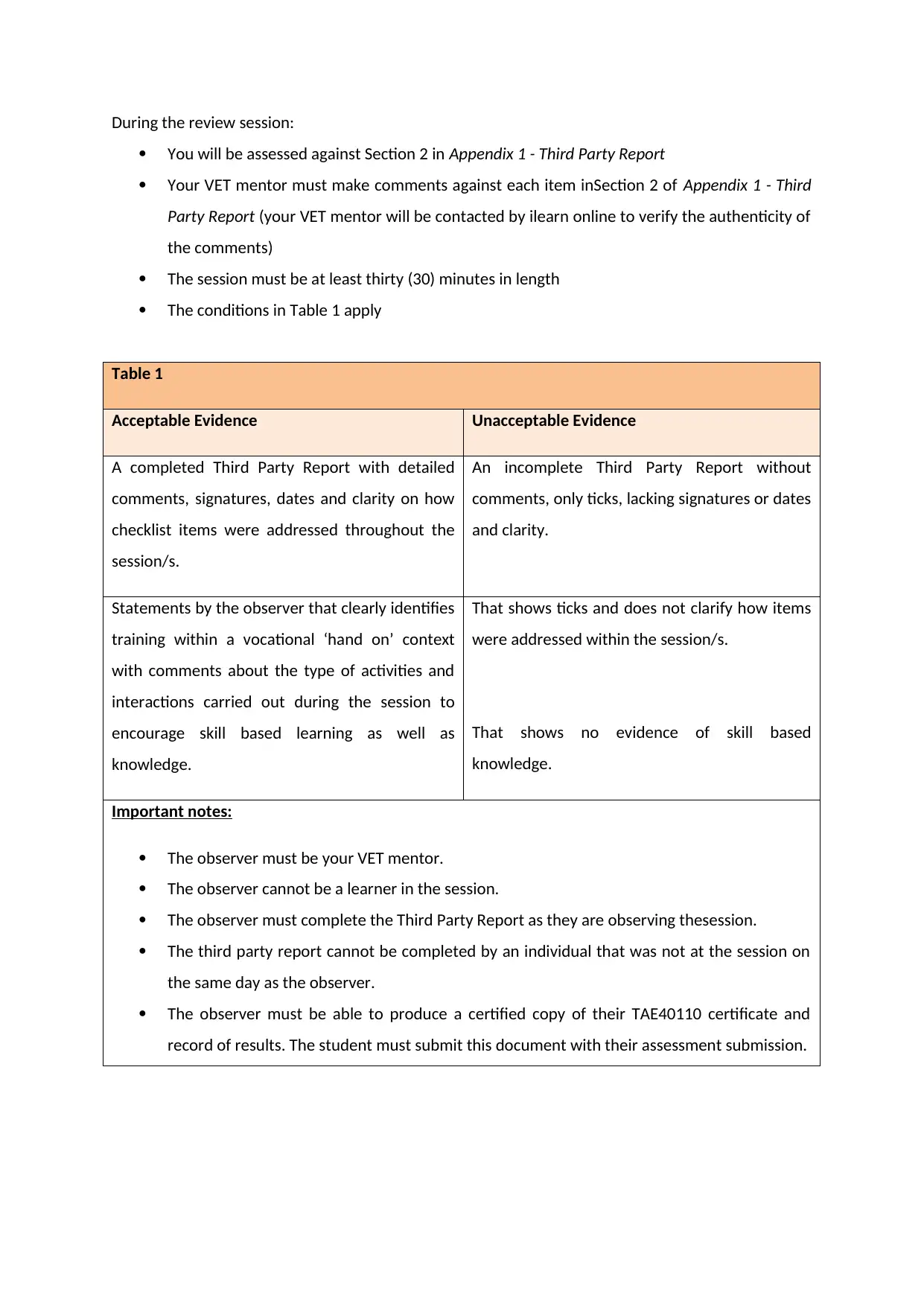
During the review session:
You will be assessed against Section 2 in Appendix 1 - Third Party Report
Your VET mentor must make comments against each item inSection 2 of Appendix 1 - Third
Party Report (your VET mentor will be contacted by ilearn online to verify the authenticity of
the comments)
The session must be at least thirty (30) minutes in length
The conditions in Table 1 apply
Table 1
Acceptable Evidence Unacceptable Evidence
A completed Third Party Report with detailed
comments, signatures, dates and clarity on how
checklist items were addressed throughout the
session/s.
An incomplete Third Party Report without
comments, only ticks, lacking signatures or dates
and clarity.
Statements by the observer that clearly identifies
training within a vocational ‘hand on’ context
with comments about the type of activities and
interactions carried out during the session to
encourage skill based learning as well as
knowledge.
That shows ticks and does not clarify how items
were addressed within the session/s.
That shows no evidence of skill based
knowledge.
Important notes:
The observer must be your VET mentor.
The observer cannot be a learner in the session.
The observer must complete the Third Party Report as they are observing thesession.
The third party report cannot be completed by an individual that was not at the session on
the same day as the observer.
The observer must be able to produce a certified copy of their TAE40110 certificate and
record of results. The student must submit this document with their assessment submission.
You will be assessed against Section 2 in Appendix 1 - Third Party Report
Your VET mentor must make comments against each item inSection 2 of Appendix 1 - Third
Party Report (your VET mentor will be contacted by ilearn online to verify the authenticity of
the comments)
The session must be at least thirty (30) minutes in length
The conditions in Table 1 apply
Table 1
Acceptable Evidence Unacceptable Evidence
A completed Third Party Report with detailed
comments, signatures, dates and clarity on how
checklist items were addressed throughout the
session/s.
An incomplete Third Party Report without
comments, only ticks, lacking signatures or dates
and clarity.
Statements by the observer that clearly identifies
training within a vocational ‘hand on’ context
with comments about the type of activities and
interactions carried out during the session to
encourage skill based learning as well as
knowledge.
That shows ticks and does not clarify how items
were addressed within the session/s.
That shows no evidence of skill based
knowledge.
Important notes:
The observer must be your VET mentor.
The observer cannot be a learner in the session.
The observer must complete the Third Party Report as they are observing thesession.
The third party report cannot be completed by an individual that was not at the session on
the same day as the observer.
The observer must be able to produce a certified copy of their TAE40110 certificate and
record of results. The student must submit this document with their assessment submission.
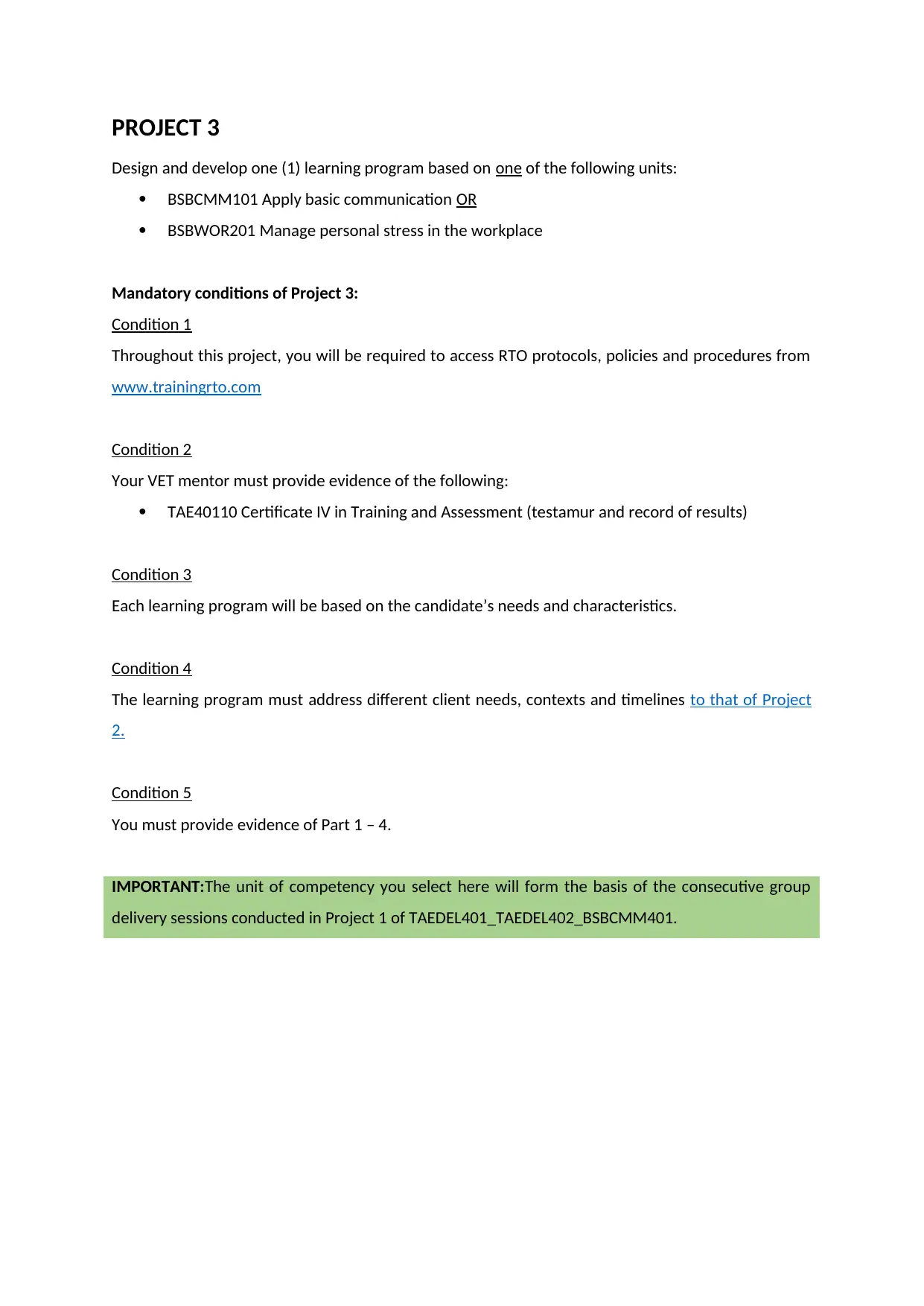
PROJECT 3
Design and develop one (1) learning program based on one of the following units:
BSBCMM101 Apply basic communication OR
BSBWOR201 Manage personal stress in the workplace
Mandatory conditions of Project 3:
Condition 1
Throughout this project, you will be required to access RTO protocols, policies and procedures from
www.trainingrto.com
Condition 2
Your VET mentor must provide evidence of the following:
TAE40110 Certificate IV in Training and Assessment (testamur and record of results)
Condition 3
Each learning program will be based on the candidate’s needs and characteristics.
Condition 4
The learning program must address different client needs, contexts and timelines to that of Project
2.
Condition 5
You must provide evidence of Part 1 – 4.
IMPORTANT:The unit of competency you select here will form the basis of the consecutive group
delivery sessions conducted in Project 1 of TAEDEL401_TAEDEL402_BSBCMM401.
Design and develop one (1) learning program based on one of the following units:
BSBCMM101 Apply basic communication OR
BSBWOR201 Manage personal stress in the workplace
Mandatory conditions of Project 3:
Condition 1
Throughout this project, you will be required to access RTO protocols, policies and procedures from
www.trainingrto.com
Condition 2
Your VET mentor must provide evidence of the following:
TAE40110 Certificate IV in Training and Assessment (testamur and record of results)
Condition 3
Each learning program will be based on the candidate’s needs and characteristics.
Condition 4
The learning program must address different client needs, contexts and timelines to that of Project
2.
Condition 5
You must provide evidence of Part 1 – 4.
IMPORTANT:The unit of competency you select here will form the basis of the consecutive group
delivery sessions conducted in Project 1 of TAEDEL401_TAEDEL402_BSBCMM401.
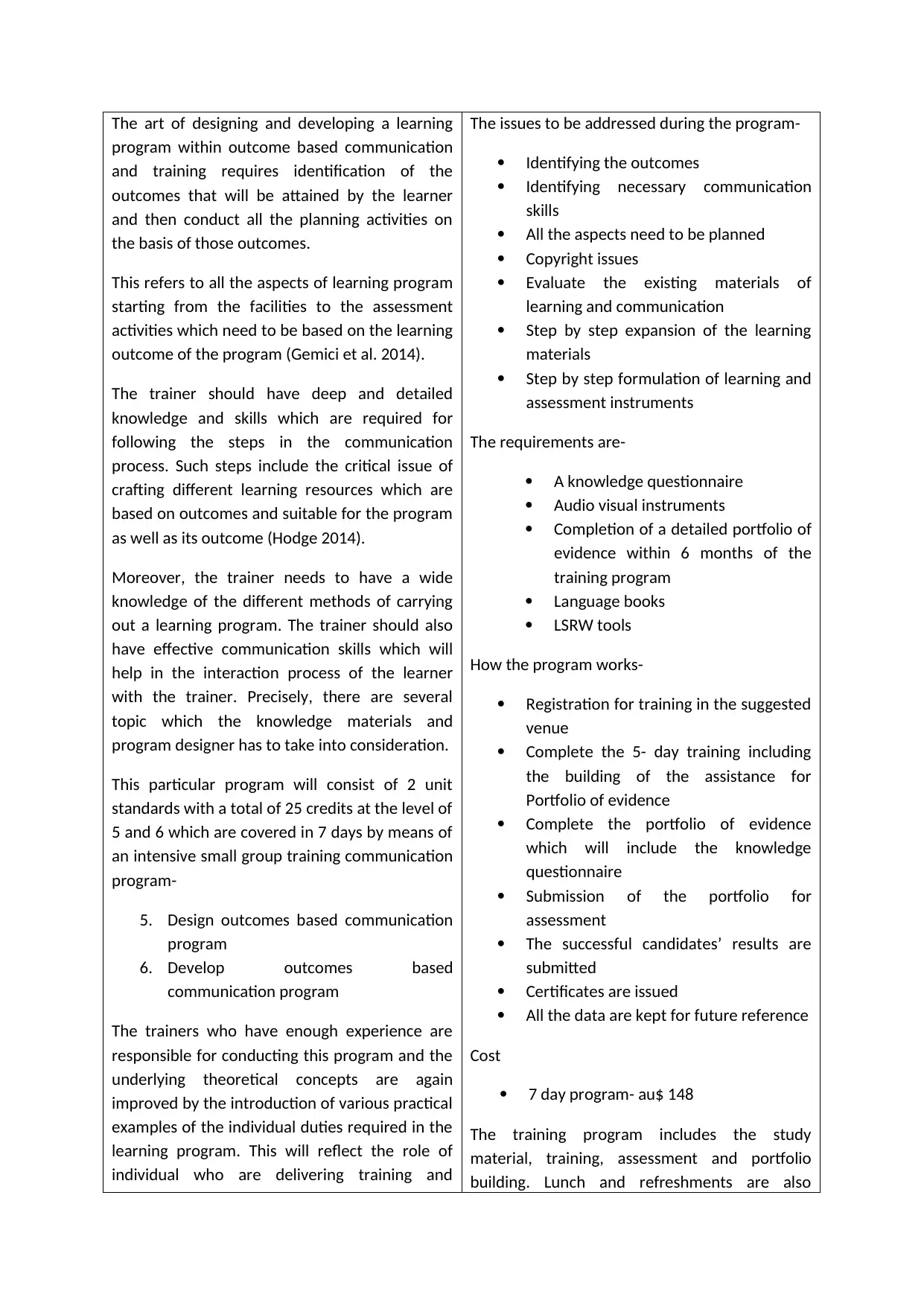
The art of designing and developing a learning
program within outcome based communication
and training requires identification of the
outcomes that will be attained by the learner
and then conduct all the planning activities on
the basis of those outcomes.
This refers to all the aspects of learning program
starting from the facilities to the assessment
activities which need to be based on the learning
outcome of the program (Gemici et al. 2014).
The trainer should have deep and detailed
knowledge and skills which are required for
following the steps in the communication
process. Such steps include the critical issue of
crafting different learning resources which are
based on outcomes and suitable for the program
as well as its outcome (Hodge 2014).
Moreover, the trainer needs to have a wide
knowledge of the different methods of carrying
out a learning program. The trainer should also
have effective communication skills which will
help in the interaction process of the learner
with the trainer. Precisely, there are several
topic which the knowledge materials and
program designer has to take into consideration.
This particular program will consist of 2 unit
standards with a total of 25 credits at the level of
5 and 6 which are covered in 7 days by means of
an intensive small group training communication
program-
5. Design outcomes based communication
program
6. Develop outcomes based
communication program
The trainers who have enough experience are
responsible for conducting this program and the
underlying theoretical concepts are again
improved by the introduction of various practical
examples of the individual duties required in the
learning program. This will reflect the role of
individual who are delivering training and
The issues to be addressed during the program-
Identifying the outcomes
Identifying necessary communication
skills
All the aspects need to be planned
Copyright issues
Evaluate the existing materials of
learning and communication
Step by step expansion of the learning
materials
Step by step formulation of learning and
assessment instruments
The requirements are-
A knowledge questionnaire
Audio visual instruments
Completion of a detailed portfolio of
evidence within 6 months of the
training program
Language books
LSRW tools
How the program works-
Registration for training in the suggested
venue
Complete the 5- day training including
the building of the assistance for
Portfolio of evidence
Complete the portfolio of evidence
which will include the knowledge
questionnaire
Submission of the portfolio for
assessment
The successful candidates’ results are
submitted
Certificates are issued
All the data are kept for future reference
Cost
7 day program- au$ 148
The training program includes the study
material, training, assessment and portfolio
building. Lunch and refreshments are also
program within outcome based communication
and training requires identification of the
outcomes that will be attained by the learner
and then conduct all the planning activities on
the basis of those outcomes.
This refers to all the aspects of learning program
starting from the facilities to the assessment
activities which need to be based on the learning
outcome of the program (Gemici et al. 2014).
The trainer should have deep and detailed
knowledge and skills which are required for
following the steps in the communication
process. Such steps include the critical issue of
crafting different learning resources which are
based on outcomes and suitable for the program
as well as its outcome (Hodge 2014).
Moreover, the trainer needs to have a wide
knowledge of the different methods of carrying
out a learning program. The trainer should also
have effective communication skills which will
help in the interaction process of the learner
with the trainer. Precisely, there are several
topic which the knowledge materials and
program designer has to take into consideration.
This particular program will consist of 2 unit
standards with a total of 25 credits at the level of
5 and 6 which are covered in 7 days by means of
an intensive small group training communication
program-
5. Design outcomes based communication
program
6. Develop outcomes based
communication program
The trainers who have enough experience are
responsible for conducting this program and the
underlying theoretical concepts are again
improved by the introduction of various practical
examples of the individual duties required in the
learning program. This will reflect the role of
individual who are delivering training and
The issues to be addressed during the program-
Identifying the outcomes
Identifying necessary communication
skills
All the aspects need to be planned
Copyright issues
Evaluate the existing materials of
learning and communication
Step by step expansion of the learning
materials
Step by step formulation of learning and
assessment instruments
The requirements are-
A knowledge questionnaire
Audio visual instruments
Completion of a detailed portfolio of
evidence within 6 months of the
training program
Language books
LSRW tools
How the program works-
Registration for training in the suggested
venue
Complete the 5- day training including
the building of the assistance for
Portfolio of evidence
Complete the portfolio of evidence
which will include the knowledge
questionnaire
Submission of the portfolio for
assessment
The successful candidates’ results are
submitted
Certificates are issued
All the data are kept for future reference
Cost
7 day program- au$ 148
The training program includes the study
material, training, assessment and portfolio
building. Lunch and refreshments are also
Paraphrase This Document
Need a fresh take? Get an instant paraphrase of this document with our AI Paraphraser
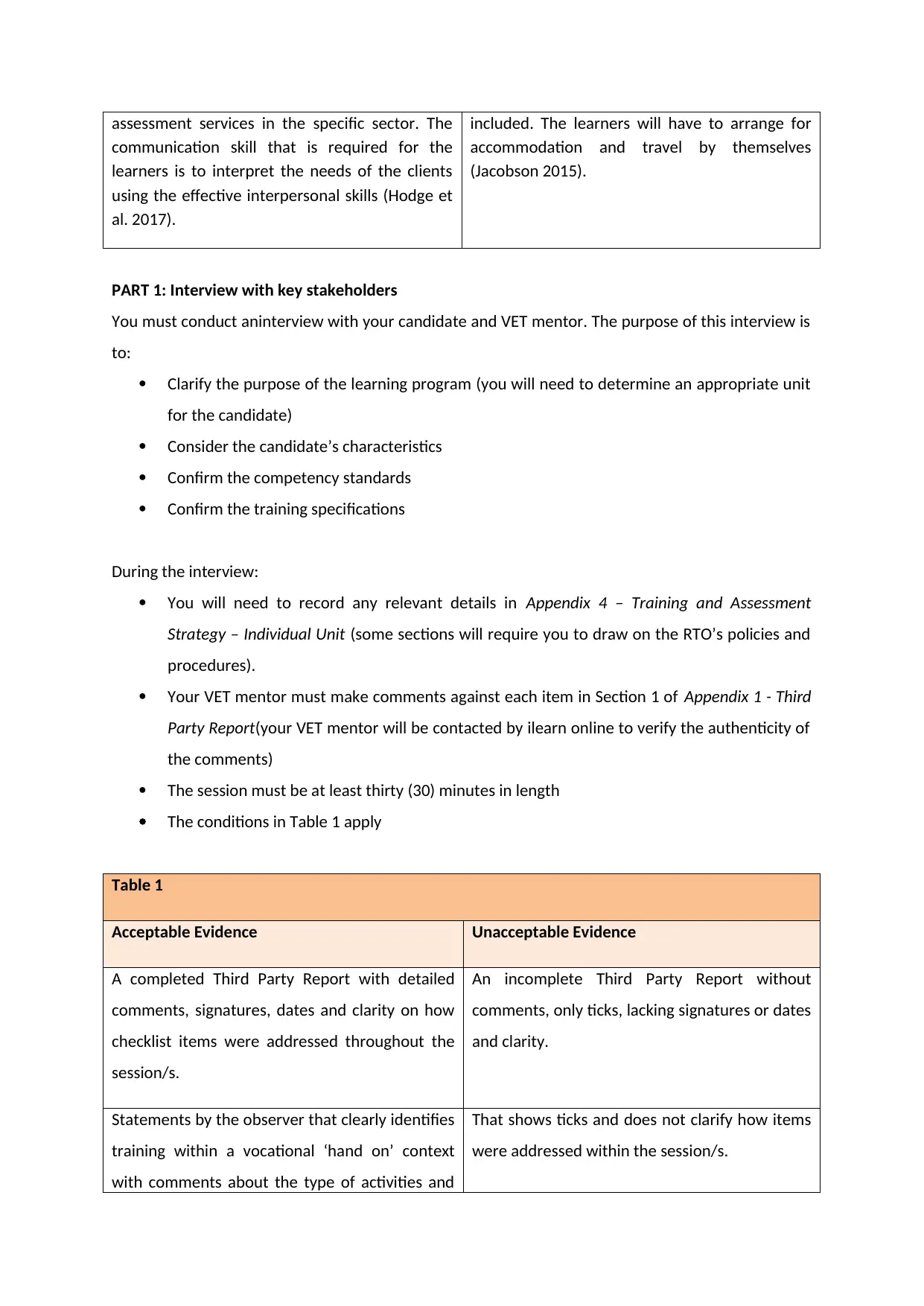
assessment services in the specific sector. The
communication skill that is required for the
learners is to interpret the needs of the clients
using the effective interpersonal skills (Hodge et
al. 2017).
included. The learners will have to arrange for
accommodation and travel by themselves
(Jacobson 2015).
PART 1: Interview with key stakeholders
You must conduct aninterview with your candidate and VET mentor. The purpose of this interview is
to:
Clarify the purpose of the learning program (you will need to determine an appropriate unit
for the candidate)
Consider the candidate’s characteristics
Confirm the competency standards
Confirm the training specifications
During the interview:
You will need to record any relevant details in Appendix 4 – Training and Assessment
Strategy – Individual Unit (some sections will require you to draw on the RTO’s policies and
procedures).
Your VET mentor must make comments against each item in Section 1 of Appendix 1 - Third
Party Report(your VET mentor will be contacted by ilearn online to verify the authenticity of
the comments)
The session must be at least thirty (30) minutes in length
The conditions in Table 1 apply
Table 1
Acceptable Evidence Unacceptable Evidence
A completed Third Party Report with detailed
comments, signatures, dates and clarity on how
checklist items were addressed throughout the
session/s.
An incomplete Third Party Report without
comments, only ticks, lacking signatures or dates
and clarity.
Statements by the observer that clearly identifies
training within a vocational ‘hand on’ context
with comments about the type of activities and
That shows ticks and does not clarify how items
were addressed within the session/s.
communication skill that is required for the
learners is to interpret the needs of the clients
using the effective interpersonal skills (Hodge et
al. 2017).
included. The learners will have to arrange for
accommodation and travel by themselves
(Jacobson 2015).
PART 1: Interview with key stakeholders
You must conduct aninterview with your candidate and VET mentor. The purpose of this interview is
to:
Clarify the purpose of the learning program (you will need to determine an appropriate unit
for the candidate)
Consider the candidate’s characteristics
Confirm the competency standards
Confirm the training specifications
During the interview:
You will need to record any relevant details in Appendix 4 – Training and Assessment
Strategy – Individual Unit (some sections will require you to draw on the RTO’s policies and
procedures).
Your VET mentor must make comments against each item in Section 1 of Appendix 1 - Third
Party Report(your VET mentor will be contacted by ilearn online to verify the authenticity of
the comments)
The session must be at least thirty (30) minutes in length
The conditions in Table 1 apply
Table 1
Acceptable Evidence Unacceptable Evidence
A completed Third Party Report with detailed
comments, signatures, dates and clarity on how
checklist items were addressed throughout the
session/s.
An incomplete Third Party Report without
comments, only ticks, lacking signatures or dates
and clarity.
Statements by the observer that clearly identifies
training within a vocational ‘hand on’ context
with comments about the type of activities and
That shows ticks and does not clarify how items
were addressed within the session/s.
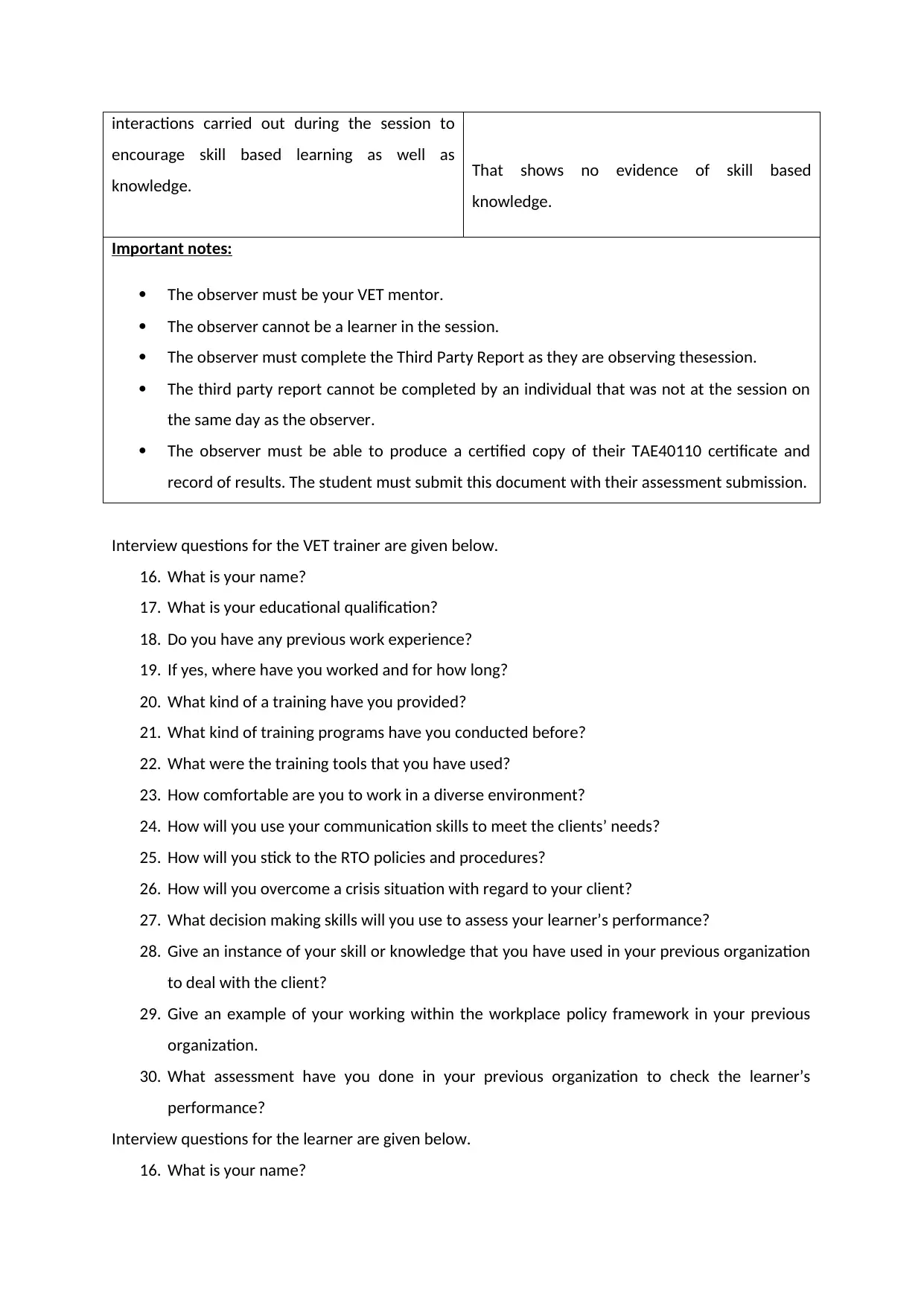
interactions carried out during the session to
encourage skill based learning as well as
knowledge. That shows no evidence of skill based
knowledge.
Important notes:
The observer must be your VET mentor.
The observer cannot be a learner in the session.
The observer must complete the Third Party Report as they are observing thesession.
The third party report cannot be completed by an individual that was not at the session on
the same day as the observer.
The observer must be able to produce a certified copy of their TAE40110 certificate and
record of results. The student must submit this document with their assessment submission.
Interview questions for the VET trainer are given below.
16. What is your name?
17. What is your educational qualification?
18. Do you have any previous work experience?
19. If yes, where have you worked and for how long?
20. What kind of a training have you provided?
21. What kind of training programs have you conducted before?
22. What were the training tools that you have used?
23. How comfortable are you to work in a diverse environment?
24. How will you use your communication skills to meet the clients’ needs?
25. How will you stick to the RTO policies and procedures?
26. How will you overcome a crisis situation with regard to your client?
27. What decision making skills will you use to assess your learner’s performance?
28. Give an instance of your skill or knowledge that you have used in your previous organization
to deal with the client?
29. Give an example of your working within the workplace policy framework in your previous
organization.
30. What assessment have you done in your previous organization to check the learner’s
performance?
Interview questions for the learner are given below.
16. What is your name?
encourage skill based learning as well as
knowledge. That shows no evidence of skill based
knowledge.
Important notes:
The observer must be your VET mentor.
The observer cannot be a learner in the session.
The observer must complete the Third Party Report as they are observing thesession.
The third party report cannot be completed by an individual that was not at the session on
the same day as the observer.
The observer must be able to produce a certified copy of their TAE40110 certificate and
record of results. The student must submit this document with their assessment submission.
Interview questions for the VET trainer are given below.
16. What is your name?
17. What is your educational qualification?
18. Do you have any previous work experience?
19. If yes, where have you worked and for how long?
20. What kind of a training have you provided?
21. What kind of training programs have you conducted before?
22. What were the training tools that you have used?
23. How comfortable are you to work in a diverse environment?
24. How will you use your communication skills to meet the clients’ needs?
25. How will you stick to the RTO policies and procedures?
26. How will you overcome a crisis situation with regard to your client?
27. What decision making skills will you use to assess your learner’s performance?
28. Give an instance of your skill or knowledge that you have used in your previous organization
to deal with the client?
29. Give an example of your working within the workplace policy framework in your previous
organization.
30. What assessment have you done in your previous organization to check the learner’s
performance?
Interview questions for the learner are given below.
16. What is your name?
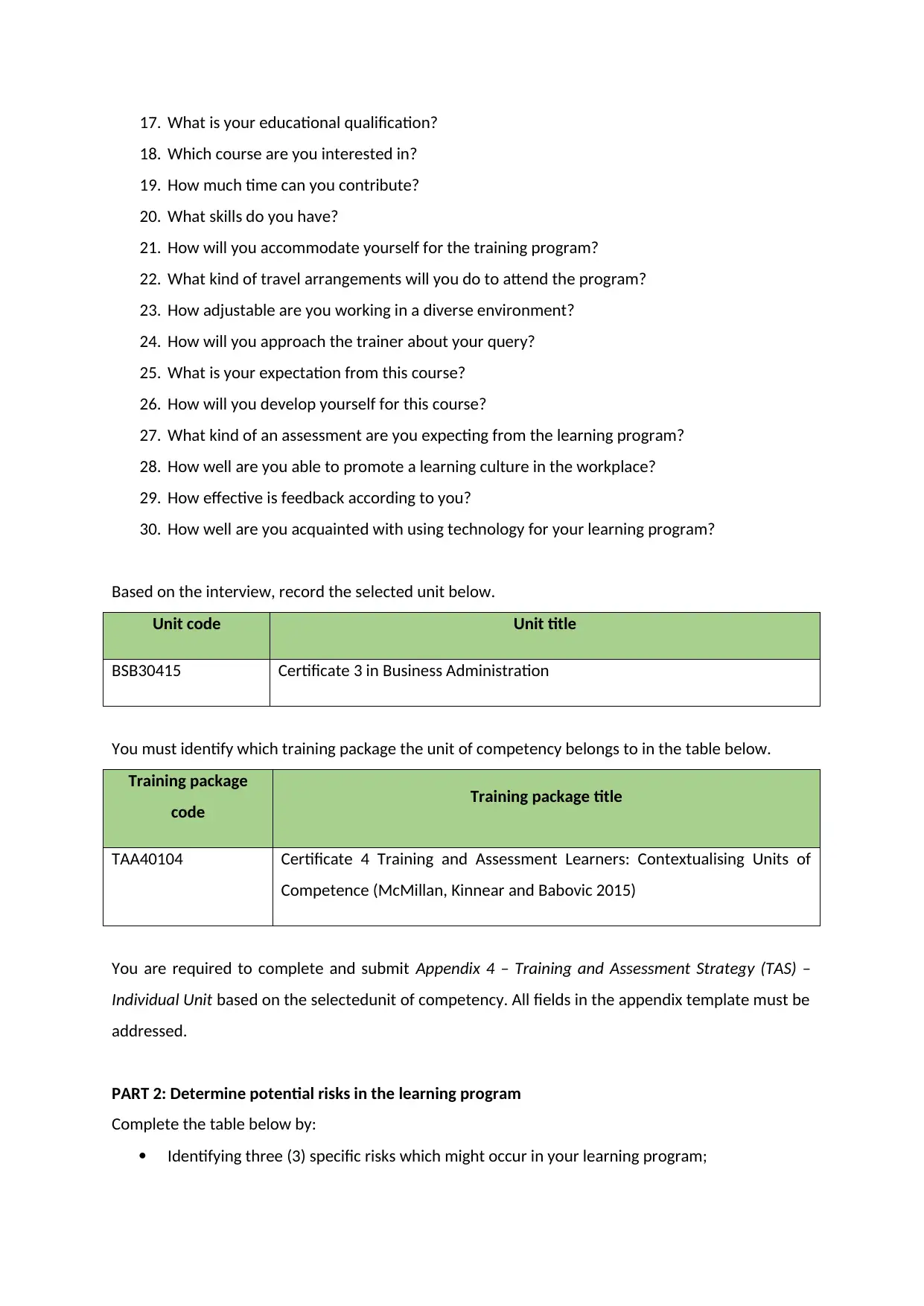
17. What is your educational qualification?
18. Which course are you interested in?
19. How much time can you contribute?
20. What skills do you have?
21. How will you accommodate yourself for the training program?
22. What kind of travel arrangements will you do to attend the program?
23. How adjustable are you working in a diverse environment?
24. How will you approach the trainer about your query?
25. What is your expectation from this course?
26. How will you develop yourself for this course?
27. What kind of an assessment are you expecting from the learning program?
28. How well are you able to promote a learning culture in the workplace?
29. How effective is feedback according to you?
30. How well are you acquainted with using technology for your learning program?
Based on the interview, record the selected unit below.
Unit code Unit title
BSB30415 Certificate 3 in Business Administration
You must identify which training package the unit of competency belongs to in the table below.
Training package
code Training package title
TAA40104 Certificate 4 Training and Assessment Learners: Contextualising Units of
Competence (McMillan, Kinnear and Babovic 2015)
You are required to complete and submit Appendix 4 – Training and Assessment Strategy (TAS) –
Individual Unit based on the selectedunit of competency. All fields in the appendix template must be
addressed.
PART 2: Determine potential risks in the learning program
Complete the table below by:
Identifying three (3) specific risks which might occur in your learning program;
18. Which course are you interested in?
19. How much time can you contribute?
20. What skills do you have?
21. How will you accommodate yourself for the training program?
22. What kind of travel arrangements will you do to attend the program?
23. How adjustable are you working in a diverse environment?
24. How will you approach the trainer about your query?
25. What is your expectation from this course?
26. How will you develop yourself for this course?
27. What kind of an assessment are you expecting from the learning program?
28. How well are you able to promote a learning culture in the workplace?
29. How effective is feedback according to you?
30. How well are you acquainted with using technology for your learning program?
Based on the interview, record the selected unit below.
Unit code Unit title
BSB30415 Certificate 3 in Business Administration
You must identify which training package the unit of competency belongs to in the table below.
Training package
code Training package title
TAA40104 Certificate 4 Training and Assessment Learners: Contextualising Units of
Competence (McMillan, Kinnear and Babovic 2015)
You are required to complete and submit Appendix 4 – Training and Assessment Strategy (TAS) –
Individual Unit based on the selectedunit of competency. All fields in the appendix template must be
addressed.
PART 2: Determine potential risks in the learning program
Complete the table below by:
Identifying three (3) specific risks which might occur in your learning program;
Secure Best Marks with AI Grader
Need help grading? Try our AI Grader for instant feedback on your assignments.
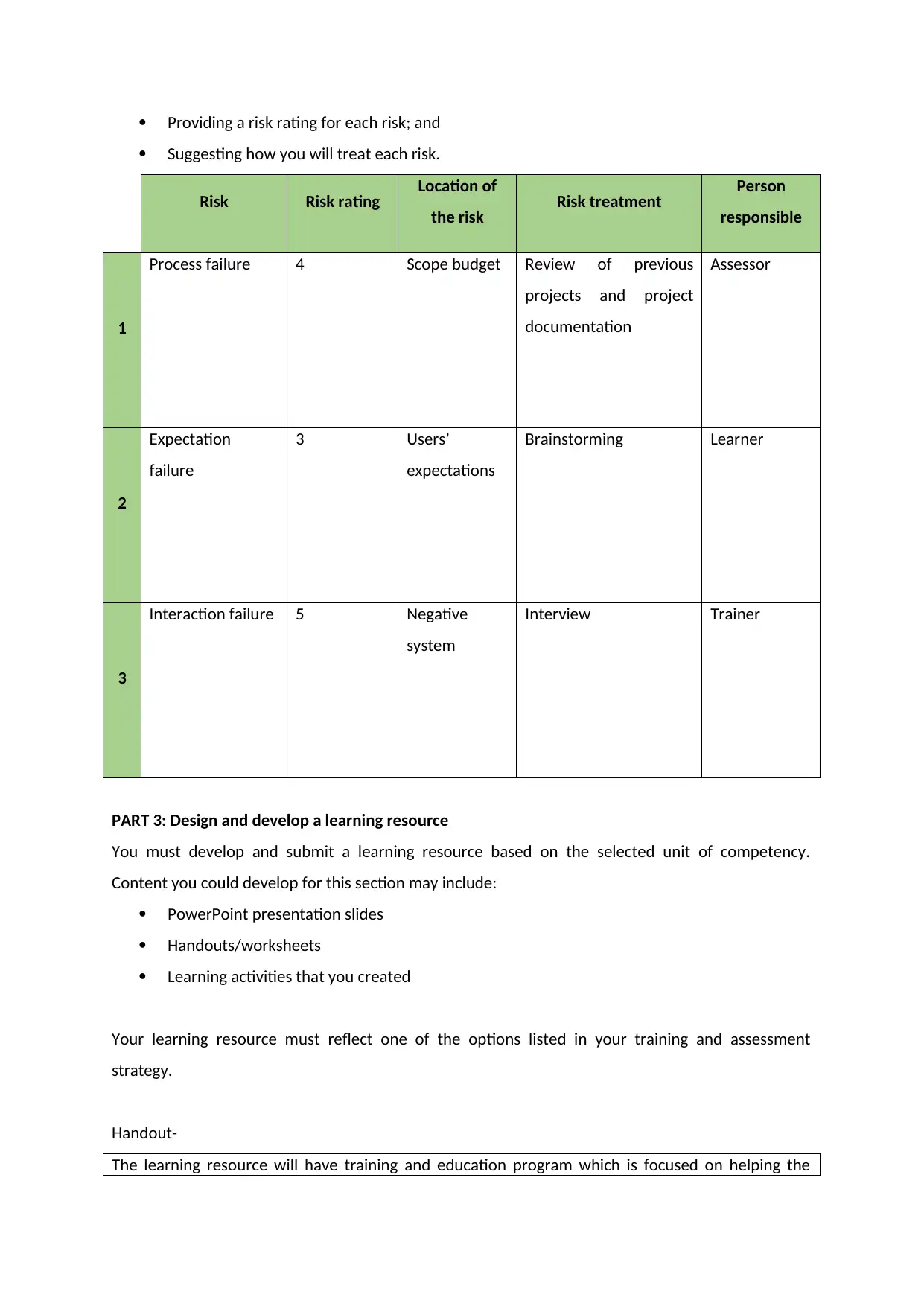
Providing a risk rating for each risk; and
Suggesting how you will treat each risk.
Risk Risk rating Location of
the risk Risk treatment Person
responsible
1
Process failure 4 Scope budget Review of previous
projects and project
documentation
Assessor
2
Expectation
failure
3 Users’
expectations
Brainstorming Learner
3
Interaction failure 5 Negative
system
Interview Trainer
PART 3: Design and develop a learning resource
You must develop and submit a learning resource based on the selected unit of competency.
Content you could develop for this section may include:
PowerPoint presentation slides
Handouts/worksheets
Learning activities that you created
Your learning resource must reflect one of the options listed in your training and assessment
strategy.
Handout-
The learning resource will have training and education program which is focused on helping the
Suggesting how you will treat each risk.
Risk Risk rating Location of
the risk Risk treatment Person
responsible
1
Process failure 4 Scope budget Review of previous
projects and project
documentation
Assessor
2
Expectation
failure
3 Users’
expectations
Brainstorming Learner
3
Interaction failure 5 Negative
system
Interview Trainer
PART 3: Design and develop a learning resource
You must develop and submit a learning resource based on the selected unit of competency.
Content you could develop for this section may include:
PowerPoint presentation slides
Handouts/worksheets
Learning activities that you created
Your learning resource must reflect one of the options listed in your training and assessment
strategy.
Handout-
The learning resource will have training and education program which is focused on helping the
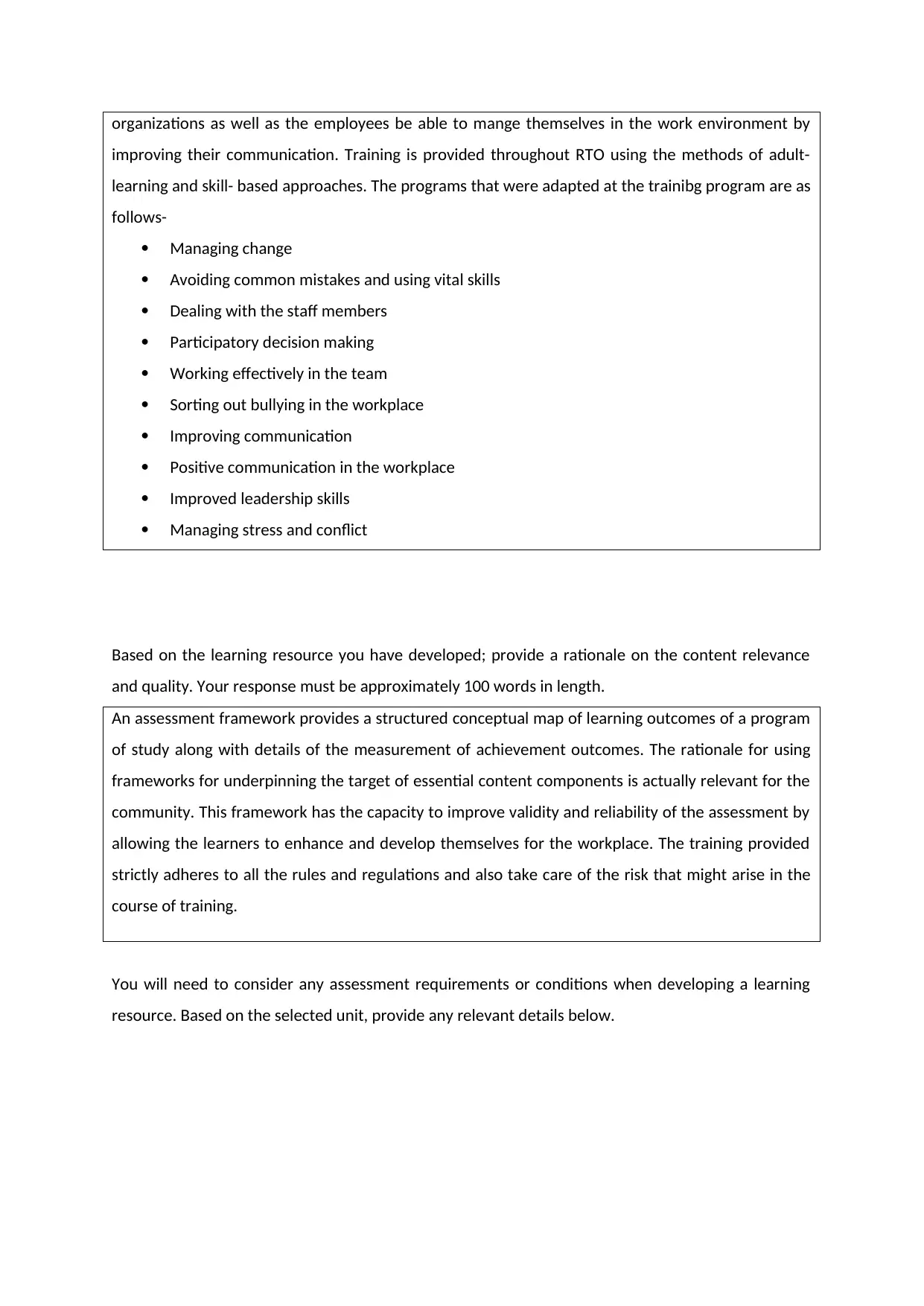
organizations as well as the employees be able to mange themselves in the work environment by
improving their communication. Training is provided throughout RTO using the methods of adult-
learning and skill- based approaches. The programs that were adapted at the trainibg program are as
follows-
Managing change
Avoiding common mistakes and using vital skills
Dealing with the staff members
Participatory decision making
Working effectively in the team
Sorting out bullying in the workplace
Improving communication
Positive communication in the workplace
Improved leadership skills
Managing stress and conflict
Based on the learning resource you have developed; provide a rationale on the content relevance
and quality. Your response must be approximately 100 words in length.
An assessment framework provides a structured conceptual map of learning outcomes of a program
of study along with details of the measurement of achievement outcomes. The rationale for using
frameworks for underpinning the target of essential content components is actually relevant for the
community. This framework has the capacity to improve validity and reliability of the assessment by
allowing the learners to enhance and develop themselves for the workplace. The training provided
strictly adheres to all the rules and regulations and also take care of the risk that might arise in the
course of training.
You will need to consider any assessment requirements or conditions when developing a learning
resource. Based on the selected unit, provide any relevant details below.
improving their communication. Training is provided throughout RTO using the methods of adult-
learning and skill- based approaches. The programs that were adapted at the trainibg program are as
follows-
Managing change
Avoiding common mistakes and using vital skills
Dealing with the staff members
Participatory decision making
Working effectively in the team
Sorting out bullying in the workplace
Improving communication
Positive communication in the workplace
Improved leadership skills
Managing stress and conflict
Based on the learning resource you have developed; provide a rationale on the content relevance
and quality. Your response must be approximately 100 words in length.
An assessment framework provides a structured conceptual map of learning outcomes of a program
of study along with details of the measurement of achievement outcomes. The rationale for using
frameworks for underpinning the target of essential content components is actually relevant for the
community. This framework has the capacity to improve validity and reliability of the assessment by
allowing the learners to enhance and develop themselves for the workplace. The training provided
strictly adheres to all the rules and regulations and also take care of the risk that might arise in the
course of training.
You will need to consider any assessment requirements or conditions when developing a learning
resource. Based on the selected unit, provide any relevant details below.
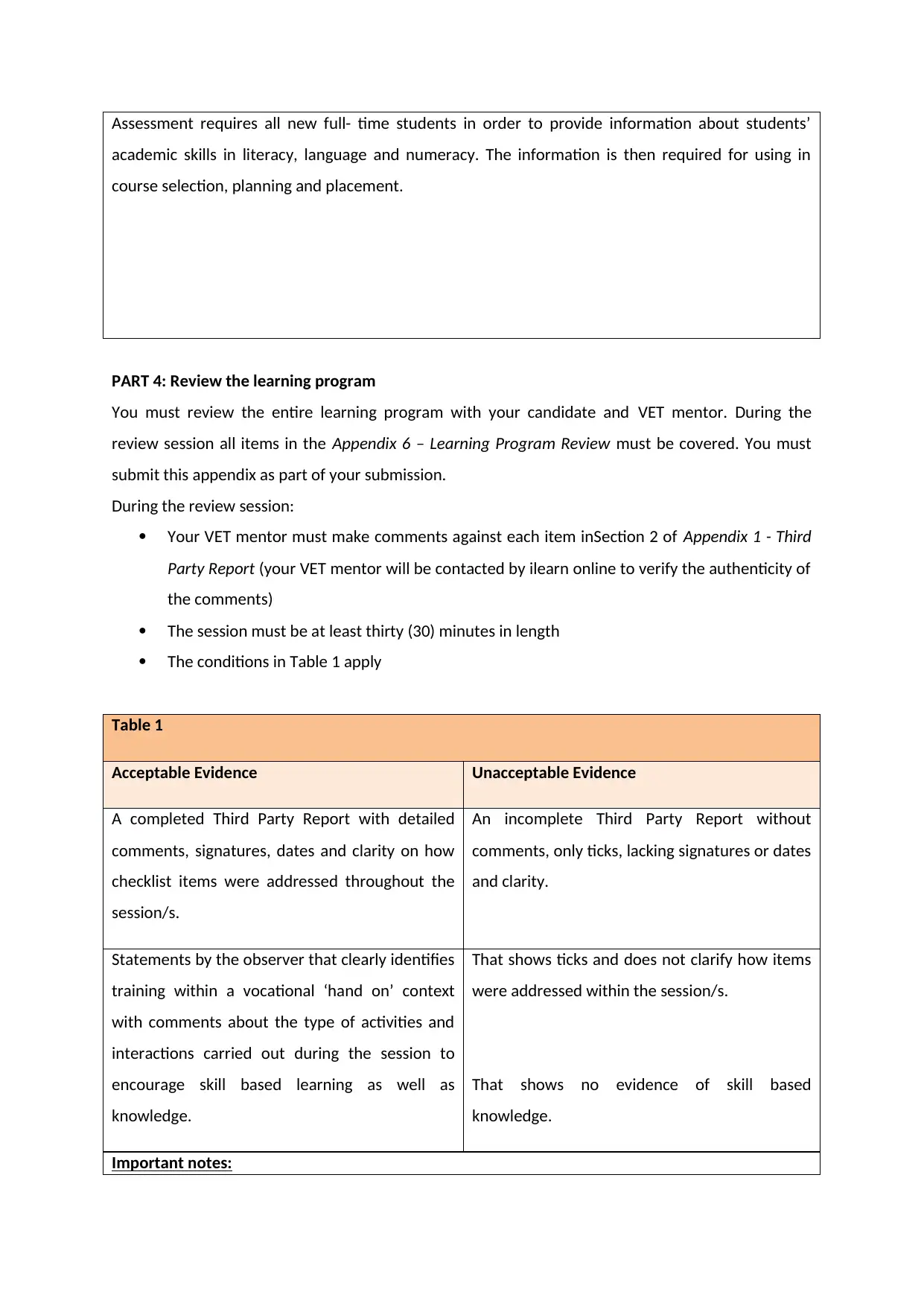
Assessment requires all new full- time students in order to provide information about students’
academic skills in literacy, language and numeracy. The information is then required for using in
course selection, planning and placement.
PART 4: Review the learning program
You must review the entire learning program with your candidate and VET mentor. During the
review session all items in the Appendix 6 – Learning Program Review must be covered. You must
submit this appendix as part of your submission.
During the review session:
Your VET mentor must make comments against each item inSection 2 of Appendix 1 - Third
Party Report (your VET mentor will be contacted by ilearn online to verify the authenticity of
the comments)
The session must be at least thirty (30) minutes in length
The conditions in Table 1 apply
Table 1
Acceptable Evidence Unacceptable Evidence
A completed Third Party Report with detailed
comments, signatures, dates and clarity on how
checklist items were addressed throughout the
session/s.
An incomplete Third Party Report without
comments, only ticks, lacking signatures or dates
and clarity.
Statements by the observer that clearly identifies
training within a vocational ‘hand on’ context
with comments about the type of activities and
interactions carried out during the session to
encourage skill based learning as well as
knowledge.
That shows ticks and does not clarify how items
were addressed within the session/s.
That shows no evidence of skill based
knowledge.
Important notes:
academic skills in literacy, language and numeracy. The information is then required for using in
course selection, planning and placement.
PART 4: Review the learning program
You must review the entire learning program with your candidate and VET mentor. During the
review session all items in the Appendix 6 – Learning Program Review must be covered. You must
submit this appendix as part of your submission.
During the review session:
Your VET mentor must make comments against each item inSection 2 of Appendix 1 - Third
Party Report (your VET mentor will be contacted by ilearn online to verify the authenticity of
the comments)
The session must be at least thirty (30) minutes in length
The conditions in Table 1 apply
Table 1
Acceptable Evidence Unacceptable Evidence
A completed Third Party Report with detailed
comments, signatures, dates and clarity on how
checklist items were addressed throughout the
session/s.
An incomplete Third Party Report without
comments, only ticks, lacking signatures or dates
and clarity.
Statements by the observer that clearly identifies
training within a vocational ‘hand on’ context
with comments about the type of activities and
interactions carried out during the session to
encourage skill based learning as well as
knowledge.
That shows ticks and does not clarify how items
were addressed within the session/s.
That shows no evidence of skill based
knowledge.
Important notes:
Paraphrase This Document
Need a fresh take? Get an instant paraphrase of this document with our AI Paraphraser
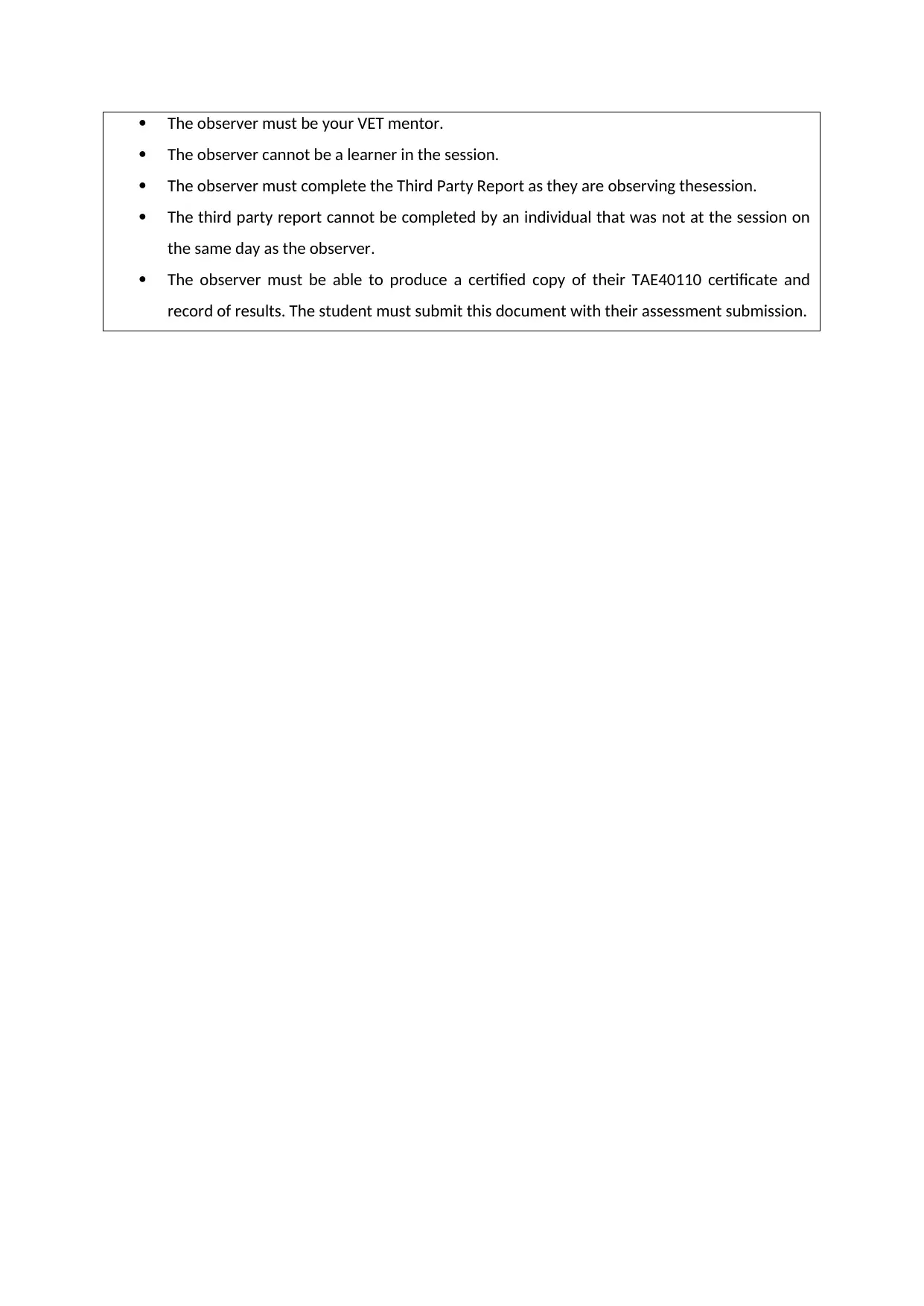
The observer must be your VET mentor.
The observer cannot be a learner in the session.
The observer must complete the Third Party Report as they are observing thesession.
The third party report cannot be completed by an individual that was not at the session on
the same day as the observer.
The observer must be able to produce a certified copy of their TAE40110 certificate and
record of results. The student must submit this document with their assessment submission.
The observer cannot be a learner in the session.
The observer must complete the Third Party Report as they are observing thesession.
The third party report cannot be completed by an individual that was not at the session on
the same day as the observer.
The observer must be able to produce a certified copy of their TAE40110 certificate and
record of results. The student must submit this document with their assessment submission.
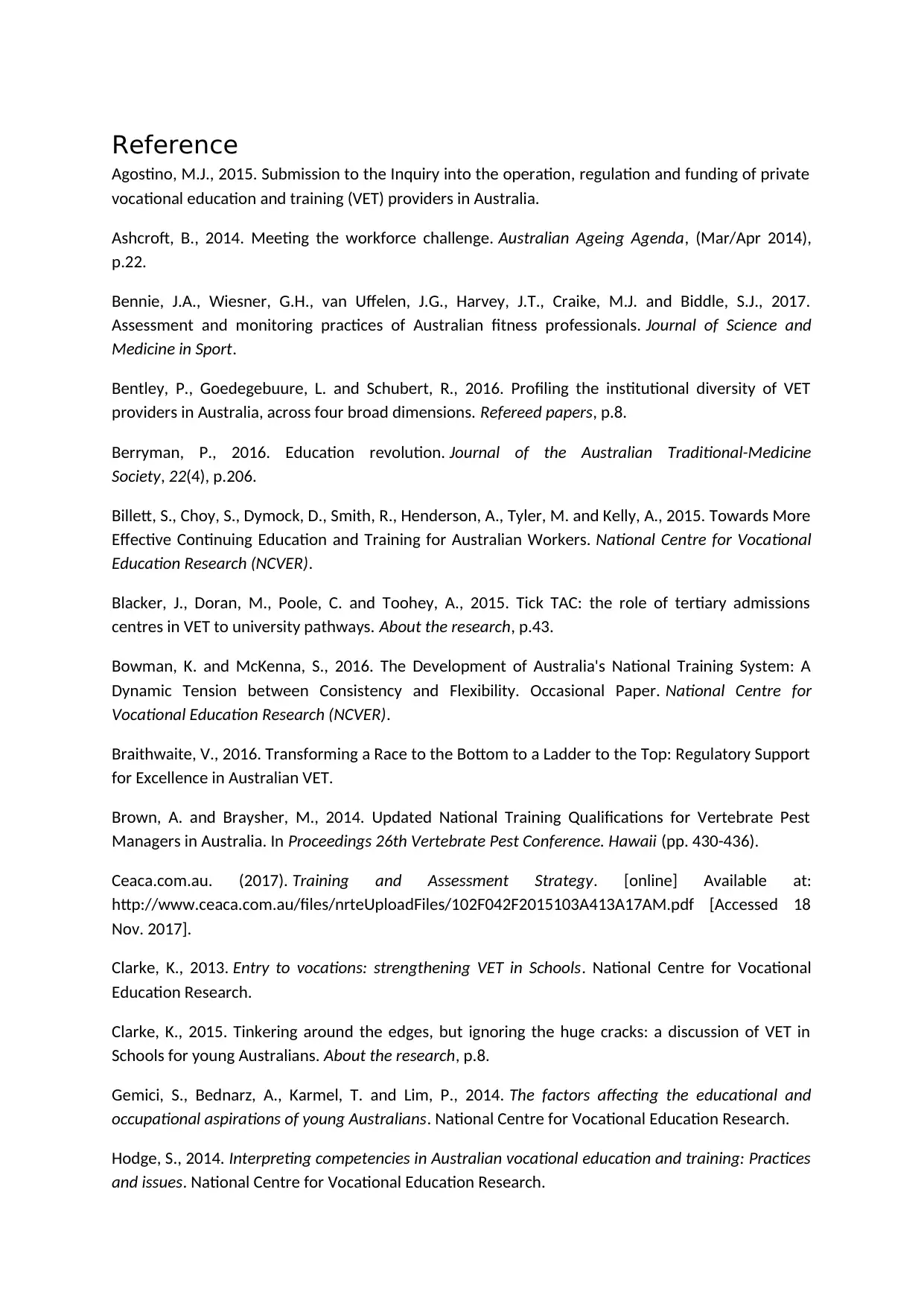
Reference
Agostino, M.J., 2015. Submission to the Inquiry into the operation, regulation and funding of private
vocational education and training (VET) providers in Australia.
Ashcroft, B., 2014. Meeting the workforce challenge. Australian Ageing Agenda, (Mar/Apr 2014),
p.22.
Bennie, J.A., Wiesner, G.H., van Uffelen, J.G., Harvey, J.T., Craike, M.J. and Biddle, S.J., 2017.
Assessment and monitoring practices of Australian fitness professionals. Journal of Science and
Medicine in Sport.
Bentley, P., Goedegebuure, L. and Schubert, R., 2016. Profiling the institutional diversity of VET
providers in Australia, across four broad dimensions. Refereed papers, p.8.
Berryman, P., 2016. Education revolution. Journal of the Australian Traditional-Medicine
Society, 22(4), p.206.
Billett, S., Choy, S., Dymock, D., Smith, R., Henderson, A., Tyler, M. and Kelly, A., 2015. Towards More
Effective Continuing Education and Training for Australian Workers. National Centre for Vocational
Education Research (NCVER).
Blacker, J., Doran, M., Poole, C. and Toohey, A., 2015. Tick TAC: the role of tertiary admissions
centres in VET to university pathways. About the research, p.43.
Bowman, K. and McKenna, S., 2016. The Development of Australia's National Training System: A
Dynamic Tension between Consistency and Flexibility. Occasional Paper. National Centre for
Vocational Education Research (NCVER).
Braithwaite, V., 2016. Transforming a Race to the Bottom to a Ladder to the Top: Regulatory Support
for Excellence in Australian VET.
Brown, A. and Braysher, M., 2014. Updated National Training Qualifications for Vertebrate Pest
Managers in Australia. In Proceedings 26th Vertebrate Pest Conference. Hawaii (pp. 430-436).
Ceaca.com.au. (2017). Training and Assessment Strategy. [online] Available at:
http://www.ceaca.com.au/files/nrteUploadFiles/102F042F2015103A413A17AM.pdf [Accessed 18
Nov. 2017].
Clarke, K., 2013. Entry to vocations: strengthening VET in Schools. National Centre for Vocational
Education Research.
Clarke, K., 2015. Tinkering around the edges, but ignoring the huge cracks: a discussion of VET in
Schools for young Australians. About the research, p.8.
Gemici, S., Bednarz, A., Karmel, T. and Lim, P., 2014. The factors affecting the educational and
occupational aspirations of young Australians. National Centre for Vocational Education Research.
Hodge, S., 2014. Interpreting competencies in Australian vocational education and training: Practices
and issues. National Centre for Vocational Education Research.
Agostino, M.J., 2015. Submission to the Inquiry into the operation, regulation and funding of private
vocational education and training (VET) providers in Australia.
Ashcroft, B., 2014. Meeting the workforce challenge. Australian Ageing Agenda, (Mar/Apr 2014),
p.22.
Bennie, J.A., Wiesner, G.H., van Uffelen, J.G., Harvey, J.T., Craike, M.J. and Biddle, S.J., 2017.
Assessment and monitoring practices of Australian fitness professionals. Journal of Science and
Medicine in Sport.
Bentley, P., Goedegebuure, L. and Schubert, R., 2016. Profiling the institutional diversity of VET
providers in Australia, across four broad dimensions. Refereed papers, p.8.
Berryman, P., 2016. Education revolution. Journal of the Australian Traditional-Medicine
Society, 22(4), p.206.
Billett, S., Choy, S., Dymock, D., Smith, R., Henderson, A., Tyler, M. and Kelly, A., 2015. Towards More
Effective Continuing Education and Training for Australian Workers. National Centre for Vocational
Education Research (NCVER).
Blacker, J., Doran, M., Poole, C. and Toohey, A., 2015. Tick TAC: the role of tertiary admissions
centres in VET to university pathways. About the research, p.43.
Bowman, K. and McKenna, S., 2016. The Development of Australia's National Training System: A
Dynamic Tension between Consistency and Flexibility. Occasional Paper. National Centre for
Vocational Education Research (NCVER).
Braithwaite, V., 2016. Transforming a Race to the Bottom to a Ladder to the Top: Regulatory Support
for Excellence in Australian VET.
Brown, A. and Braysher, M., 2014. Updated National Training Qualifications for Vertebrate Pest
Managers in Australia. In Proceedings 26th Vertebrate Pest Conference. Hawaii (pp. 430-436).
Ceaca.com.au. (2017). Training and Assessment Strategy. [online] Available at:
http://www.ceaca.com.au/files/nrteUploadFiles/102F042F2015103A413A17AM.pdf [Accessed 18
Nov. 2017].
Clarke, K., 2013. Entry to vocations: strengthening VET in Schools. National Centre for Vocational
Education Research.
Clarke, K., 2015. Tinkering around the edges, but ignoring the huge cracks: a discussion of VET in
Schools for young Australians. About the research, p.8.
Gemici, S., Bednarz, A., Karmel, T. and Lim, P., 2014. The factors affecting the educational and
occupational aspirations of young Australians. National Centre for Vocational Education Research.
Hodge, S., 2014. Interpreting competencies in Australian vocational education and training: Practices
and issues. National Centre for Vocational Education Research.
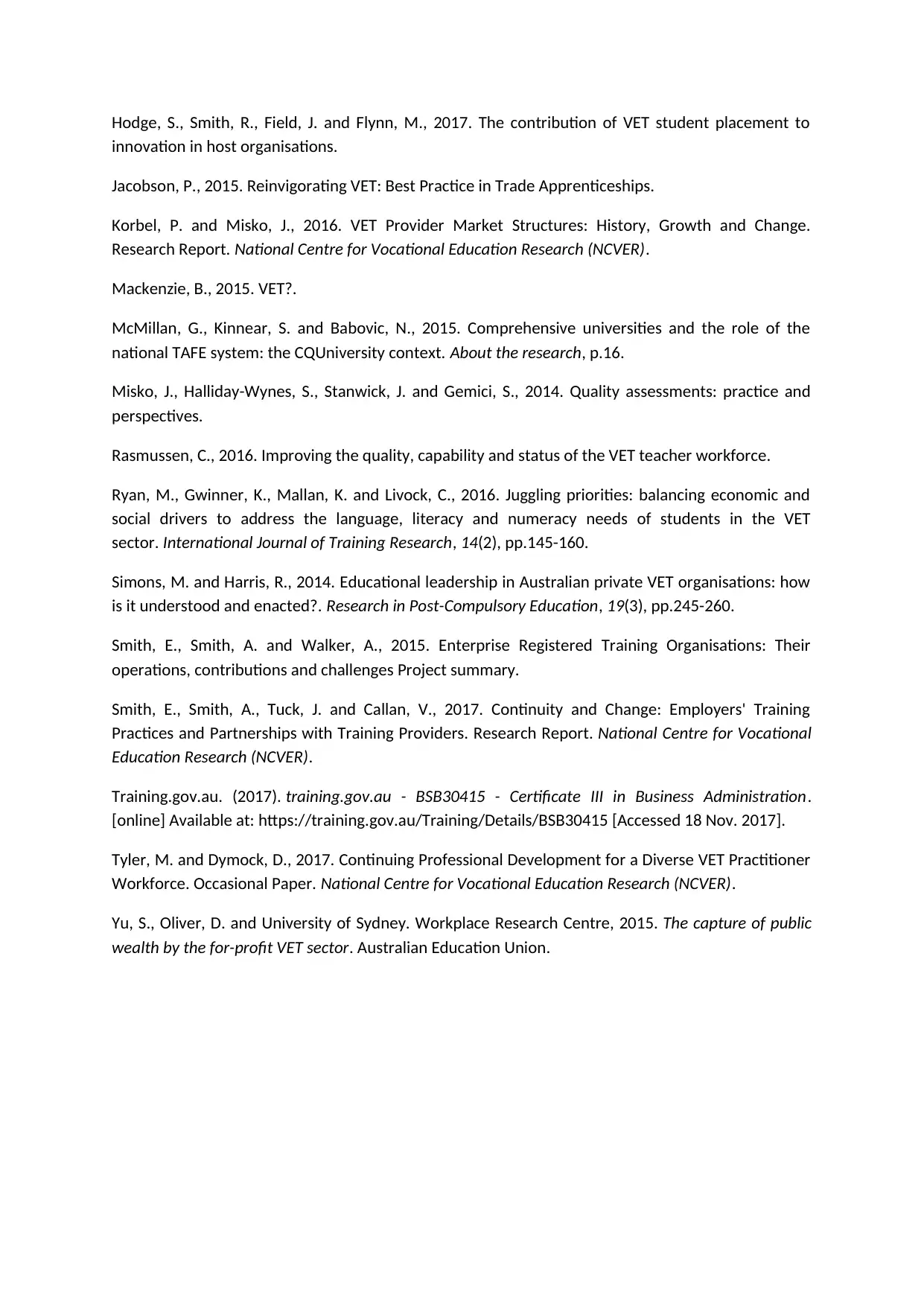
Hodge, S., Smith, R., Field, J. and Flynn, M., 2017. The contribution of VET student placement to
innovation in host organisations.
Jacobson, P., 2015. Reinvigorating VET: Best Practice in Trade Apprenticeships.
Korbel, P. and Misko, J., 2016. VET Provider Market Structures: History, Growth and Change.
Research Report. National Centre for Vocational Education Research (NCVER).
Mackenzie, B., 2015. VET?.
McMillan, G., Kinnear, S. and Babovic, N., 2015. Comprehensive universities and the role of the
national TAFE system: the CQUniversity context. About the research, p.16.
Misko, J., Halliday-Wynes, S., Stanwick, J. and Gemici, S., 2014. Quality assessments: practice and
perspectives.
Rasmussen, C., 2016. Improving the quality, capability and status of the VET teacher workforce.
Ryan, M., Gwinner, K., Mallan, K. and Livock, C., 2016. Juggling priorities: balancing economic and
social drivers to address the language, literacy and numeracy needs of students in the VET
sector. International Journal of Training Research, 14(2), pp.145-160.
Simons, M. and Harris, R., 2014. Educational leadership in Australian private VET organisations: how
is it understood and enacted?. Research in Post-Compulsory Education, 19(3), pp.245-260.
Smith, E., Smith, A. and Walker, A., 2015. Enterprise Registered Training Organisations: Their
operations, contributions and challenges Project summary.
Smith, E., Smith, A., Tuck, J. and Callan, V., 2017. Continuity and Change: Employers' Training
Practices and Partnerships with Training Providers. Research Report. National Centre for Vocational
Education Research (NCVER).
Training.gov.au. (2017). training.gov.au - BSB30415 - Certificate III in Business Administration.
[online] Available at: https://training.gov.au/Training/Details/BSB30415 [Accessed 18 Nov. 2017].
Tyler, M. and Dymock, D., 2017. Continuing Professional Development for a Diverse VET Practitioner
Workforce. Occasional Paper. National Centre for Vocational Education Research (NCVER).
Yu, S., Oliver, D. and University of Sydney. Workplace Research Centre, 2015. The capture of public
wealth by the for-profit VET sector. Australian Education Union.
innovation in host organisations.
Jacobson, P., 2015. Reinvigorating VET: Best Practice in Trade Apprenticeships.
Korbel, P. and Misko, J., 2016. VET Provider Market Structures: History, Growth and Change.
Research Report. National Centre for Vocational Education Research (NCVER).
Mackenzie, B., 2015. VET?.
McMillan, G., Kinnear, S. and Babovic, N., 2015. Comprehensive universities and the role of the
national TAFE system: the CQUniversity context. About the research, p.16.
Misko, J., Halliday-Wynes, S., Stanwick, J. and Gemici, S., 2014. Quality assessments: practice and
perspectives.
Rasmussen, C., 2016. Improving the quality, capability and status of the VET teacher workforce.
Ryan, M., Gwinner, K., Mallan, K. and Livock, C., 2016. Juggling priorities: balancing economic and
social drivers to address the language, literacy and numeracy needs of students in the VET
sector. International Journal of Training Research, 14(2), pp.145-160.
Simons, M. and Harris, R., 2014. Educational leadership in Australian private VET organisations: how
is it understood and enacted?. Research in Post-Compulsory Education, 19(3), pp.245-260.
Smith, E., Smith, A. and Walker, A., 2015. Enterprise Registered Training Organisations: Their
operations, contributions and challenges Project summary.
Smith, E., Smith, A., Tuck, J. and Callan, V., 2017. Continuity and Change: Employers' Training
Practices and Partnerships with Training Providers. Research Report. National Centre for Vocational
Education Research (NCVER).
Training.gov.au. (2017). training.gov.au - BSB30415 - Certificate III in Business Administration.
[online] Available at: https://training.gov.au/Training/Details/BSB30415 [Accessed 18 Nov. 2017].
Tyler, M. and Dymock, D., 2017. Continuing Professional Development for a Diverse VET Practitioner
Workforce. Occasional Paper. National Centre for Vocational Education Research (NCVER).
Yu, S., Oliver, D. and University of Sydney. Workplace Research Centre, 2015. The capture of public
wealth by the for-profit VET sector. Australian Education Union.
Secure Best Marks with AI Grader
Need help grading? Try our AI Grader for instant feedback on your assignments.
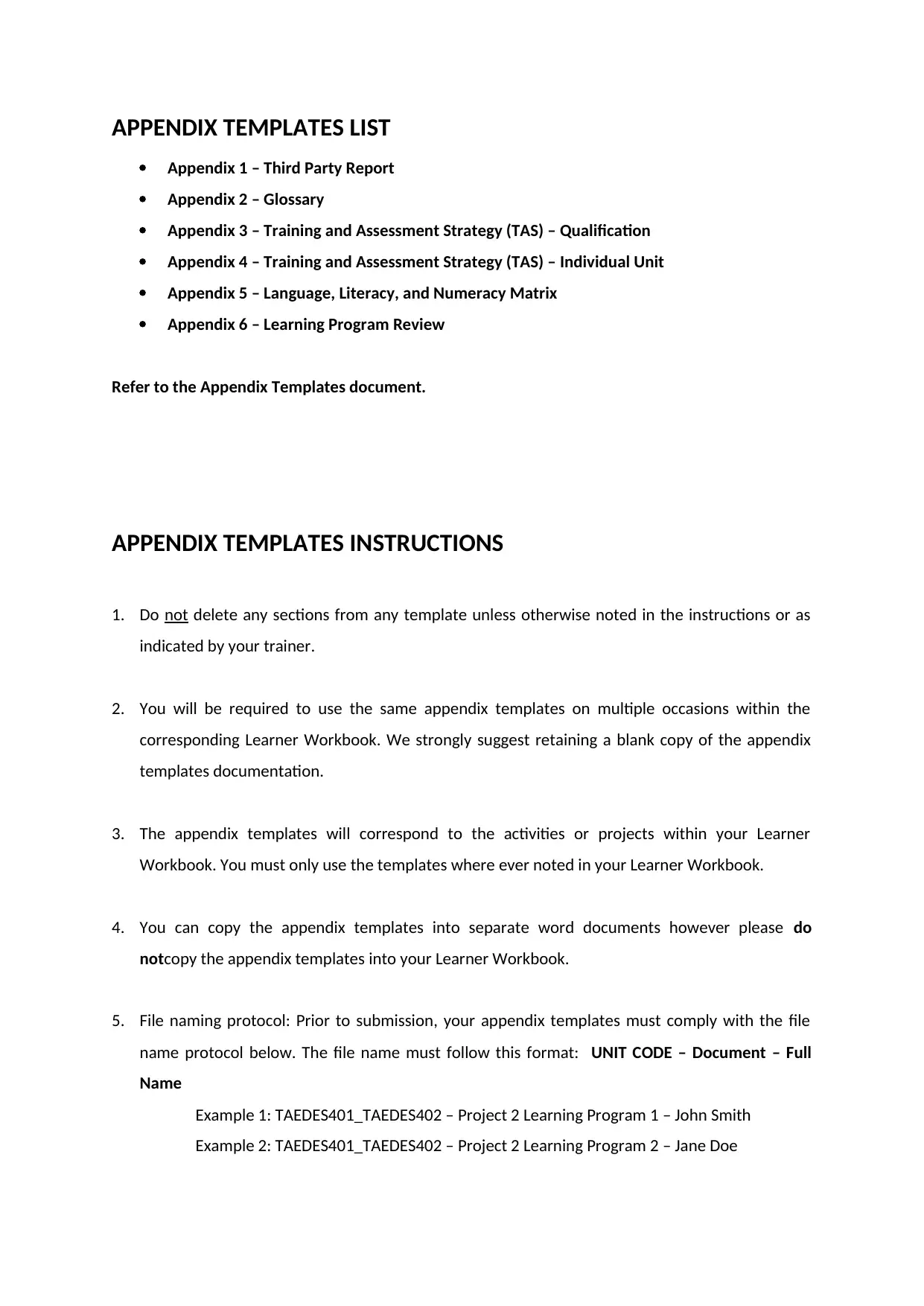
APPENDIX TEMPLATES LIST
Appendix 1 – Third Party Report
Appendix 2 – Glossary
Appendix 3 – Training and Assessment Strategy (TAS) – Qualification
Appendix 4 – Training and Assessment Strategy (TAS) – Individual Unit
Appendix 5 – Language, Literacy, and Numeracy Matrix
Appendix 6 – Learning Program Review
Refer to the Appendix Templates document.
APPENDIX TEMPLATES INSTRUCTIONS
1. Do not delete any sections from any template unless otherwise noted in the instructions or as
indicated by your trainer.
2. You will be required to use the same appendix templates on multiple occasions within the
corresponding Learner Workbook. We strongly suggest retaining a blank copy of the appendix
templates documentation.
3. The appendix templates will correspond to the activities or projects within your Learner
Workbook. You must only use the templates where ever noted in your Learner Workbook.
4. You can copy the appendix templates into separate word documents however please do
notcopy the appendix templates into your Learner Workbook.
5. File naming protocol: Prior to submission, your appendix templates must comply with the file
name protocol below. The file name must follow this format: UNIT CODE – Document – Full
Name
Example 1: TAEDES401_TAEDES402 – Project 2 Learning Program 1 – John Smith
Example 2: TAEDES401_TAEDES402 – Project 2 Learning Program 2 – Jane Doe
Appendix 1 – Third Party Report
Appendix 2 – Glossary
Appendix 3 – Training and Assessment Strategy (TAS) – Qualification
Appendix 4 – Training and Assessment Strategy (TAS) – Individual Unit
Appendix 5 – Language, Literacy, and Numeracy Matrix
Appendix 6 – Learning Program Review
Refer to the Appendix Templates document.
APPENDIX TEMPLATES INSTRUCTIONS
1. Do not delete any sections from any template unless otherwise noted in the instructions or as
indicated by your trainer.
2. You will be required to use the same appendix templates on multiple occasions within the
corresponding Learner Workbook. We strongly suggest retaining a blank copy of the appendix
templates documentation.
3. The appendix templates will correspond to the activities or projects within your Learner
Workbook. You must only use the templates where ever noted in your Learner Workbook.
4. You can copy the appendix templates into separate word documents however please do
notcopy the appendix templates into your Learner Workbook.
5. File naming protocol: Prior to submission, your appendix templates must comply with the file
name protocol below. The file name must follow this format: UNIT CODE – Document – Full
Name
Example 1: TAEDES401_TAEDES402 – Project 2 Learning Program 1 – John Smith
Example 2: TAEDES401_TAEDES402 – Project 2 Learning Program 2 – Jane Doe

6. All of the above items must be adhered to. Failure to do so will result in your work being
returned to you, delaying the marking of your assessment.
returned to you, delaying the marking of your assessment.
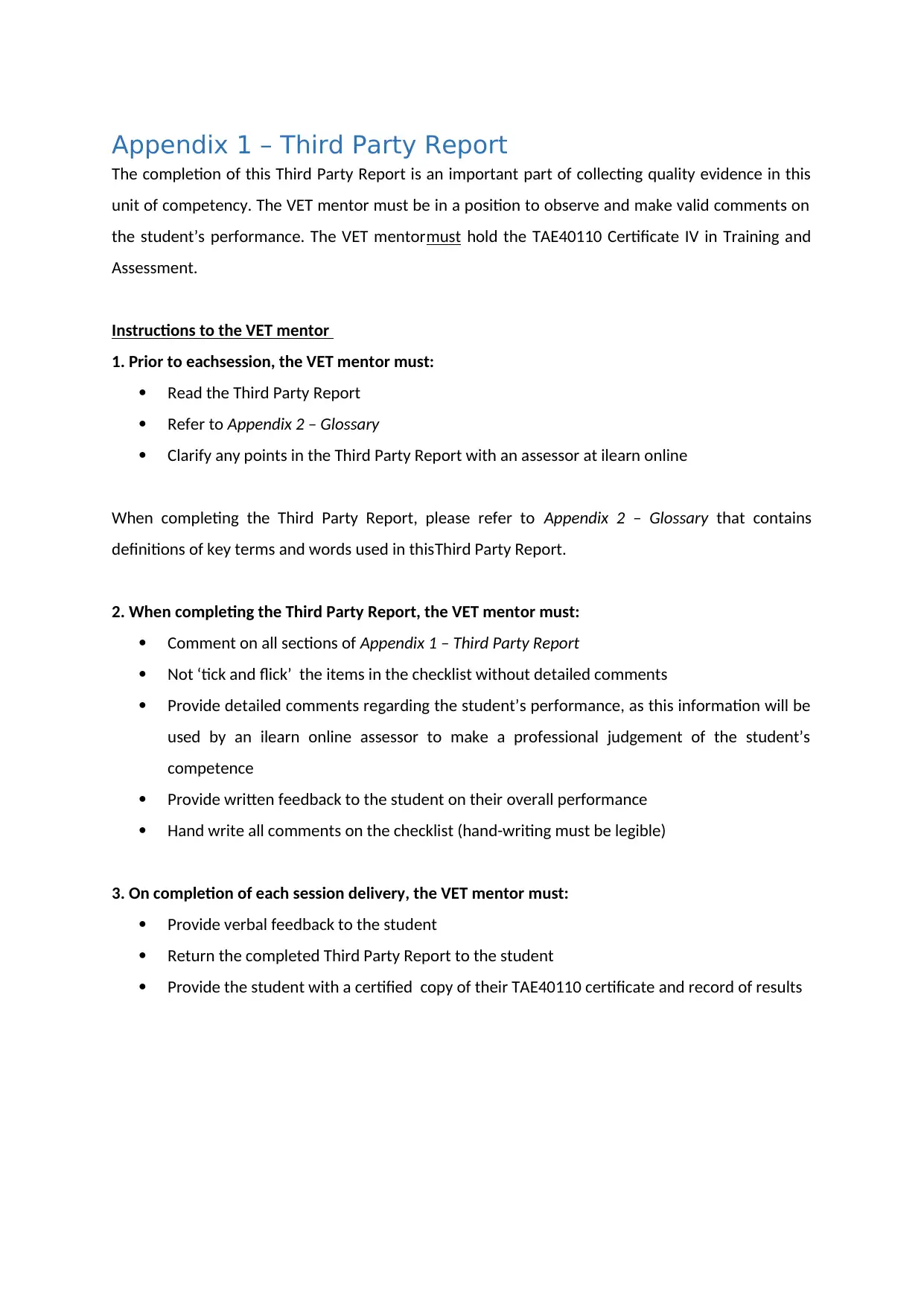
Appendix 1 – Third Party Report
The completion of this Third Party Report is an important part of collecting quality evidence in this
unit of competency. The VET mentor must be in a position to observe and make valid comments on
the student’s performance. The VET mentormust hold the TAE40110 Certificate IV in Training and
Assessment.
Instructions to the VET mentor
1. Prior to eachsession, the VET mentor must:
Read the Third Party Report
Refer to Appendix 2 – Glossary
Clarify any points in the Third Party Report with an assessor at ilearn online
When completing the Third Party Report, please refer to Appendix 2 – Glossary that contains
definitions of key terms and words used in thisThird Party Report.
2. When completing the Third Party Report, the VET mentor must:
Comment on all sections of Appendix 1 – Third Party Report
Not ‘tick and flick’ the items in the checklist without detailed comments
Provide detailed comments regarding the student’s performance, as this information will be
used by an ilearn online assessor to make a professional judgement of the student’s
competence
Provide written feedback to the student on their overall performance
Hand write all comments on the checklist (hand-writing must be legible)
3. On completion of each session delivery, the VET mentor must:
Provide verbal feedback to the student
Return the completed Third Party Report to the student
Provide the student with a certified copy of their TAE40110 certificate and record of results
The completion of this Third Party Report is an important part of collecting quality evidence in this
unit of competency. The VET mentor must be in a position to observe and make valid comments on
the student’s performance. The VET mentormust hold the TAE40110 Certificate IV in Training and
Assessment.
Instructions to the VET mentor
1. Prior to eachsession, the VET mentor must:
Read the Third Party Report
Refer to Appendix 2 – Glossary
Clarify any points in the Third Party Report with an assessor at ilearn online
When completing the Third Party Report, please refer to Appendix 2 – Glossary that contains
definitions of key terms and words used in thisThird Party Report.
2. When completing the Third Party Report, the VET mentor must:
Comment on all sections of Appendix 1 – Third Party Report
Not ‘tick and flick’ the items in the checklist without detailed comments
Provide detailed comments regarding the student’s performance, as this information will be
used by an ilearn online assessor to make a professional judgement of the student’s
competence
Provide written feedback to the student on their overall performance
Hand write all comments on the checklist (hand-writing must be legible)
3. On completion of each session delivery, the VET mentor must:
Provide verbal feedback to the student
Return the completed Third Party Report to the student
Provide the student with a certified copy of their TAE40110 certificate and record of results
Paraphrase This Document
Need a fresh take? Get an instant paraphrase of this document with our AI Paraphraser
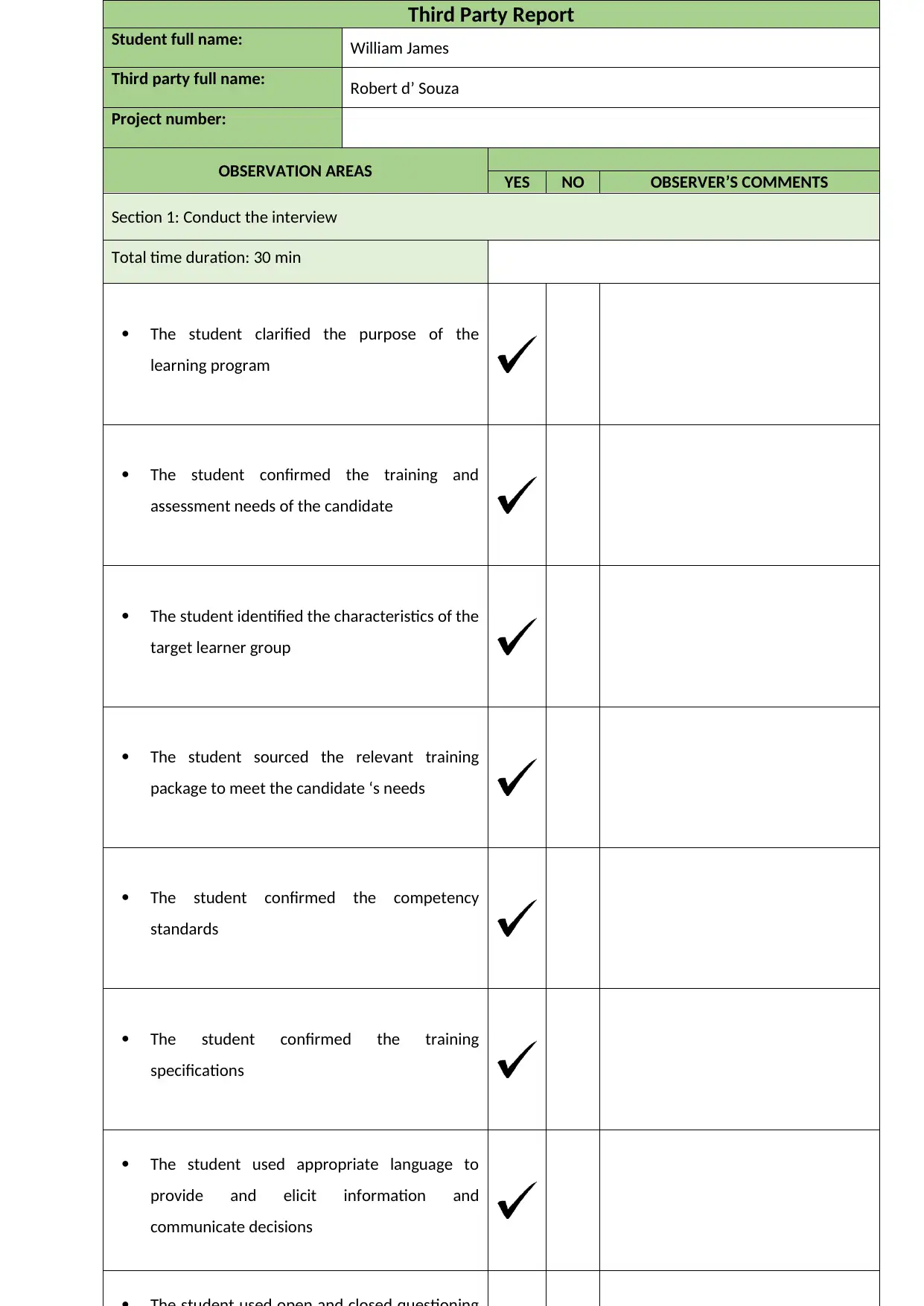
Third Party Report
Student full name: William James
Third party full name: Robert d’ Souza
Project number:
OBSERVATION AREAS YES NO OBSERVER’S COMMENTS
Section 1: Conduct the interview
Total time duration: 30 min
The student clarified the purpose of the
learning program
The student confirmed the training and
assessment needs of the candidate
The student identified the characteristics of the
target learner group
The student sourced the relevant training
package to meet the candidate ‘s needs
The student confirmed the competency
standards
The student confirmed the training
specifications
The student used appropriate language to
provide and elicit information and
communicate decisions
Student full name: William James
Third party full name: Robert d’ Souza
Project number:
OBSERVATION AREAS YES NO OBSERVER’S COMMENTS
Section 1: Conduct the interview
Total time duration: 30 min
The student clarified the purpose of the
learning program
The student confirmed the training and
assessment needs of the candidate
The student identified the characteristics of the
target learner group
The student sourced the relevant training
package to meet the candidate ‘s needs
The student confirmed the competency
standards
The student confirmed the training
specifications
The student used appropriate language to
provide and elicit information and
communicate decisions
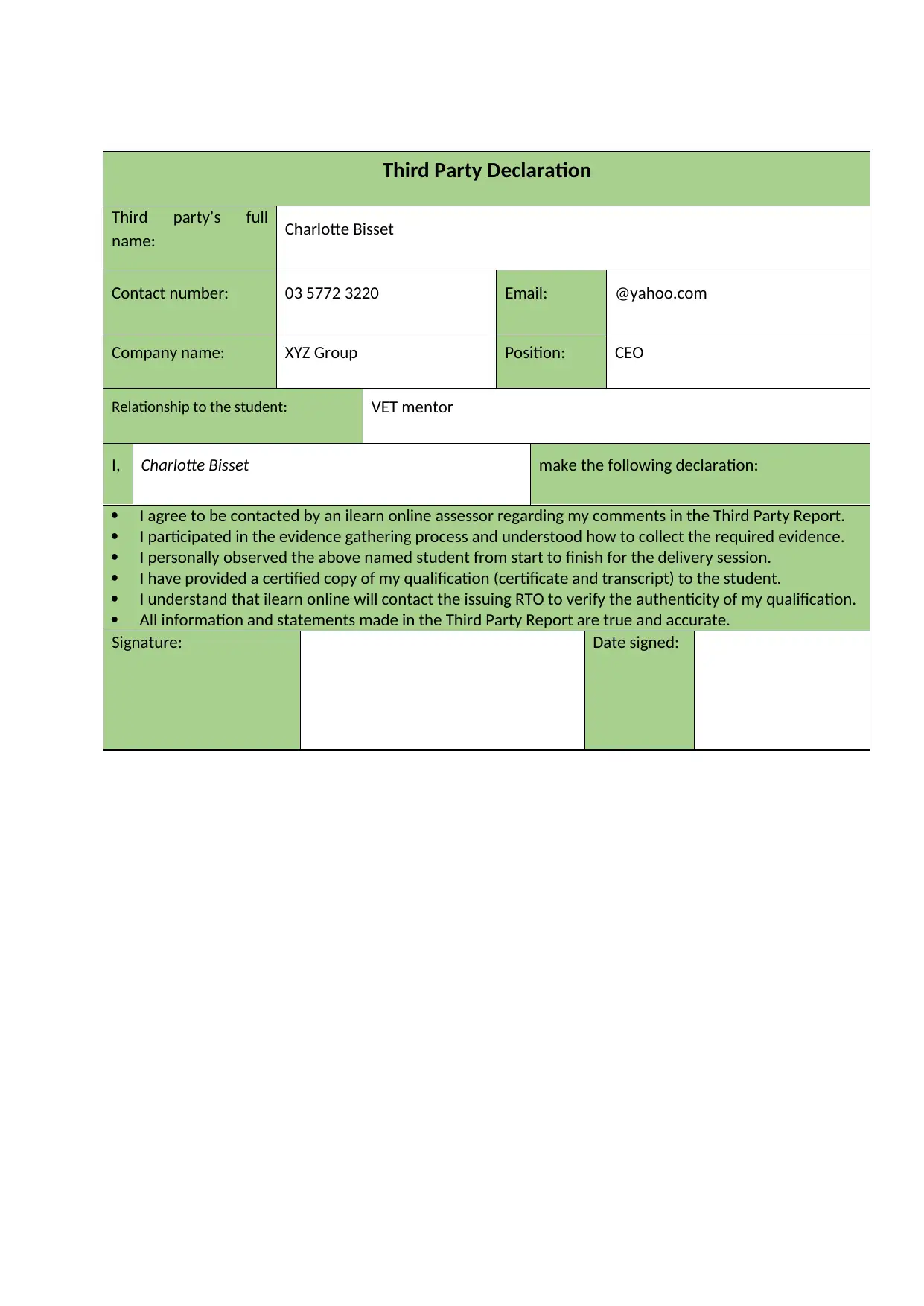
Third Party Declaration
Third party’s full
name: Charlotte Bisset
Contact number: 03 5772 3220 Email: @yahoo.com
Company name: XYZ Group Position: CEO
Relationship to the student: VET mentor
I, Charlotte Bisset make the following declaration:
I agree to be contacted by an ilearn online assessor regarding my comments in the Third Party Report.
I participated in the evidence gathering process and understood how to collect the required evidence.
I personally observed the above named student from start to finish for the delivery session.
I have provided a certified copy of my qualification (certificate and transcript) to the student.
I understand that ilearn online will contact the issuing RTO to verify the authenticity of my qualification.
All information and statements made in the Third Party Report are true and accurate.
Signature: Date signed:
Third party’s full
name: Charlotte Bisset
Contact number: 03 5772 3220 Email: @yahoo.com
Company name: XYZ Group Position: CEO
Relationship to the student: VET mentor
I, Charlotte Bisset make the following declaration:
I agree to be contacted by an ilearn online assessor regarding my comments in the Third Party Report.
I participated in the evidence gathering process and understood how to collect the required evidence.
I personally observed the above named student from start to finish for the delivery session.
I have provided a certified copy of my qualification (certificate and transcript) to the student.
I understand that ilearn online will contact the issuing RTO to verify the authenticity of my qualification.
All information and statements made in the Third Party Report are true and accurate.
Signature: Date signed:
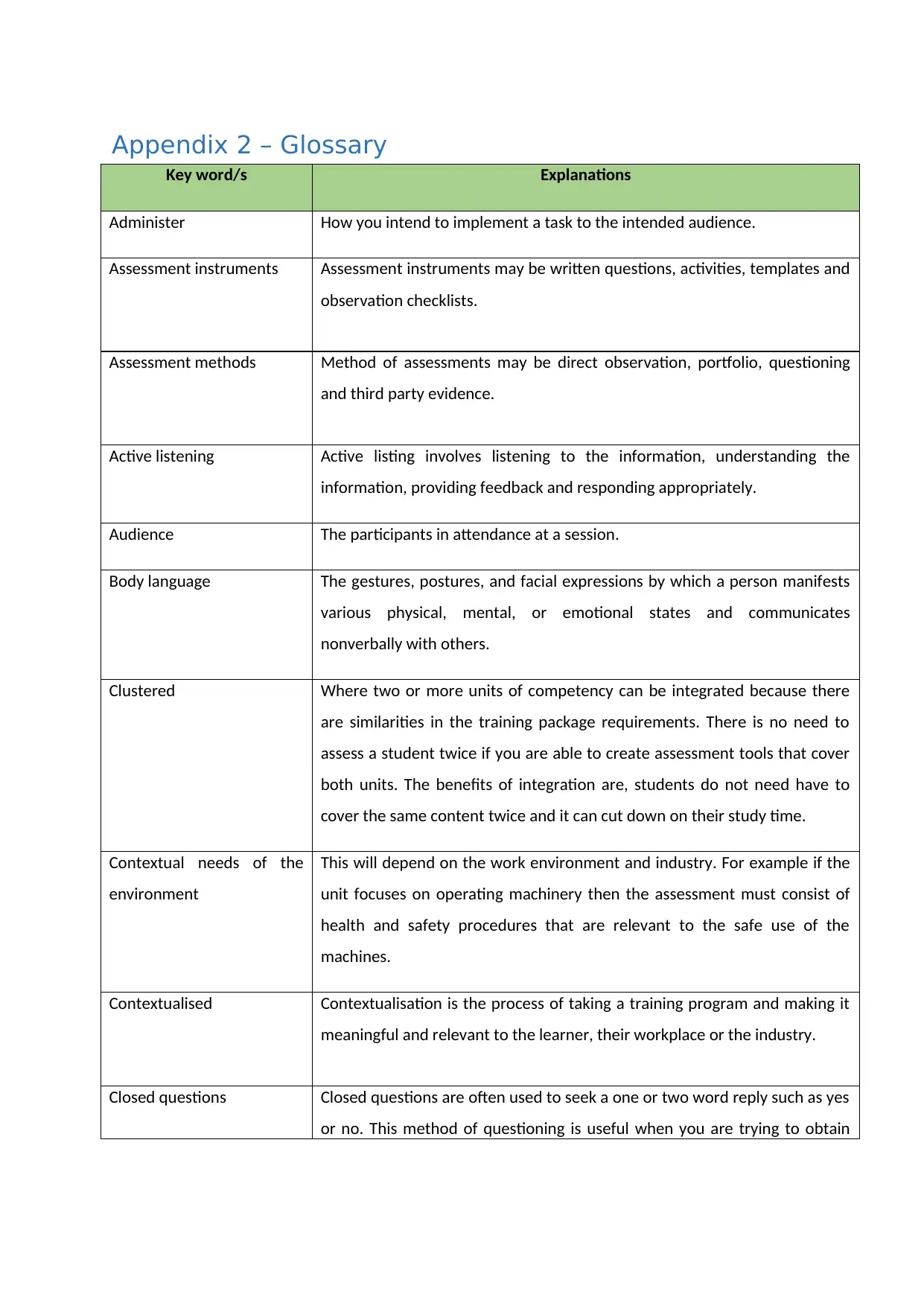
Appendix 2 – Glossary
Key word/s Explanations
Administer How you intend to implement a task to the intended audience.
Assessment instruments Assessment instruments may be written questions, activities, templates and
observation checklists.
Assessment methods Method of assessments may be direct observation, portfolio, questioning
and third party evidence.
Active listening Active listing involves listening to the information, understanding the
information, providing feedback and responding appropriately.
Audience The participants in attendance at a session.
Body language The gestures, postures, and facial expressions by which a person manifests
various physical, mental, or emotional states and communicates
nonverbally with others.
Clustered Where two or more units of competency can be integrated because there
are similarities in the training package requirements. There is no need to
assess a student twice if you are able to create assessment tools that cover
both units. The benefits of integration are, students do not need have to
cover the same content twice and it can cut down on their study time.
Contextual needs of the
environment
This will depend on the work environment and industry. For example if the
unit focuses on operating machinery then the assessment must consist of
health and safety procedures that are relevant to the safe use of the
machines.
Contextualised Contextualisation is the process of taking a training program and making it
meaningful and relevant to the learner, their workplace or the industry.
Closed questions Closed questions are often used to seek a one or two word reply such as yes
or no. This method of questioning is useful when you are trying to obtain
Key word/s Explanations
Administer How you intend to implement a task to the intended audience.
Assessment instruments Assessment instruments may be written questions, activities, templates and
observation checklists.
Assessment methods Method of assessments may be direct observation, portfolio, questioning
and third party evidence.
Active listening Active listing involves listening to the information, understanding the
information, providing feedback and responding appropriately.
Audience The participants in attendance at a session.
Body language The gestures, postures, and facial expressions by which a person manifests
various physical, mental, or emotional states and communicates
nonverbally with others.
Clustered Where two or more units of competency can be integrated because there
are similarities in the training package requirements. There is no need to
assess a student twice if you are able to create assessment tools that cover
both units. The benefits of integration are, students do not need have to
cover the same content twice and it can cut down on their study time.
Contextual needs of the
environment
This will depend on the work environment and industry. For example if the
unit focuses on operating machinery then the assessment must consist of
health and safety procedures that are relevant to the safe use of the
machines.
Contextualised Contextualisation is the process of taking a training program and making it
meaningful and relevant to the learner, their workplace or the industry.
Closed questions Closed questions are often used to seek a one or two word reply such as yes
or no. This method of questioning is useful when you are trying to obtain
Secure Best Marks with AI Grader
Need help grading? Try our AI Grader for instant feedback on your assignments.
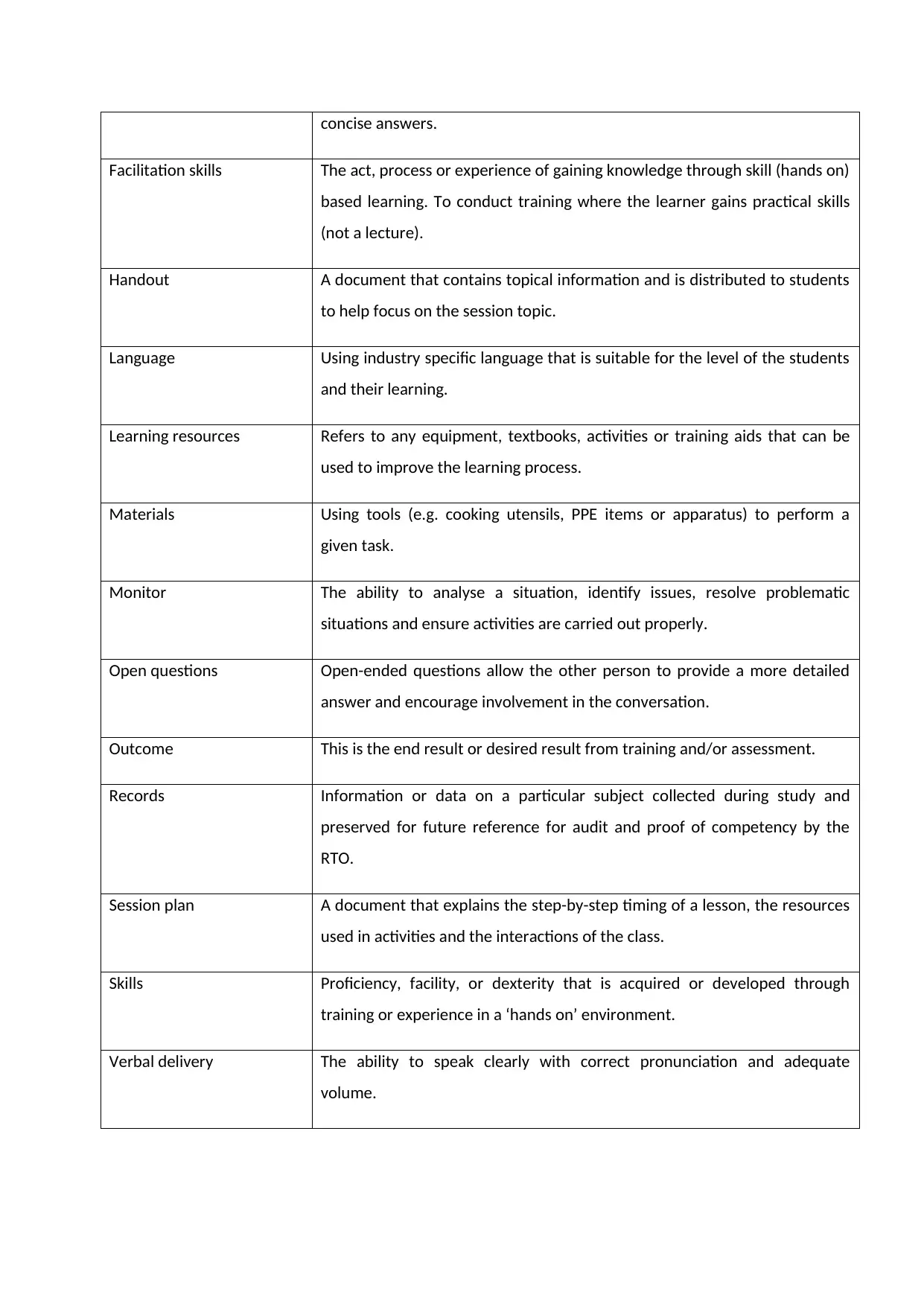
concise answers.
Facilitation skills The act, process or experience of gaining knowledge through skill (hands on)
based learning. To conduct training where the learner gains practical skills
(not a lecture).
Handout A document that contains topical information and is distributed to students
to help focus on the session topic.
Language Using industry specific language that is suitable for the level of the students
and their learning.
Learning resources Refers to any equipment, textbooks, activities or training aids that can be
used to improve the learning process.
Materials Using tools (e.g. cooking utensils, PPE items or apparatus) to perform a
given task.
Monitor The ability to analyse a situation, identify issues, resolve problematic
situations and ensure activities are carried out properly.
Open questions Open-ended questions allow the other person to provide a more detailed
answer and encourage involvement in the conversation.
Outcome This is the end result or desired result from training and/or assessment.
Records Information or data on a particular subject collected during study and
preserved for future reference for audit and proof of competency by the
RTO.
Session plan A document that explains the step-by-step timing of a lesson, the resources
used in activities and the interactions of the class.
Skills Proficiency, facility, or dexterity that is acquired or developed through
training or experience in a ‘hands on’ environment.
Verbal delivery The ability to speak clearly with correct pronunciation and adequate
volume.
Facilitation skills The act, process or experience of gaining knowledge through skill (hands on)
based learning. To conduct training where the learner gains practical skills
(not a lecture).
Handout A document that contains topical information and is distributed to students
to help focus on the session topic.
Language Using industry specific language that is suitable for the level of the students
and their learning.
Learning resources Refers to any equipment, textbooks, activities or training aids that can be
used to improve the learning process.
Materials Using tools (e.g. cooking utensils, PPE items or apparatus) to perform a
given task.
Monitor The ability to analyse a situation, identify issues, resolve problematic
situations and ensure activities are carried out properly.
Open questions Open-ended questions allow the other person to provide a more detailed
answer and encourage involvement in the conversation.
Outcome This is the end result or desired result from training and/or assessment.
Records Information or data on a particular subject collected during study and
preserved for future reference for audit and proof of competency by the
RTO.
Session plan A document that explains the step-by-step timing of a lesson, the resources
used in activities and the interactions of the class.
Skills Proficiency, facility, or dexterity that is acquired or developed through
training or experience in a ‘hands on’ environment.
Verbal delivery The ability to speak clearly with correct pronunciation and adequate
volume.
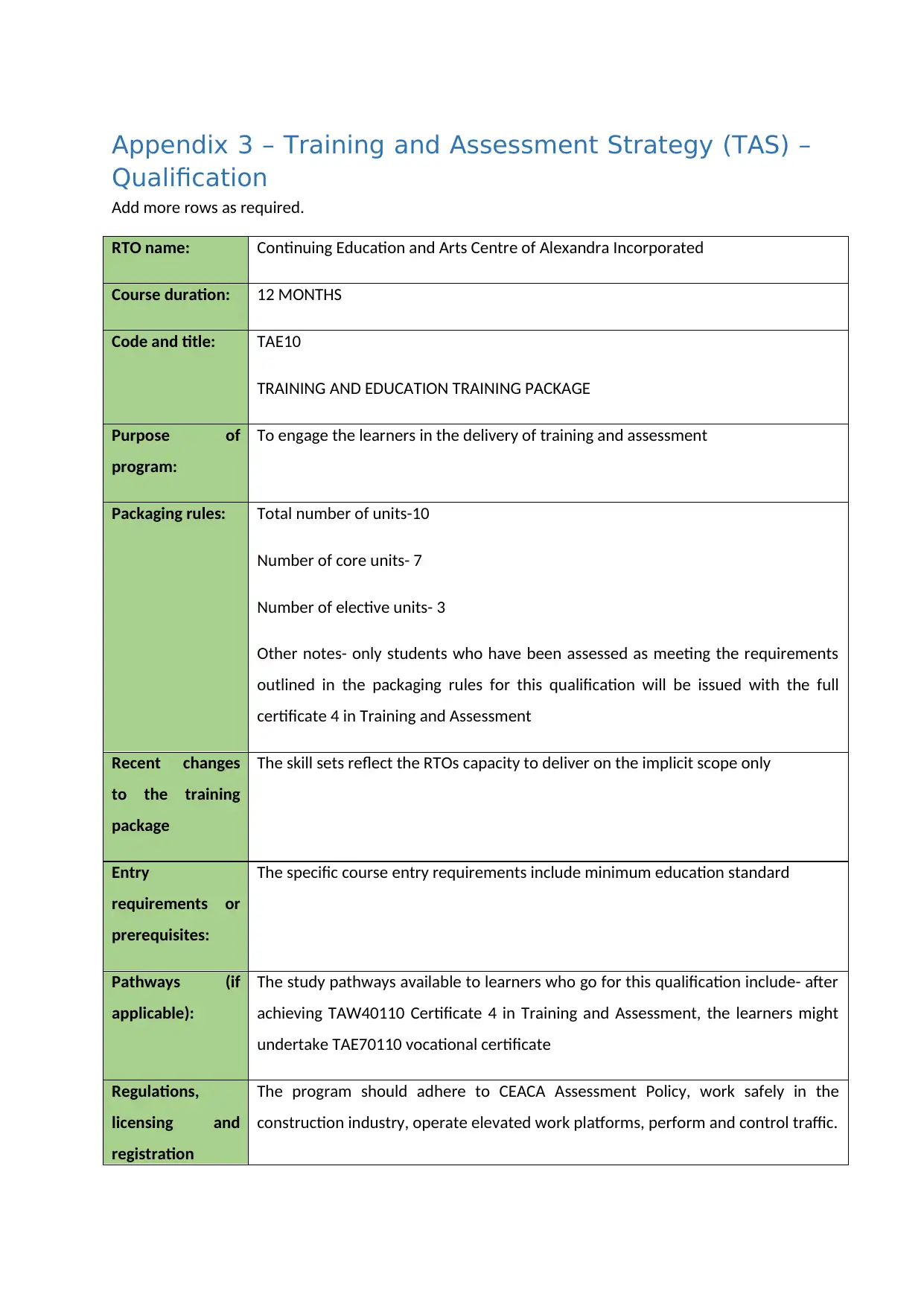
Appendix 3 – Training and Assessment Strategy (TAS) –
Qualification
Add more rows as required.
RTO name: Continuing Education and Arts Centre of Alexandra Incorporated
Course duration: 12 MONTHS
Code and title: TAE10
TRAINING AND EDUCATION TRAINING PACKAGE
Purpose of
program:
To engage the learners in the delivery of training and assessment
Packaging rules: Total number of units-10
Number of core units- 7
Number of elective units- 3
Other notes- only students who have been assessed as meeting the requirements
outlined in the packaging rules for this qualification will be issued with the full
certificate 4 in Training and Assessment
Recent changes
to the training
package
The skill sets reflect the RTOs capacity to deliver on the implicit scope only
Entry
requirements or
prerequisites:
The specific course entry requirements include minimum education standard
Pathways (if
applicable):
The study pathways available to learners who go for this qualification include- after
achieving TAW40110 Certificate 4 in Training and Assessment, the learners might
undertake TAE70110 vocational certificate
Regulations,
licensing and
registration
The program should adhere to CEACA Assessment Policy, work safely in the
construction industry, operate elevated work platforms, perform and control traffic.
Qualification
Add more rows as required.
RTO name: Continuing Education and Arts Centre of Alexandra Incorporated
Course duration: 12 MONTHS
Code and title: TAE10
TRAINING AND EDUCATION TRAINING PACKAGE
Purpose of
program:
To engage the learners in the delivery of training and assessment
Packaging rules: Total number of units-10
Number of core units- 7
Number of elective units- 3
Other notes- only students who have been assessed as meeting the requirements
outlined in the packaging rules for this qualification will be issued with the full
certificate 4 in Training and Assessment
Recent changes
to the training
package
The skill sets reflect the RTOs capacity to deliver on the implicit scope only
Entry
requirements or
prerequisites:
The specific course entry requirements include minimum education standard
Pathways (if
applicable):
The study pathways available to learners who go for this qualification include- after
achieving TAW40110 Certificate 4 in Training and Assessment, the learners might
undertake TAE70110 vocational certificate
Regulations,
licensing and
registration
The program should adhere to CEACA Assessment Policy, work safely in the
construction industry, operate elevated work platforms, perform and control traffic.
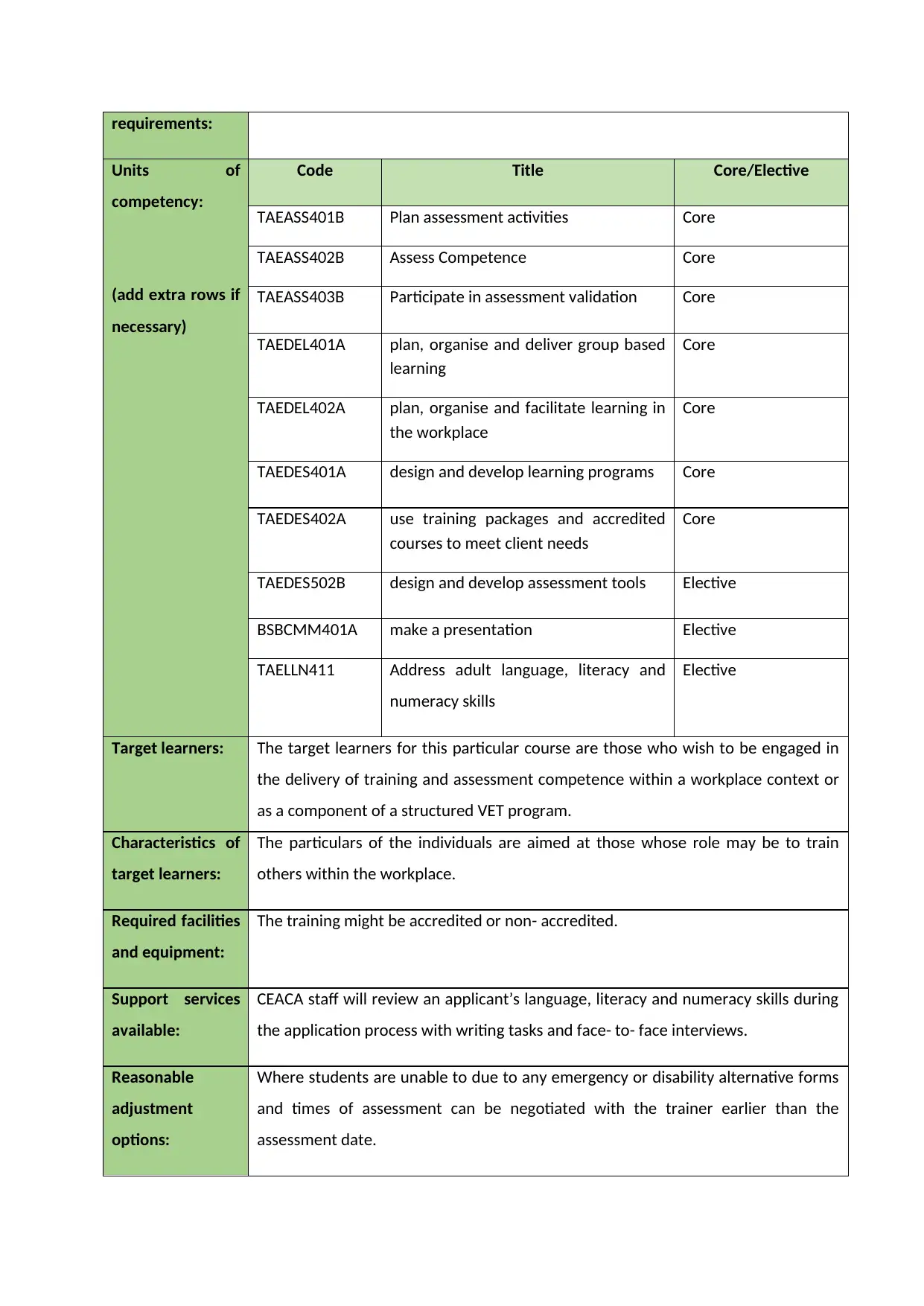
requirements:
Units of
competency:
(add extra rows if
necessary)
Code Title Core/Elective
TAEASS401B Plan assessment activities Core
TAEASS402B Assess Competence Core
TAEASS403B Participate in assessment validation Core
TAEDEL401A plan, organise and deliver group based
learning
Core
TAEDEL402A plan, organise and facilitate learning in
the workplace
Core
TAEDES401A design and develop learning programs Core
TAEDES402A use training packages and accredited
courses to meet client needs
Core
TAEDES502B design and develop assessment tools Elective
BSBCMM401A make a presentation Elective
TAELLN411 Address adult language, literacy and
numeracy skills
Elective
Target learners: The target learners for this particular course are those who wish to be engaged in
the delivery of training and assessment competence within a workplace context or
as a component of a structured VET program.
Characteristics of
target learners:
The particulars of the individuals are aimed at those whose role may be to train
others within the workplace.
Required facilities
and equipment:
The training might be accredited or non- accredited.
Support services
available:
CEACA staff will review an applicant’s language, literacy and numeracy skills during
the application process with writing tasks and face- to- face interviews.
Reasonable
adjustment
options:
Where students are unable to due to any emergency or disability alternative forms
and times of assessment can be negotiated with the trainer earlier than the
assessment date.
Units of
competency:
(add extra rows if
necessary)
Code Title Core/Elective
TAEASS401B Plan assessment activities Core
TAEASS402B Assess Competence Core
TAEASS403B Participate in assessment validation Core
TAEDEL401A plan, organise and deliver group based
learning
Core
TAEDEL402A plan, organise and facilitate learning in
the workplace
Core
TAEDES401A design and develop learning programs Core
TAEDES402A use training packages and accredited
courses to meet client needs
Core
TAEDES502B design and develop assessment tools Elective
BSBCMM401A make a presentation Elective
TAELLN411 Address adult language, literacy and
numeracy skills
Elective
Target learners: The target learners for this particular course are those who wish to be engaged in
the delivery of training and assessment competence within a workplace context or
as a component of a structured VET program.
Characteristics of
target learners:
The particulars of the individuals are aimed at those whose role may be to train
others within the workplace.
Required facilities
and equipment:
The training might be accredited or non- accredited.
Support services
available:
CEACA staff will review an applicant’s language, literacy and numeracy skills during
the application process with writing tasks and face- to- face interviews.
Reasonable
adjustment
options:
Where students are unable to due to any emergency or disability alternative forms
and times of assessment can be negotiated with the trainer earlier than the
assessment date.
Paraphrase This Document
Need a fresh take? Get an instant paraphrase of this document with our AI Paraphraser
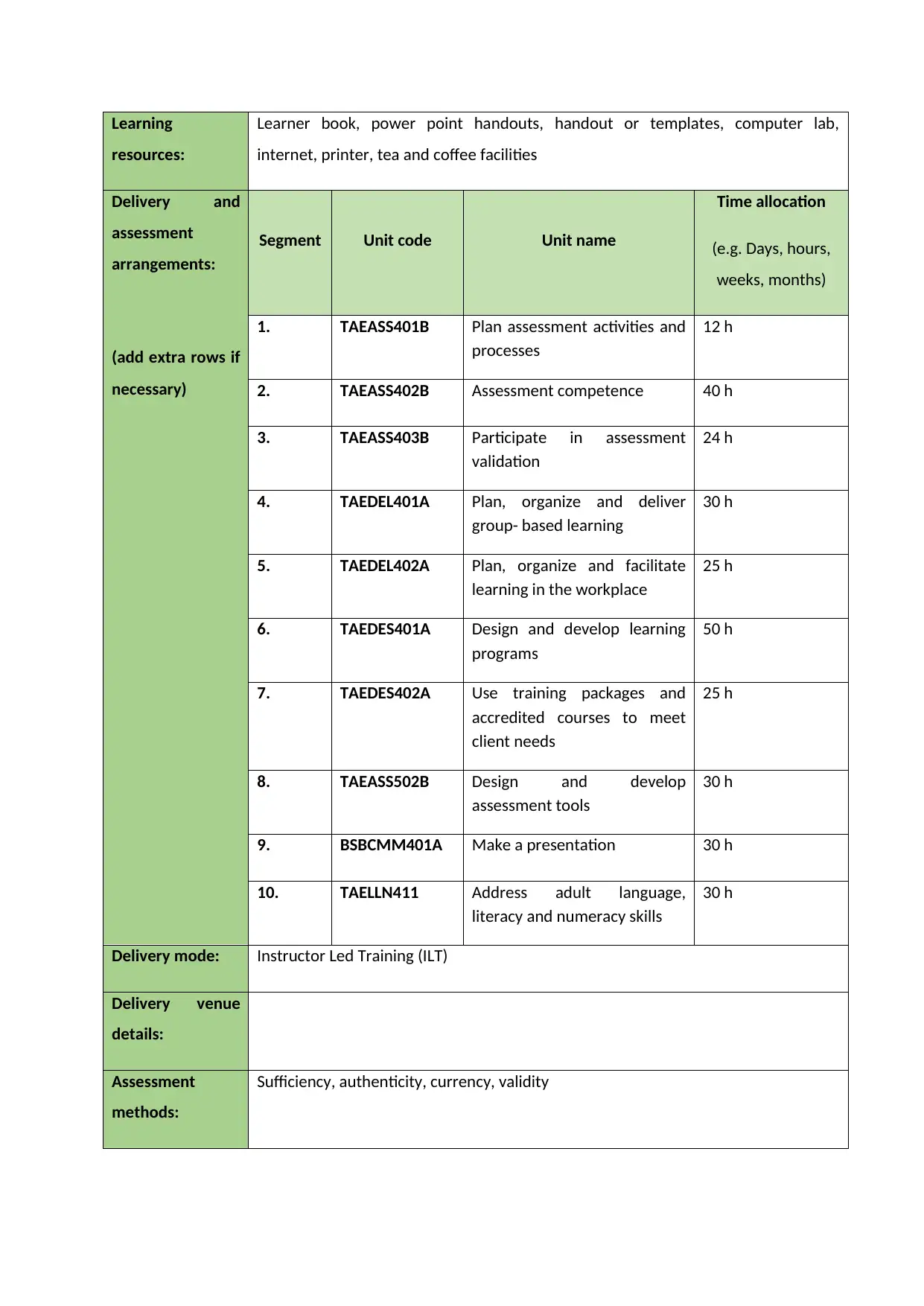
Learning
resources:
Learner book, power point handouts, handout or templates, computer lab,
internet, printer, tea and coffee facilities
Delivery and
assessment
arrangements:
(add extra rows if
necessary)
Segment Unit code Unit name
Time allocation
(e.g. Days, hours,
weeks, months)
1. TAEASS401B Plan assessment activities and
processes
12 h
2. TAEASS402B Assessment competence 40 h
3. TAEASS403B Participate in assessment
validation
24 h
4. TAEDEL401A Plan, organize and deliver
group- based learning
30 h
5. TAEDEL402A Plan, organize and facilitate
learning in the workplace
25 h
6. TAEDES401A Design and develop learning
programs
50 h
7. TAEDES402A Use training packages and
accredited courses to meet
client needs
25 h
8. TAEASS502B Design and develop
assessment tools
30 h
9. BSBCMM401A Make a presentation 30 h
10. TAELLN411 Address adult language,
literacy and numeracy skills
30 h
Delivery mode: Instructor Led Training (ILT)
Delivery venue
details:
Assessment
methods:
Sufficiency, authenticity, currency, validity
resources:
Learner book, power point handouts, handout or templates, computer lab,
internet, printer, tea and coffee facilities
Delivery and
assessment
arrangements:
(add extra rows if
necessary)
Segment Unit code Unit name
Time allocation
(e.g. Days, hours,
weeks, months)
1. TAEASS401B Plan assessment activities and
processes
12 h
2. TAEASS402B Assessment competence 40 h
3. TAEASS403B Participate in assessment
validation
24 h
4. TAEDEL401A Plan, organize and deliver
group- based learning
30 h
5. TAEDEL402A Plan, organize and facilitate
learning in the workplace
25 h
6. TAEDES401A Design and develop learning
programs
50 h
7. TAEDES402A Use training packages and
accredited courses to meet
client needs
25 h
8. TAEASS502B Design and develop
assessment tools
30 h
9. BSBCMM401A Make a presentation 30 h
10. TAELLN411 Address adult language,
literacy and numeracy skills
30 h
Delivery mode: Instructor Led Training (ILT)
Delivery venue
details:
Assessment
methods:
Sufficiency, authenticity, currency, validity
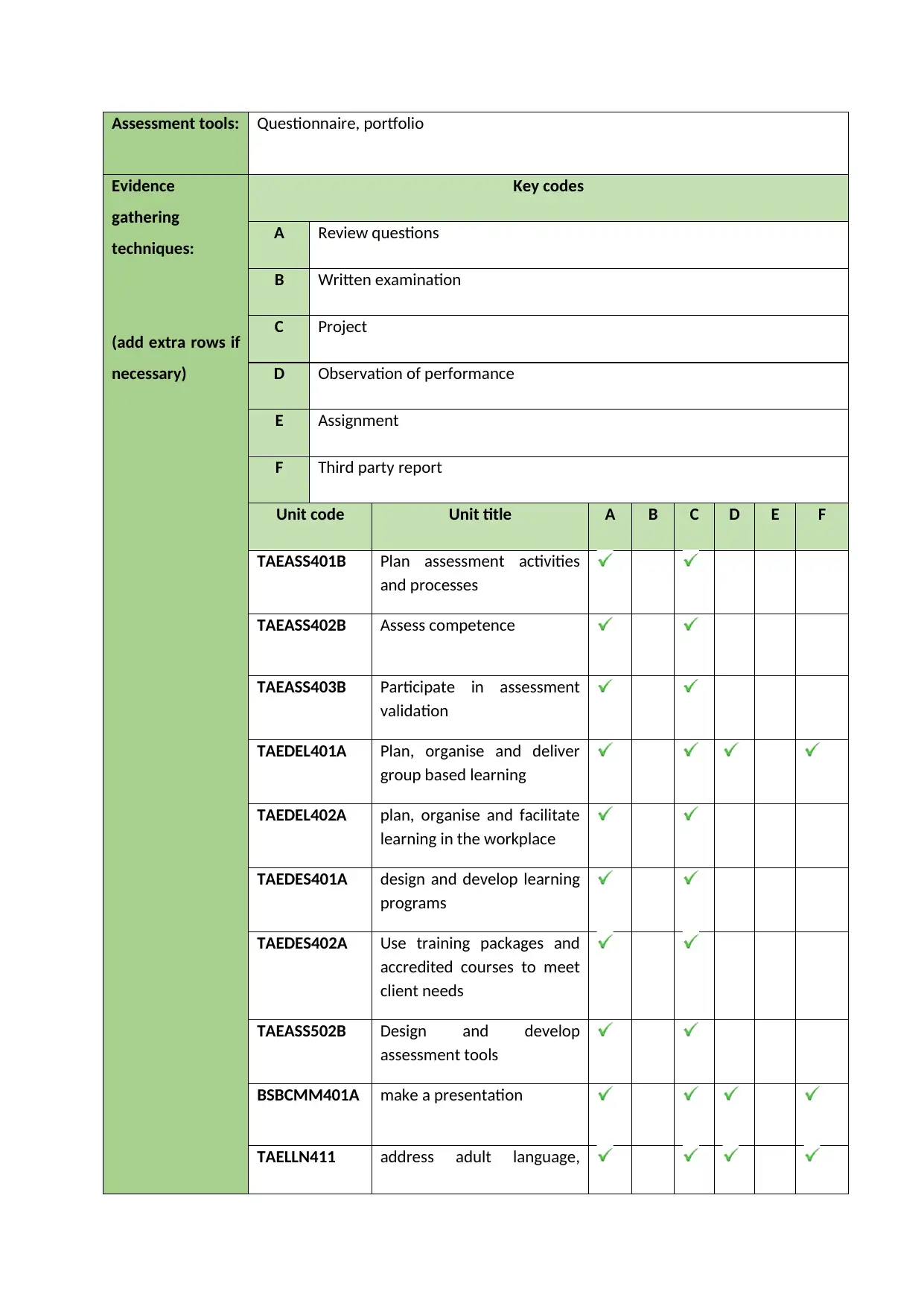
Assessment tools: Questionnaire, portfolio
Evidence
gathering
techniques:
(add extra rows if
necessary)
Key codes
A Review questions
B Written examination
C Project
D Observation of performance
E Assignment
F Third party report
Unit code Unit title A B C D E F
TAEASS401B Plan assessment activities
and processes
TAEASS402B Assess competence
TAEASS403B Participate in assessment
validation
TAEDEL401A Plan, organise and deliver
group based learning
TAEDEL402A plan, organise and facilitate
learning in the workplace
TAEDES401A design and develop learning
programs
TAEDES402A Use training packages and
accredited courses to meet
client needs
TAEASS502B Design and develop
assessment tools
BSBCMM401A make a presentation
TAELLN411 address adult language,
Evidence
gathering
techniques:
(add extra rows if
necessary)
Key codes
A Review questions
B Written examination
C Project
D Observation of performance
E Assignment
F Third party report
Unit code Unit title A B C D E F
TAEASS401B Plan assessment activities
and processes
TAEASS402B Assess competence
TAEASS403B Participate in assessment
validation
TAEDEL401A Plan, organise and deliver
group based learning
TAEDEL402A plan, organise and facilitate
learning in the workplace
TAEDES401A design and develop learning
programs
TAEDES402A Use training packages and
accredited courses to meet
client needs
TAEASS502B Design and develop
assessment tools
BSBCMM401A make a presentation
TAELLN411 address adult language,
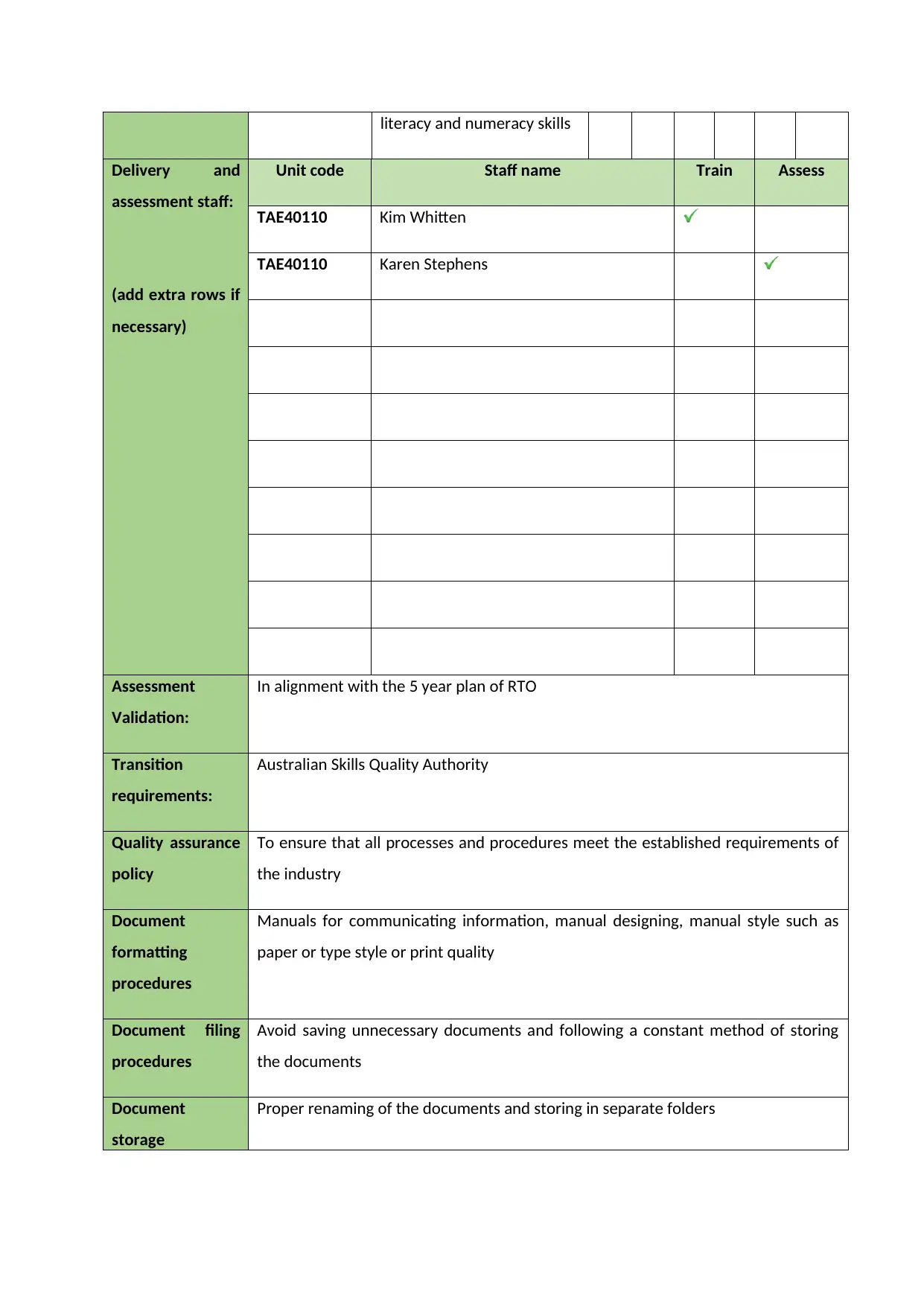
literacy and numeracy skills
Delivery and
assessment staff:
(add extra rows if
necessary)
Unit code Staff name Train Assess
TAE40110 Kim Whitten
TAE40110 Karen Stephens
Assessment
Validation:
In alignment with the 5 year plan of RTO
Transition
requirements:
Australian Skills Quality Authority
Quality assurance
policy
To ensure that all processes and procedures meet the established requirements of
the industry
Document
formatting
procedures
Manuals for communicating information, manual designing, manual style such as
paper or type style or print quality
Document filing
procedures
Avoid saving unnecessary documents and following a constant method of storing
the documents
Document
storage
Proper renaming of the documents and storing in separate folders
Delivery and
assessment staff:
(add extra rows if
necessary)
Unit code Staff name Train Assess
TAE40110 Kim Whitten
TAE40110 Karen Stephens
Assessment
Validation:
In alignment with the 5 year plan of RTO
Transition
requirements:
Australian Skills Quality Authority
Quality assurance
policy
To ensure that all processes and procedures meet the established requirements of
the industry
Document
formatting
procedures
Manuals for communicating information, manual designing, manual style such as
paper or type style or print quality
Document filing
procedures
Avoid saving unnecessary documents and following a constant method of storing
the documents
Document
storage
Proper renaming of the documents and storing in separate folders
Secure Best Marks with AI Grader
Need help grading? Try our AI Grader for instant feedback on your assignments.
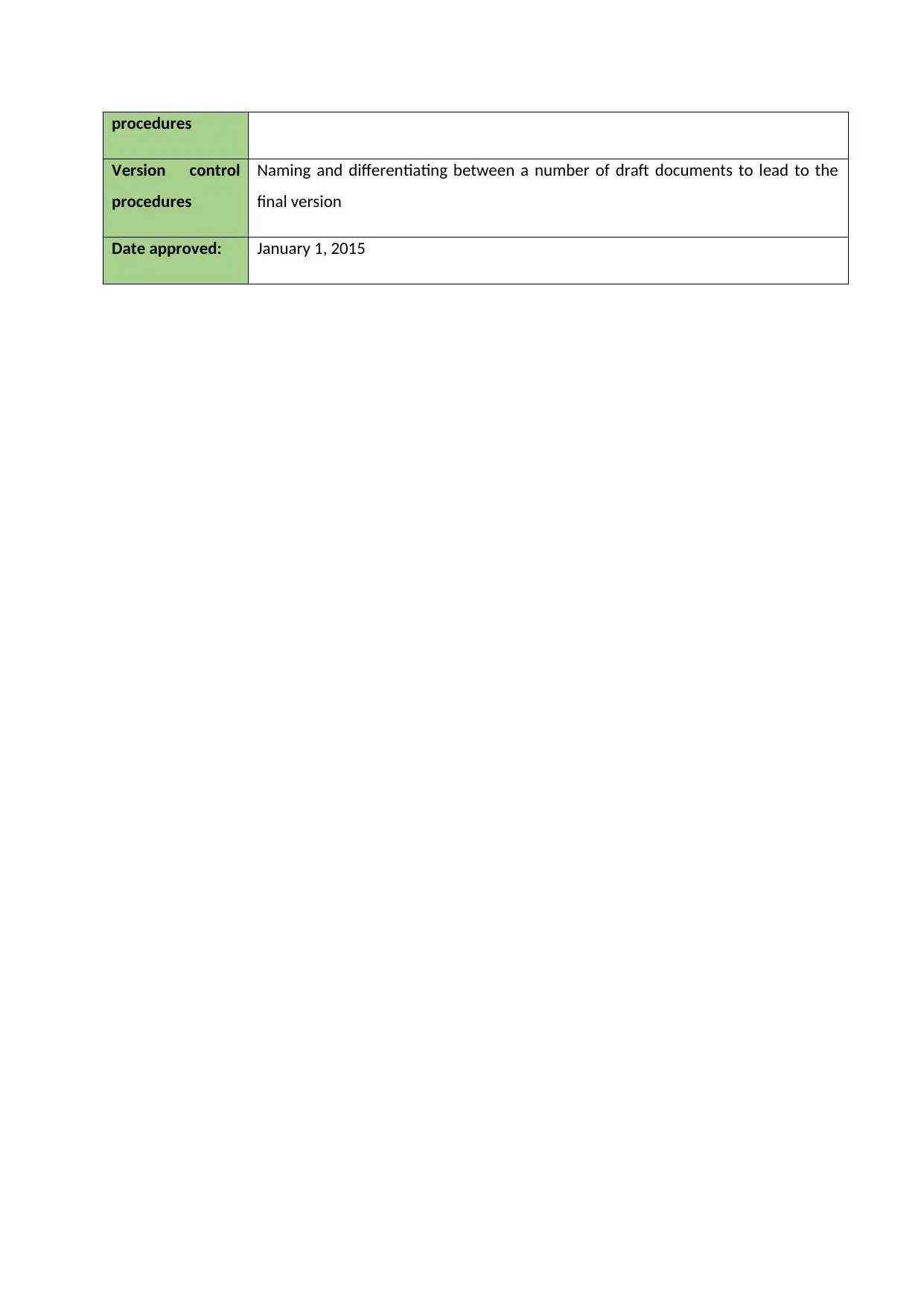
procedures
Version control
procedures
Naming and differentiating between a number of draft documents to lead to the
final version
Date approved: January 1, 2015
Version control
procedures
Naming and differentiating between a number of draft documents to lead to the
final version
Date approved: January 1, 2015
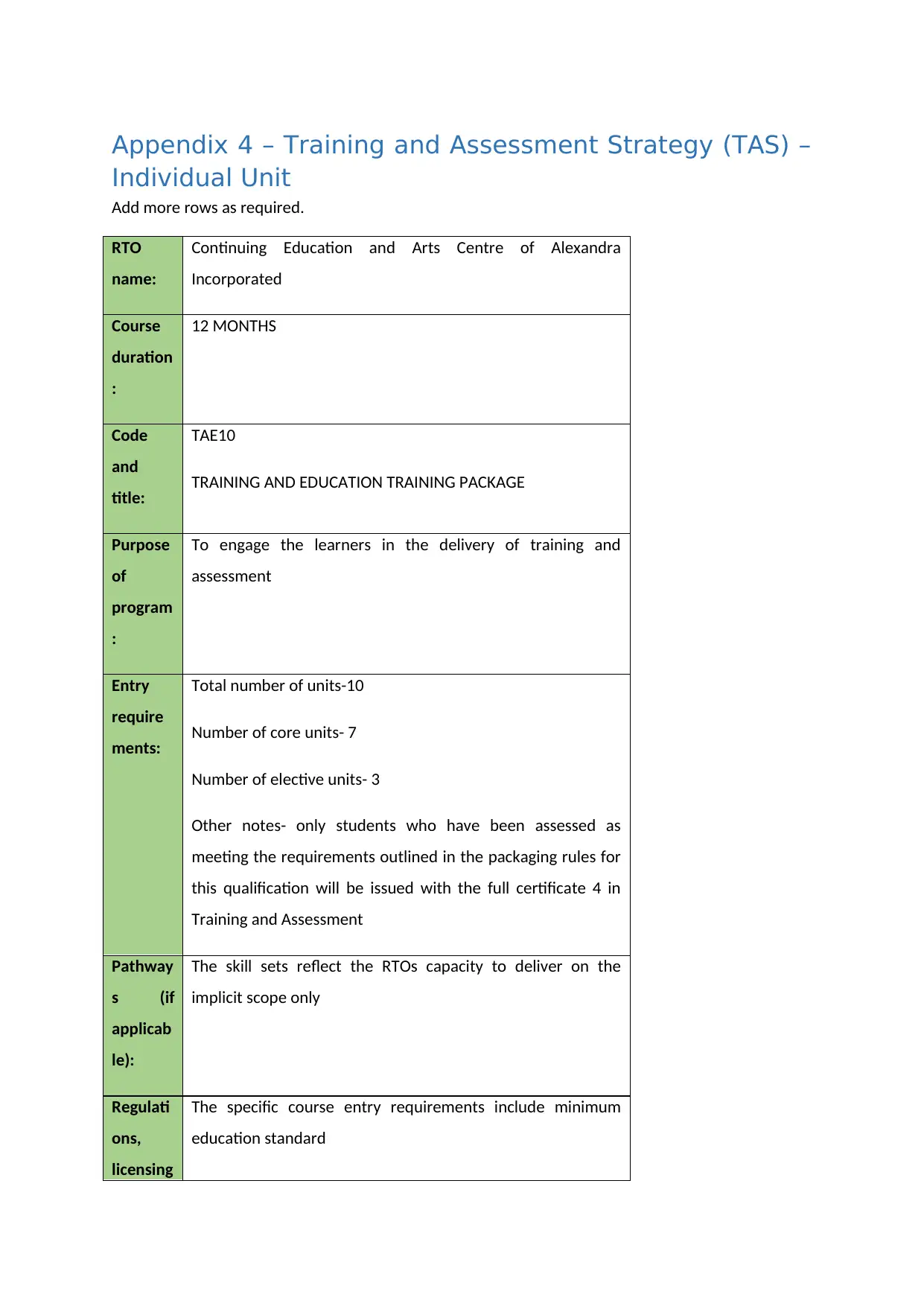
Appendix 4 – Training and Assessment Strategy (TAS) –
Individual Unit
Add more rows as required.
RTO
name:
Continuing Education and Arts Centre of Alexandra
Incorporated
Course
duration
:
12 MONTHS
Code
and
title:
TAE10
TRAINING AND EDUCATION TRAINING PACKAGE
Purpose
of
program
:
To engage the learners in the delivery of training and
assessment
Entry
require
ments:
Total number of units-10
Number of core units- 7
Number of elective units- 3
Other notes- only students who have been assessed as
meeting the requirements outlined in the packaging rules for
this qualification will be issued with the full certificate 4 in
Training and Assessment
Pathway
s (if
applicab
le):
The skill sets reflect the RTOs capacity to deliver on the
implicit scope only
Regulati
ons,
licensing
The specific course entry requirements include minimum
education standard
Individual Unit
Add more rows as required.
RTO
name:
Continuing Education and Arts Centre of Alexandra
Incorporated
Course
duration
:
12 MONTHS
Code
and
title:
TAE10
TRAINING AND EDUCATION TRAINING PACKAGE
Purpose
of
program
:
To engage the learners in the delivery of training and
assessment
Entry
require
ments:
Total number of units-10
Number of core units- 7
Number of elective units- 3
Other notes- only students who have been assessed as
meeting the requirements outlined in the packaging rules for
this qualification will be issued with the full certificate 4 in
Training and Assessment
Pathway
s (if
applicab
le):
The skill sets reflect the RTOs capacity to deliver on the
implicit scope only
Regulati
ons,
licensing
The specific course entry requirements include minimum
education standard
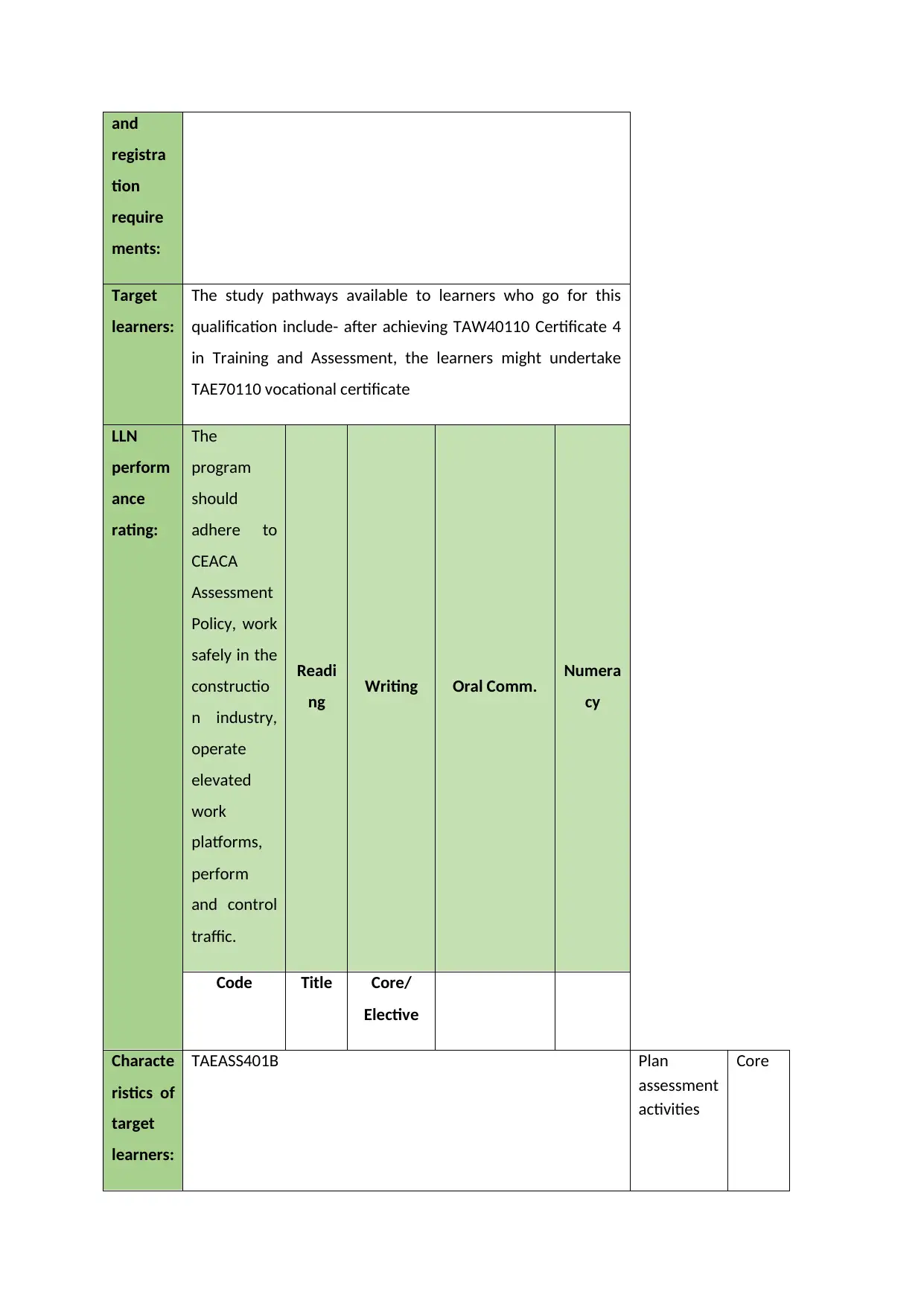
and
registra
tion
require
ments:
Target
learners:
The study pathways available to learners who go for this
qualification include- after achieving TAW40110 Certificate 4
in Training and Assessment, the learners might undertake
TAE70110 vocational certificate
LLN
perform
ance
rating:
The
program
should
adhere to
CEACA
Assessment
Policy, work
safely in the
constructio
n industry,
operate
elevated
work
platforms,
perform
and control
traffic.
Readi
ng Writing Oral Comm. Numera
cy
Code Title Core/
Elective
Characte
ristics of
target
learners:
TAEASS401B Plan
assessment
activities
Core
registra
tion
require
ments:
Target
learners:
The study pathways available to learners who go for this
qualification include- after achieving TAW40110 Certificate 4
in Training and Assessment, the learners might undertake
TAE70110 vocational certificate
LLN
perform
ance
rating:
The
program
should
adhere to
CEACA
Assessment
Policy, work
safely in the
constructio
n industry,
operate
elevated
work
platforms,
perform
and control
traffic.
Readi
ng Writing Oral Comm. Numera
cy
Code Title Core/
Elective
Characte
ristics of
target
learners:
TAEASS401B Plan
assessment
activities
Core
Paraphrase This Document
Need a fresh take? Get an instant paraphrase of this document with our AI Paraphraser
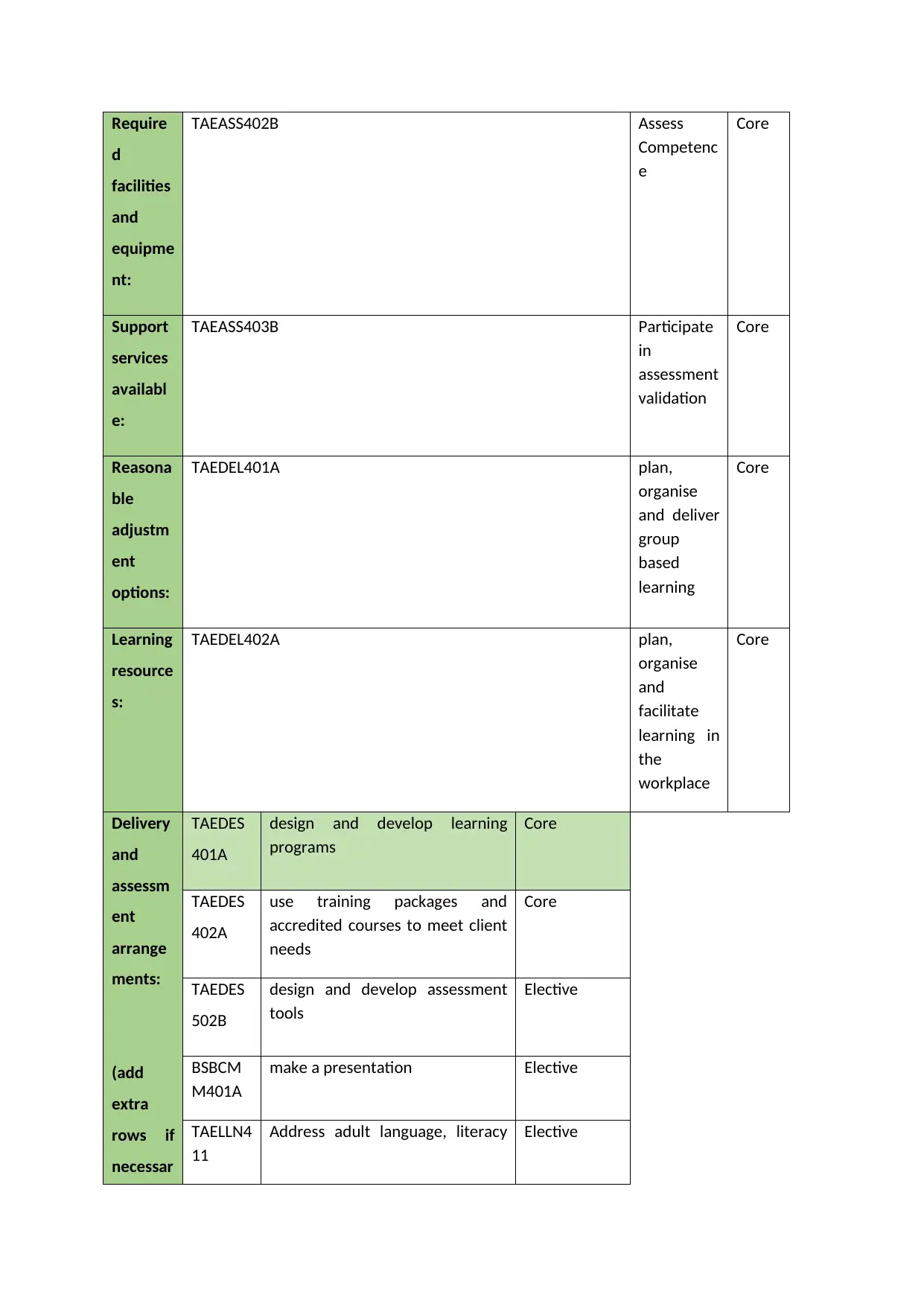
Require
d
facilities
and
equipme
nt:
TAEASS402B Assess
Competenc
e
Core
Support
services
availabl
e:
TAEASS403B Participate
in
assessment
validation
Core
Reasona
ble
adjustm
ent
options:
TAEDEL401A plan,
organise
and deliver
group
based
learning
Core
Learning
resource
s:
TAEDEL402A plan,
organise
and
facilitate
learning in
the
workplace
Core
Delivery
and
assessm
ent
arrange
ments:
(add
extra
rows if
necessar
TAEDES
401A
design and develop learning
programs
Core
TAEDES
402A
use training packages and
accredited courses to meet client
needs
Core
TAEDES
502B
design and develop assessment
tools
Elective
BSBCM
M401A
make a presentation Elective
TAELLN4
11
Address adult language, literacy Elective
d
facilities
and
equipme
nt:
TAEASS402B Assess
Competenc
e
Core
Support
services
availabl
e:
TAEASS403B Participate
in
assessment
validation
Core
Reasona
ble
adjustm
ent
options:
TAEDEL401A plan,
organise
and deliver
group
based
learning
Core
Learning
resource
s:
TAEDEL402A plan,
organise
and
facilitate
learning in
the
workplace
Core
Delivery
and
assessm
ent
arrange
ments:
(add
extra
rows if
necessar
TAEDES
401A
design and develop learning
programs
Core
TAEDES
402A
use training packages and
accredited courses to meet client
needs
Core
TAEDES
502B
design and develop assessment
tools
Elective
BSBCM
M401A
make a presentation Elective
TAELLN4
11
Address adult language, literacy Elective
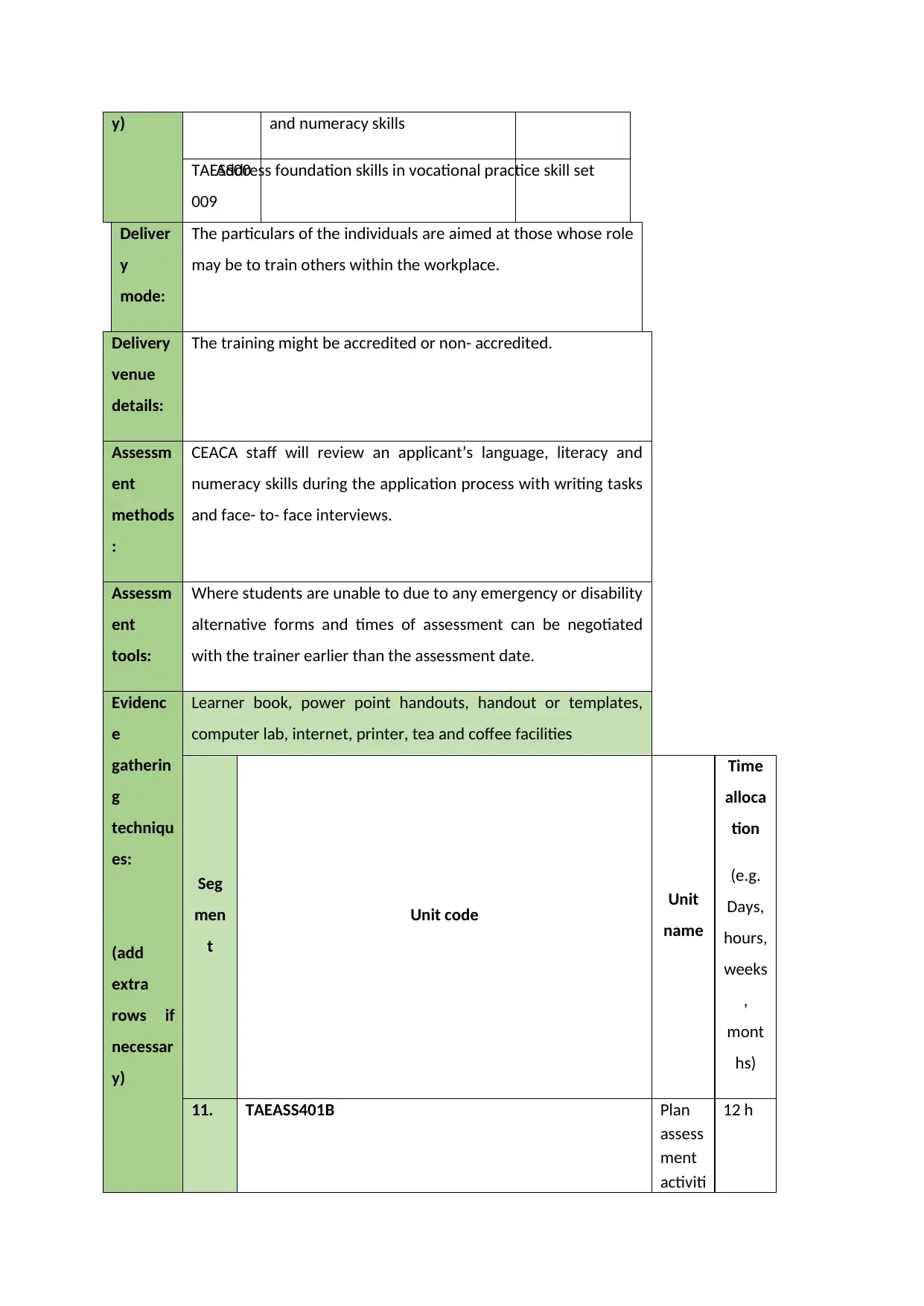
y) and numeracy skills
TAESS00
009
Address foundation skills in vocational practice skill set
Deliver
y
mode:
The particulars of the individuals are aimed at those whose role
may be to train others within the workplace.
Delivery
venue
details:
The training might be accredited or non- accredited.
Assessm
ent
methods
:
CEACA staff will review an applicant’s language, literacy and
numeracy skills during the application process with writing tasks
and face- to- face interviews.
Assessm
ent
tools:
Where students are unable to due to any emergency or disability
alternative forms and times of assessment can be negotiated
with the trainer earlier than the assessment date.
Evidenc
e
gatherin
g
techniqu
es:
(add
extra
rows if
necessar
y)
Learner book, power point handouts, handout or templates,
computer lab, internet, printer, tea and coffee facilities
Seg
men
t
Unit code Unit
name
Time
alloca
tion
(e.g.
Days,
hours,
weeks
,
mont
hs)
11. TAEASS401B Plan
assess
ment
activiti
12 h
TAESS00
009
Address foundation skills in vocational practice skill set
Deliver
y
mode:
The particulars of the individuals are aimed at those whose role
may be to train others within the workplace.
Delivery
venue
details:
The training might be accredited or non- accredited.
Assessm
ent
methods
:
CEACA staff will review an applicant’s language, literacy and
numeracy skills during the application process with writing tasks
and face- to- face interviews.
Assessm
ent
tools:
Where students are unable to due to any emergency or disability
alternative forms and times of assessment can be negotiated
with the trainer earlier than the assessment date.
Evidenc
e
gatherin
g
techniqu
es:
(add
extra
rows if
necessar
y)
Learner book, power point handouts, handout or templates,
computer lab, internet, printer, tea and coffee facilities
Seg
men
t
Unit code Unit
name
Time
alloca
tion
(e.g.
Days,
hours,
weeks
,
mont
hs)
11. TAEASS401B Plan
assess
ment
activiti
12 h
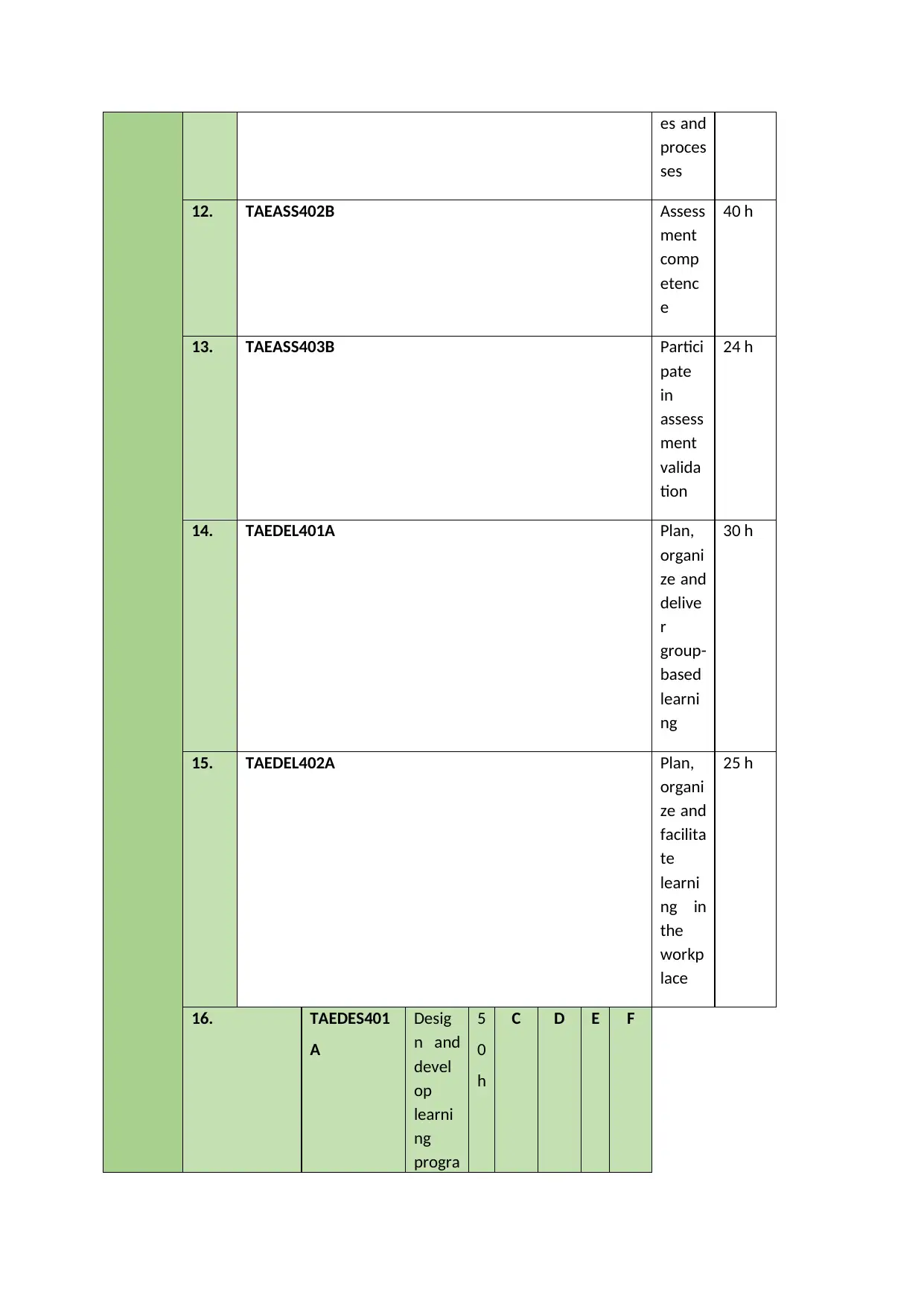
es and
proces
ses
12. TAEASS402B Assess
ment
comp
etenc
e
40 h
13. TAEASS403B Partici
pate
in
assess
ment
valida
tion
24 h
14. TAEDEL401A Plan,
organi
ze and
delive
r
group-
based
learni
ng
30 h
15. TAEDEL402A Plan,
organi
ze and
facilita
te
learni
ng in
the
workp
lace
25 h
16. TAEDES401
A
Desig
n and
devel
op
learni
ng
progra
5
0
h
C D E F
proces
ses
12. TAEASS402B Assess
ment
comp
etenc
e
40 h
13. TAEASS403B Partici
pate
in
assess
ment
valida
tion
24 h
14. TAEDEL401A Plan,
organi
ze and
delive
r
group-
based
learni
ng
30 h
15. TAEDEL402A Plan,
organi
ze and
facilita
te
learni
ng in
the
workp
lace
25 h
16. TAEDES401
A
Desig
n and
devel
op
learni
ng
progra
5
0
h
C D E F
Secure Best Marks with AI Grader
Need help grading? Try our AI Grader for instant feedback on your assignments.
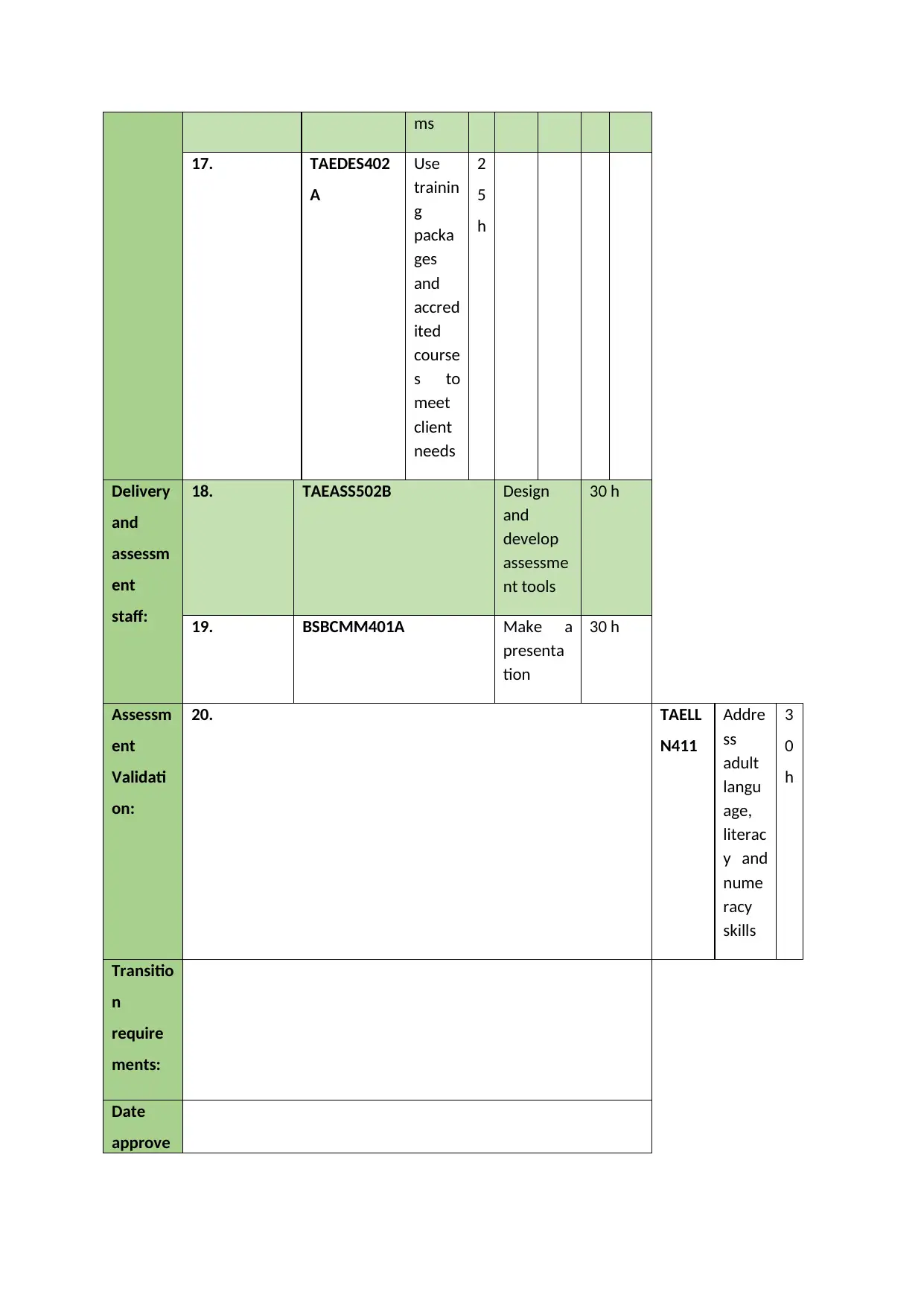
ms
17. TAEDES402
A
Use
trainin
g
packa
ges
and
accred
ited
course
s to
meet
client
needs
2
5
h
Delivery
and
assessm
ent
staff:
18. TAEASS502B Design
and
develop
assessme
nt tools
30 h
19. BSBCMM401A Make a
presenta
tion
30 h
Assessm
ent
Validati
on:
20. TAELL
N411
Addre
ss
adult
langu
age,
literac
y and
nume
racy
skills
3
0
h
Transitio
n
require
ments:
Date
approve
17. TAEDES402
A
Use
trainin
g
packa
ges
and
accred
ited
course
s to
meet
client
needs
2
5
h
Delivery
and
assessm
ent
staff:
18. TAEASS502B Design
and
develop
assessme
nt tools
30 h
19. BSBCMM401A Make a
presenta
tion
30 h
Assessm
ent
Validati
on:
20. TAELL
N411
Addre
ss
adult
langu
age,
literac
y and
nume
racy
skills
3
0
h
Transitio
n
require
ments:
Date
approve

d:
Sufficiency, authenticity, currency, validity
Sufficiency, authenticity, currency, validity

Appendix 5 – Language, Literacy, and Numeracy Matrix
Instructions:
1. Insert the codes of all the units in the “Unit Code” column.
2. Add or delete rows as required.
3. Research the units of competency on www.training.gov.au and locate the “Foundation Skills”
section. If the units of competency you select do not have a complete Foundation Skills table,
you must refer to the performance criteria.
4. Use the following information to determine the LLN performance rating for each skill:
Descriptions of the foundation skills and/or performance criteria
The AQF level of the qualification you have selected
Your professional experience and opinion
5. Identify the highest number in each column. This will form the minimum LLN requirements of
your learning program.
Performance ratings are on a scale from 1 (low level skills required) to 5 (high level skills required). If
a LLN core skill is not relevant, simply insert a ‘–‘ symbol.
Whilst the LLN performance ratings and the AQF levels of qualifications do not match up directly,
they can be used as a starting guide for what performance level is required in each unit. Please note
that this will not always be the case. For example, the numeracy requirements in UEE30811
Certificate III in Electrotechnology Electrician might equate to an LLN performance level of 5, but
other core skills will be much lower. It ultimately depends on the units of competency you select
within the specified qualification.
Please note: identifying LLN core skills will be covered in greater detail in TAELLN411 Address adult
language, literacy, and numeracy skills. The purpose of completing this appendix is to provide a
general estimate of the minimum LLN skill requirements. There are no right or wrong answers;
however extreme cases of inconsistency may require a review.
Instructions:
1. Insert the codes of all the units in the “Unit Code” column.
2. Add or delete rows as required.
3. Research the units of competency on www.training.gov.au and locate the “Foundation Skills”
section. If the units of competency you select do not have a complete Foundation Skills table,
you must refer to the performance criteria.
4. Use the following information to determine the LLN performance rating for each skill:
Descriptions of the foundation skills and/or performance criteria
The AQF level of the qualification you have selected
Your professional experience and opinion
5. Identify the highest number in each column. This will form the minimum LLN requirements of
your learning program.
Performance ratings are on a scale from 1 (low level skills required) to 5 (high level skills required). If
a LLN core skill is not relevant, simply insert a ‘–‘ symbol.
Whilst the LLN performance ratings and the AQF levels of qualifications do not match up directly,
they can be used as a starting guide for what performance level is required in each unit. Please note
that this will not always be the case. For example, the numeracy requirements in UEE30811
Certificate III in Electrotechnology Electrician might equate to an LLN performance level of 5, but
other core skills will be much lower. It ultimately depends on the units of competency you select
within the specified qualification.
Please note: identifying LLN core skills will be covered in greater detail in TAELLN411 Address adult
language, literacy, and numeracy skills. The purpose of completing this appendix is to provide a
general estimate of the minimum LLN skill requirements. There are no right or wrong answers;
however extreme cases of inconsistency may require a review.
Paraphrase This Document
Need a fresh take? Get an instant paraphrase of this document with our AI Paraphraser
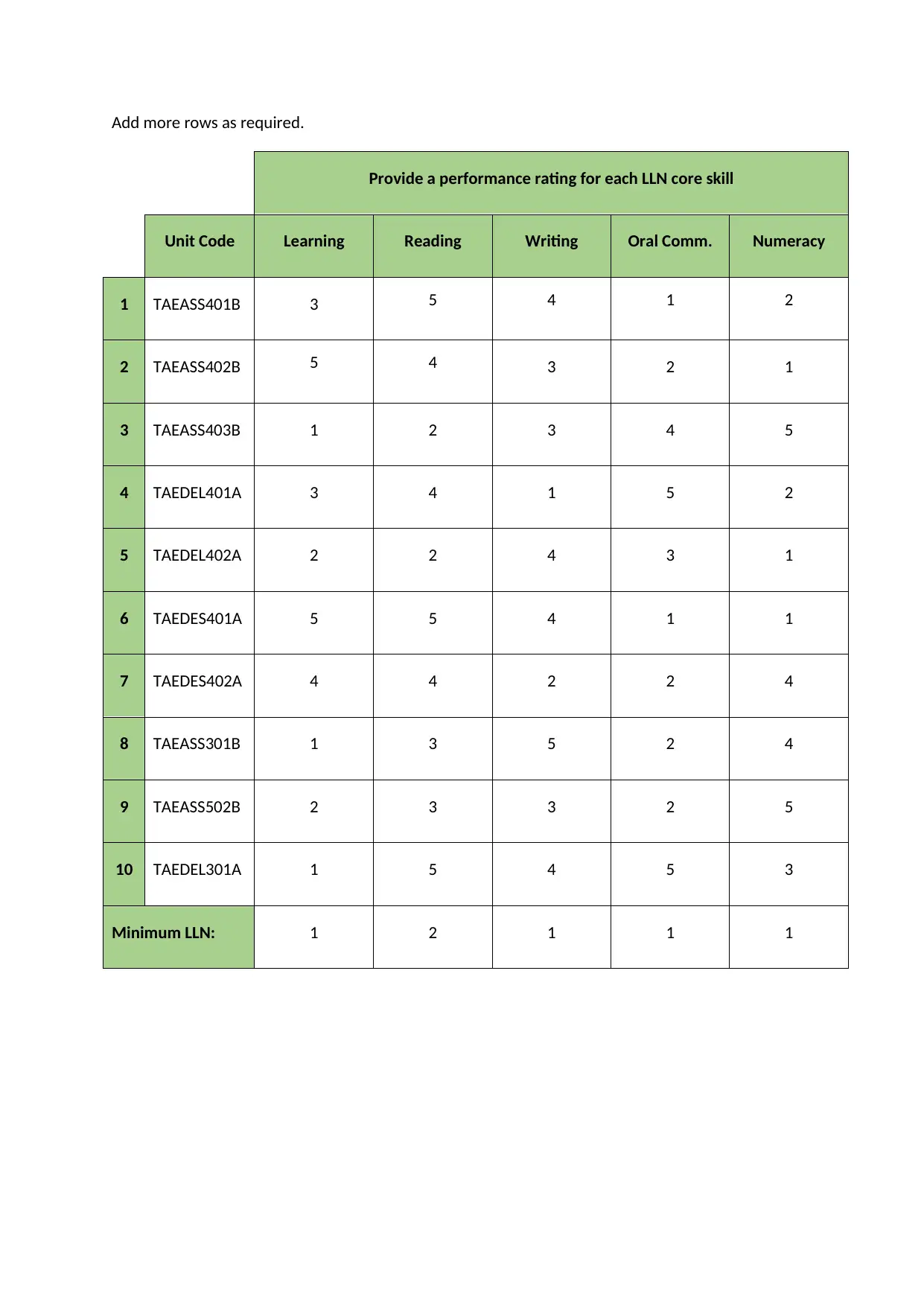
Add more rows as required.
Provide a performance rating for each LLN core skill
Unit Code Learning Reading Writing Oral Comm. Numeracy
1 TAEASS401B 3 5 4 1 2
2 TAEASS402B 5 4 3 2 1
3 TAEASS403B 1 2 3 4 5
4 TAEDEL401A 3 4 1 5 2
5 TAEDEL402A 2 2 4 3 1
6 TAEDES401A 5 5 4 1 1
7 TAEDES402A 4 4 2 2 4
8 TAEASS301B 1 3 5 2 4
9 TAEASS502B 2 3 3 2 5
10 TAEDEL301A 1 5 4 5 3
Minimum LLN: 1 2 1 1 1
Provide a performance rating for each LLN core skill
Unit Code Learning Reading Writing Oral Comm. Numeracy
1 TAEASS401B 3 5 4 1 2
2 TAEASS402B 5 4 3 2 1
3 TAEASS403B 1 2 3 4 5
4 TAEDEL401A 3 4 1 5 2
5 TAEDEL402A 2 2 4 3 1
6 TAEDES401A 5 5 4 1 1
7 TAEDES402A 4 4 2 2 4
8 TAEASS301B 1 3 5 2 4
9 TAEASS502B 2 3 3 2 5
10 TAEDEL301A 1 5 4 5 3
Minimum LLN: 1 2 1 1 1
1 out of 50
Related Documents
Your All-in-One AI-Powered Toolkit for Academic Success.
+13062052269
info@desklib.com
Available 24*7 on WhatsApp / Email
![[object Object]](/_next/static/media/star-bottom.7253800d.svg)
Unlock your academic potential
© 2024 | Zucol Services PVT LTD | All rights reserved.




